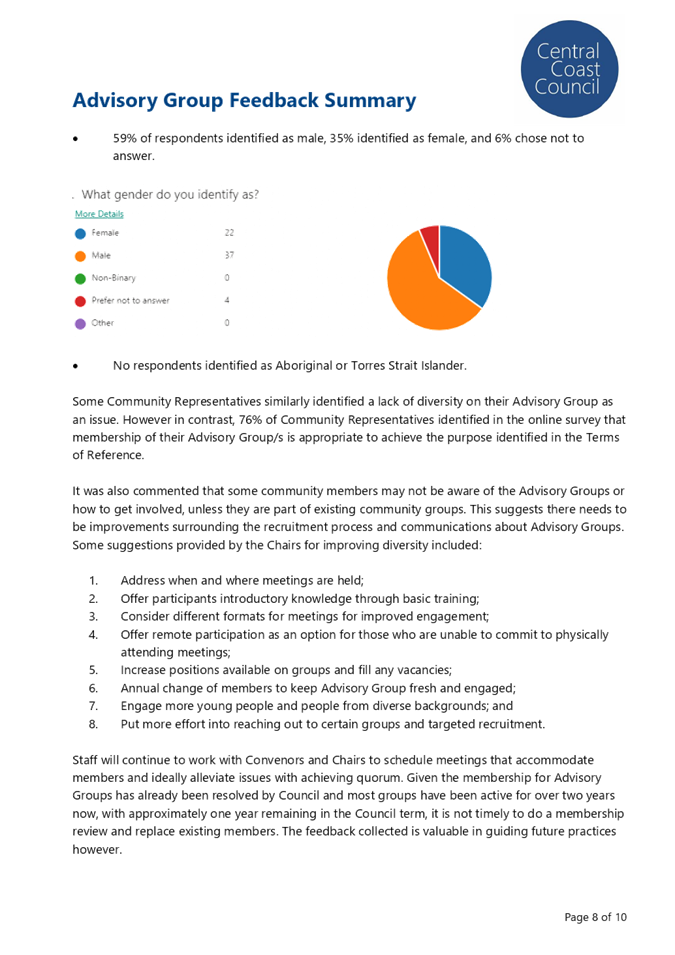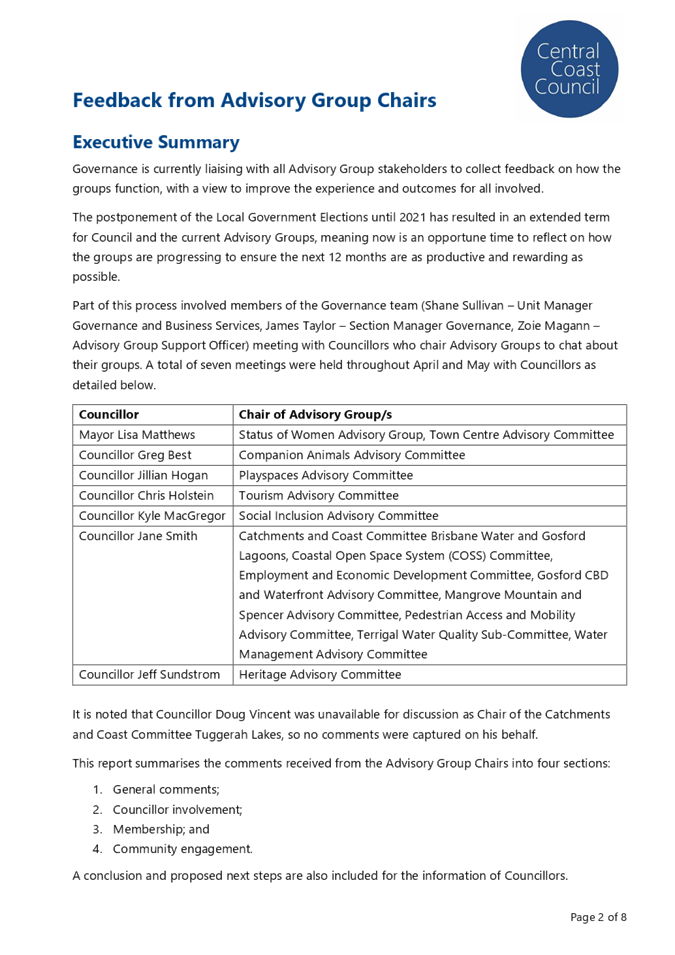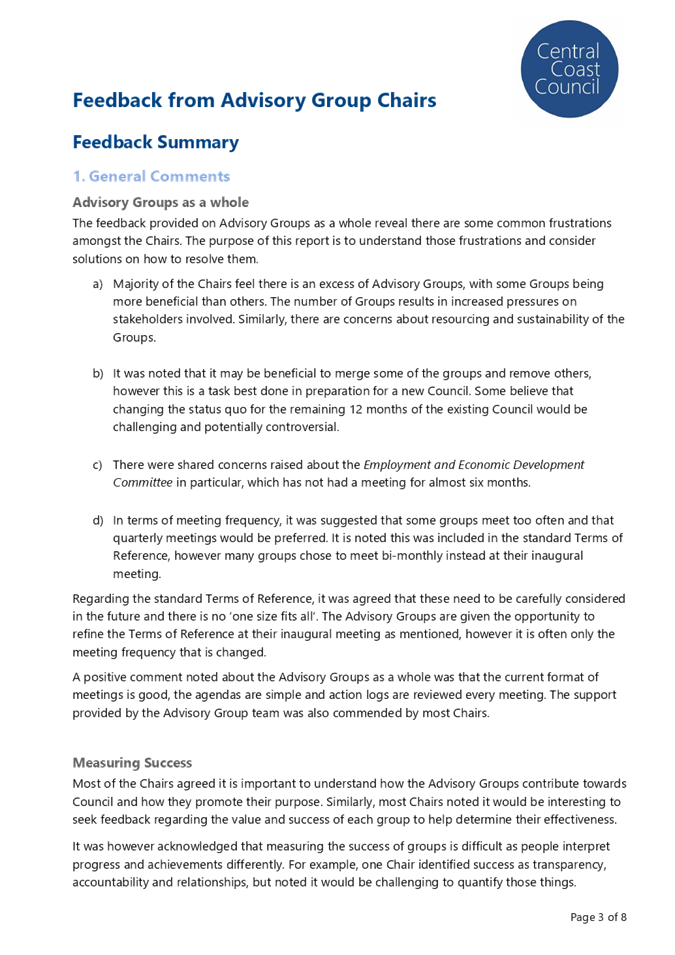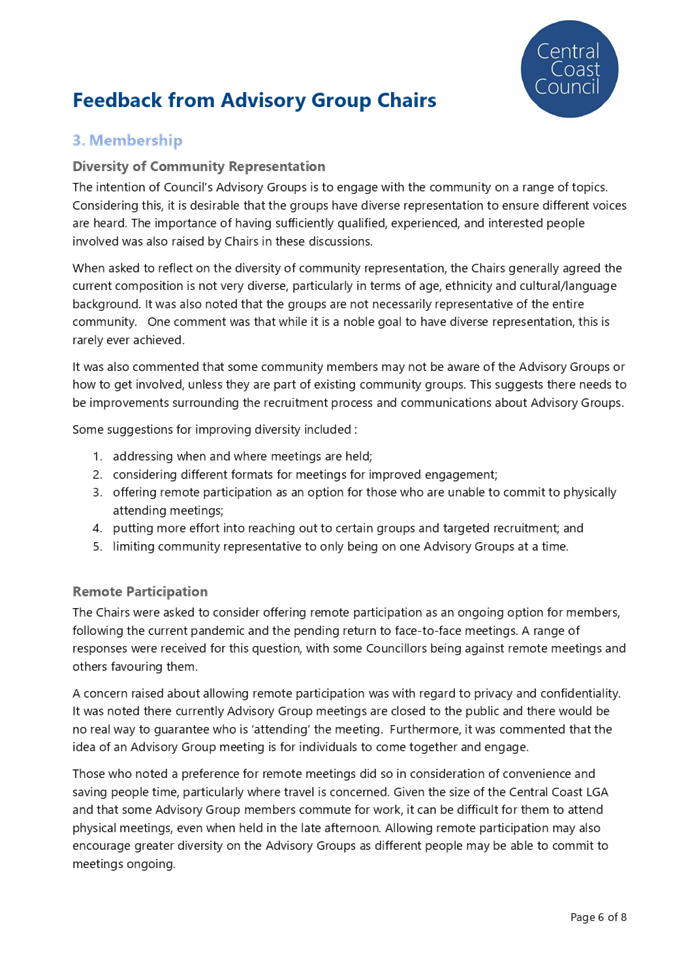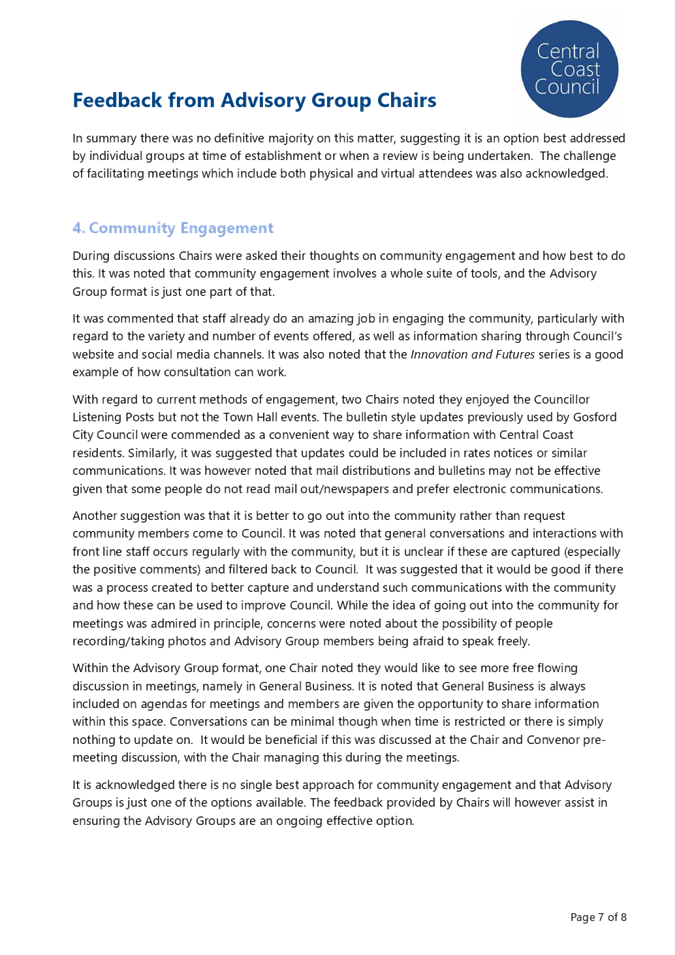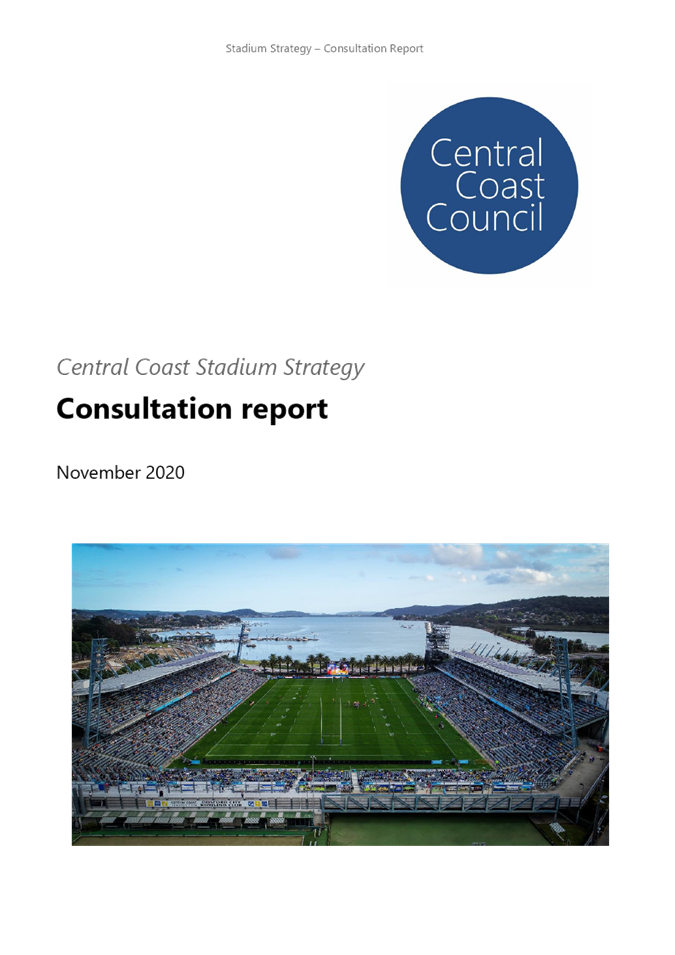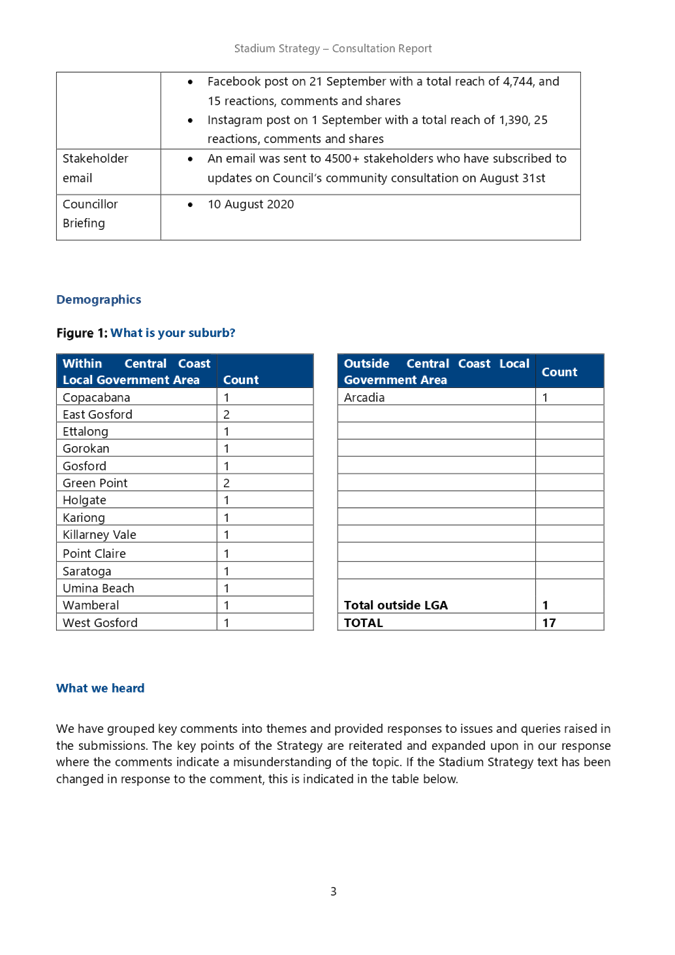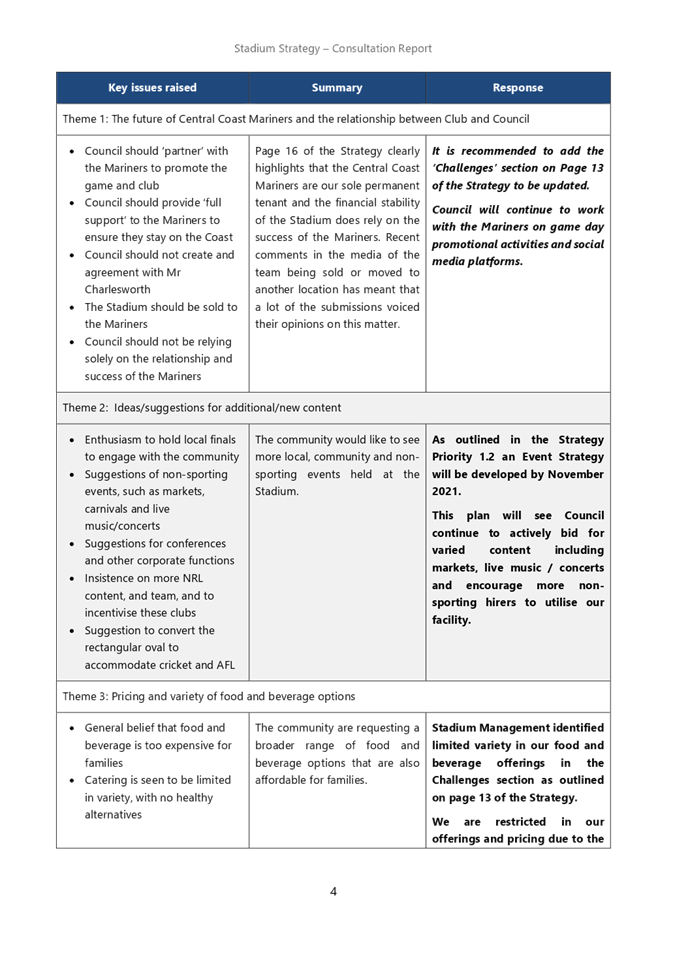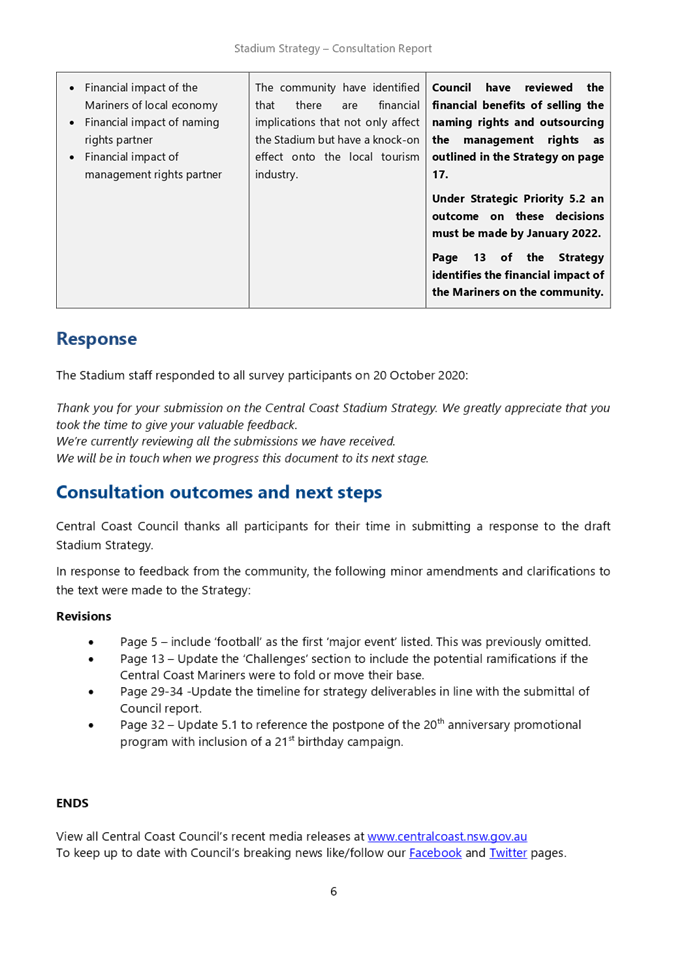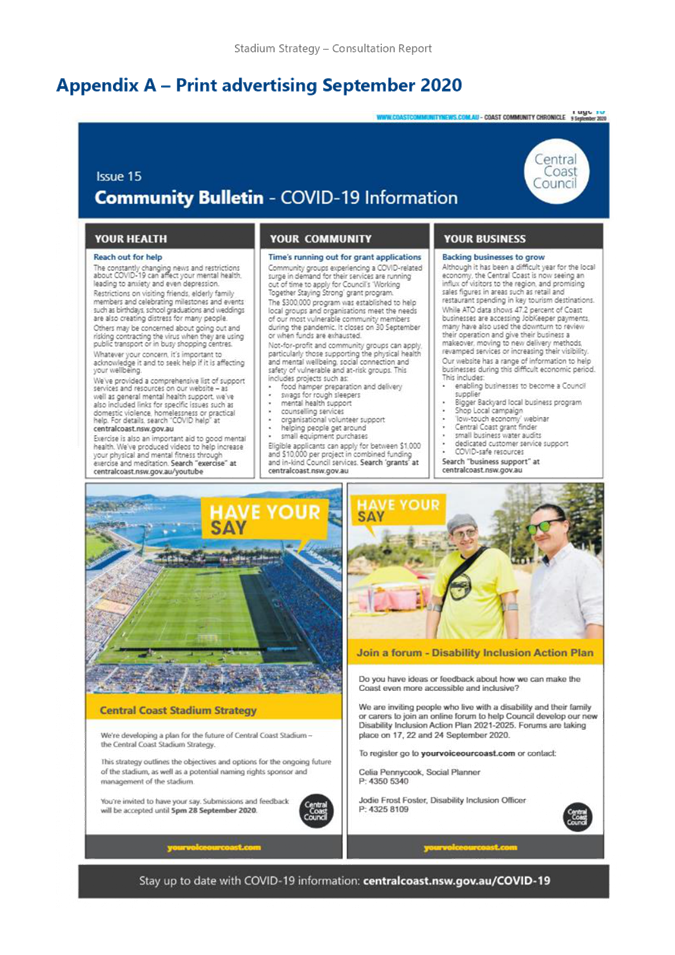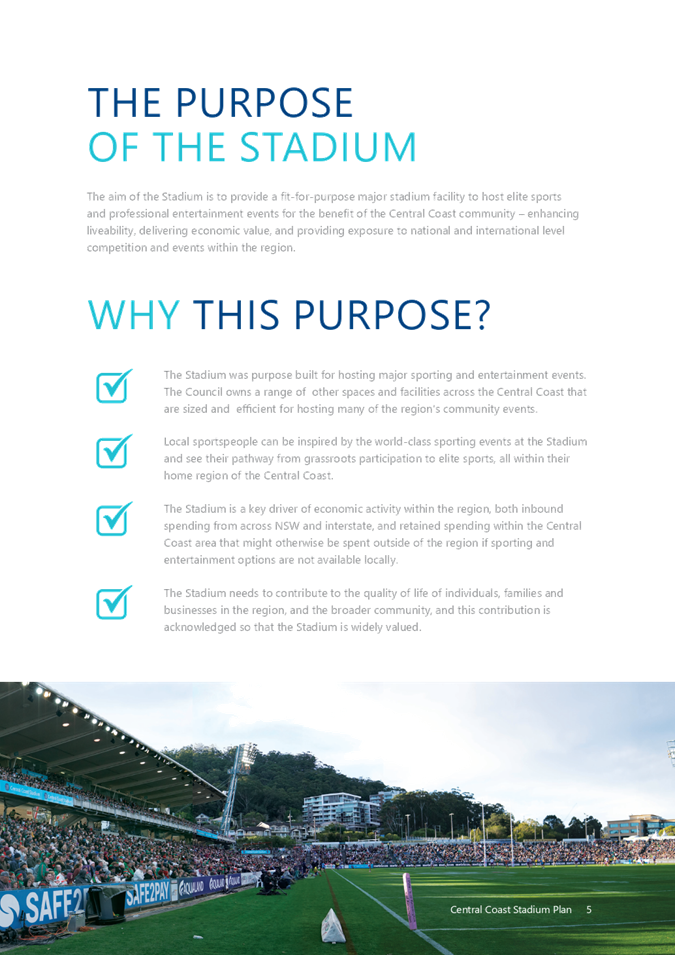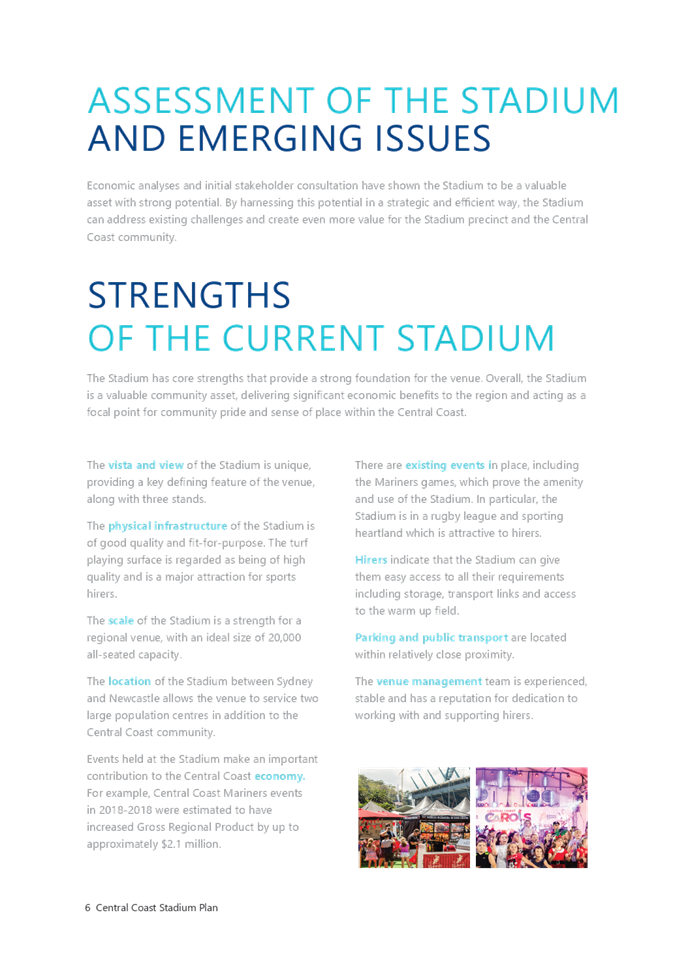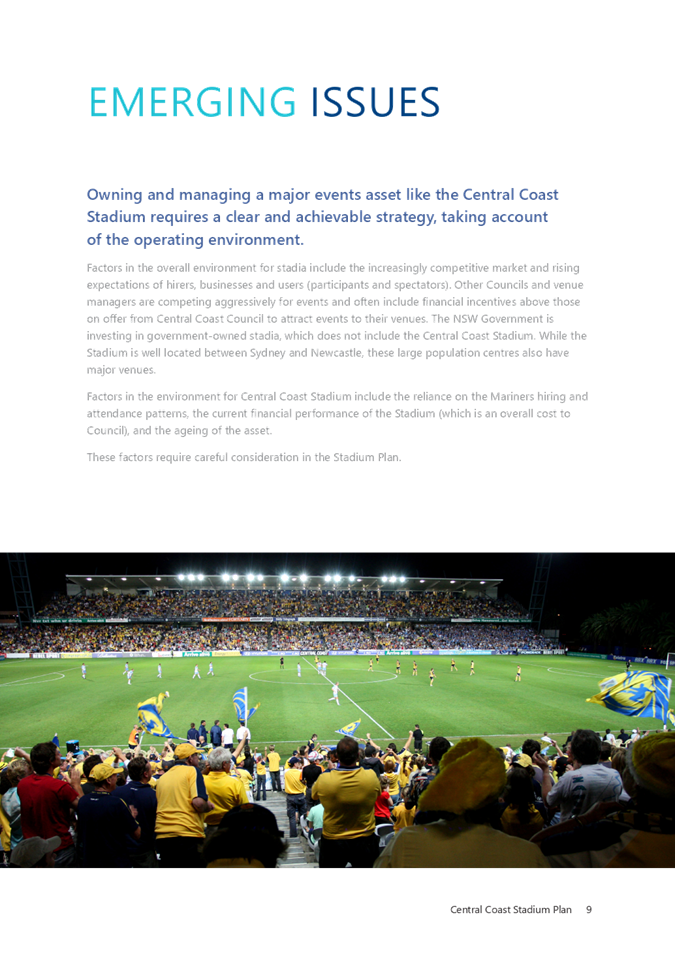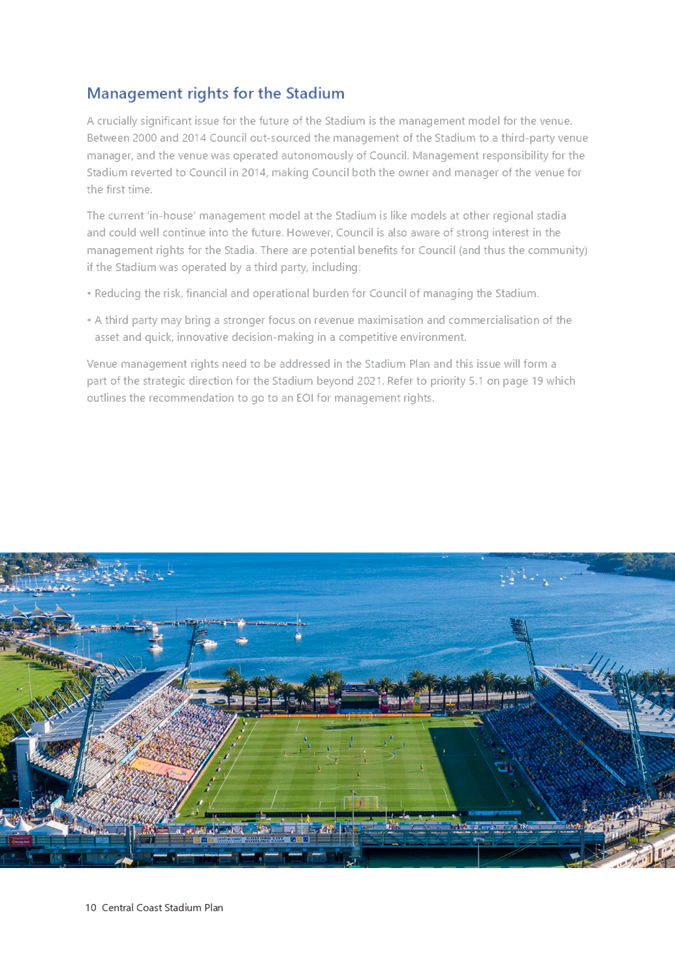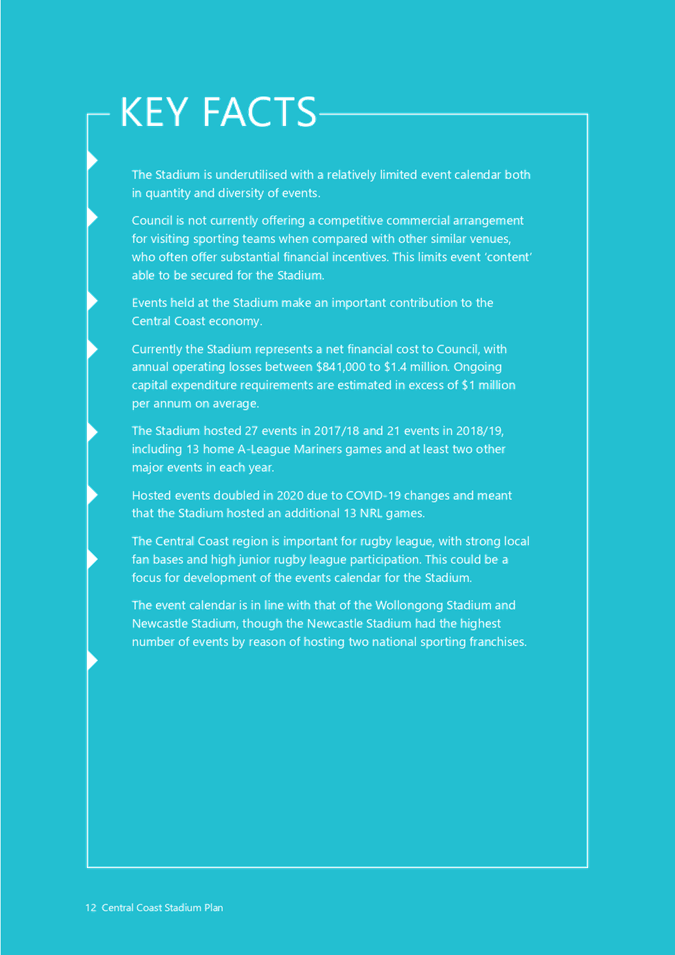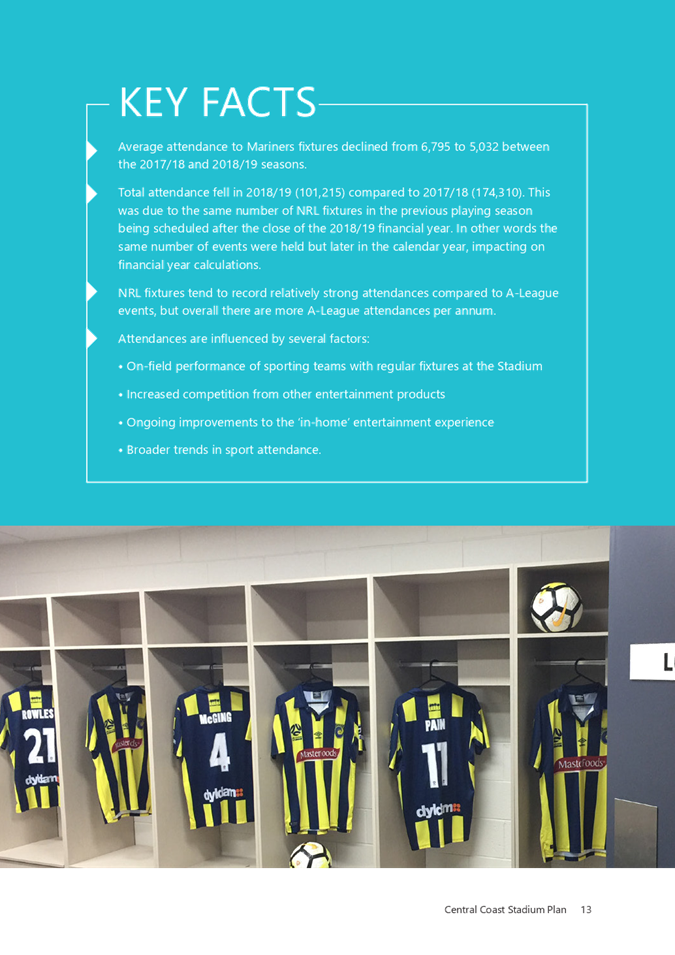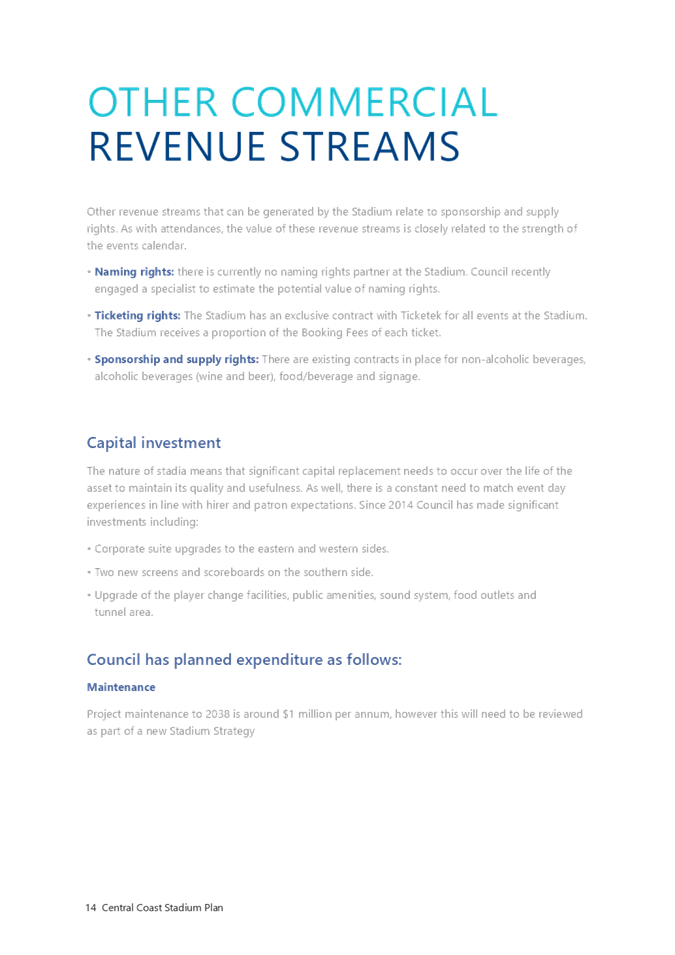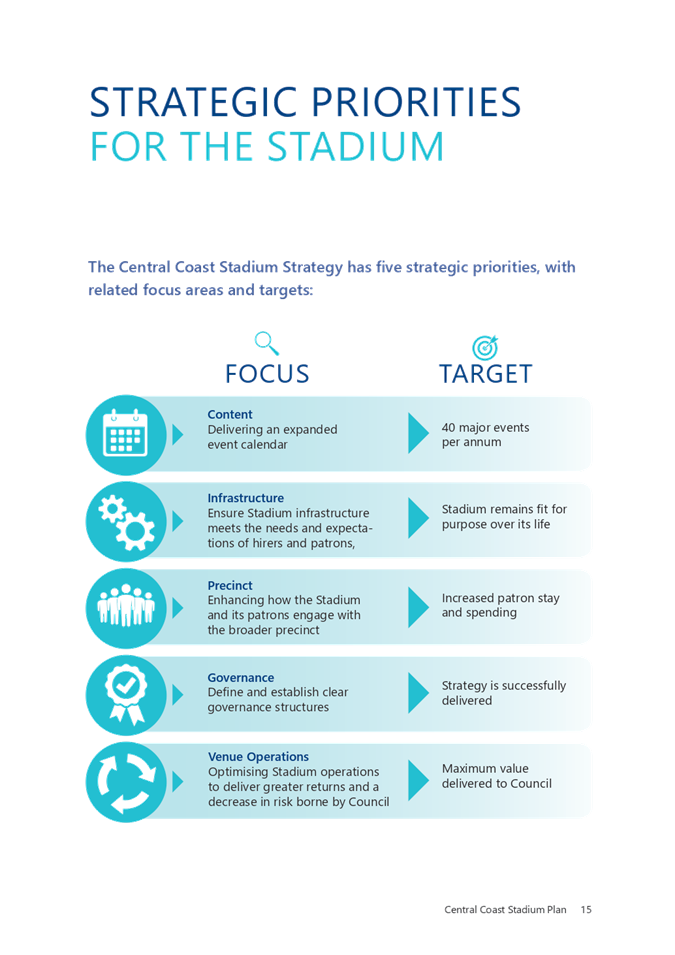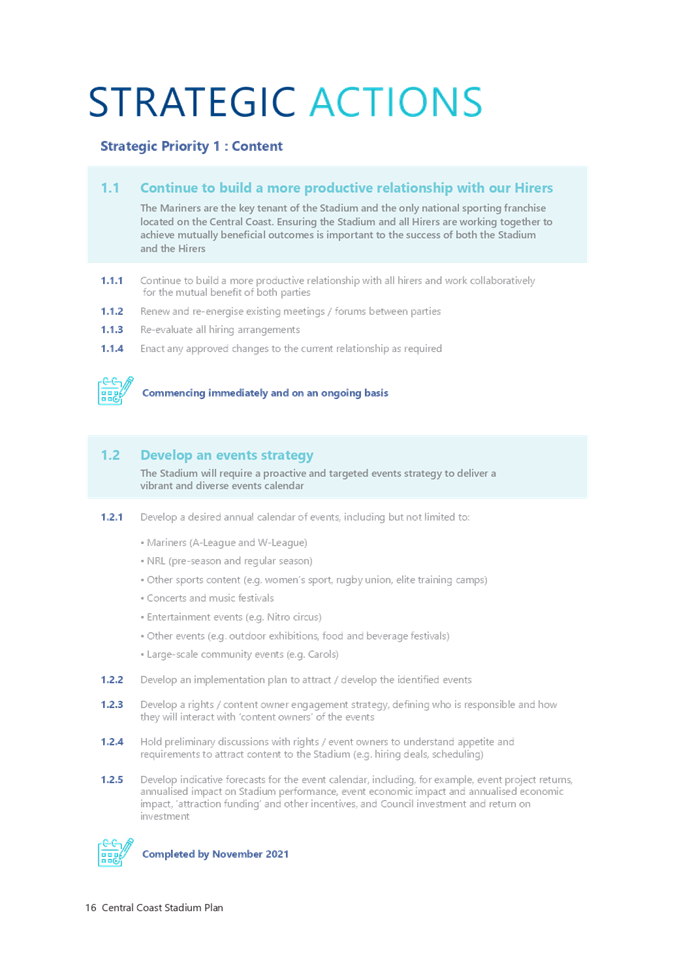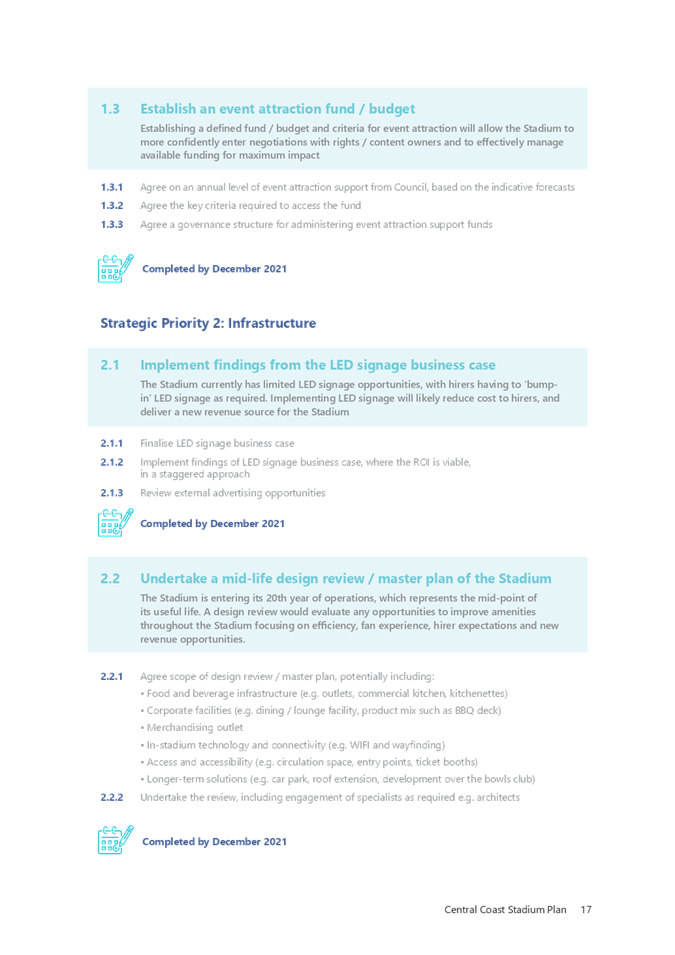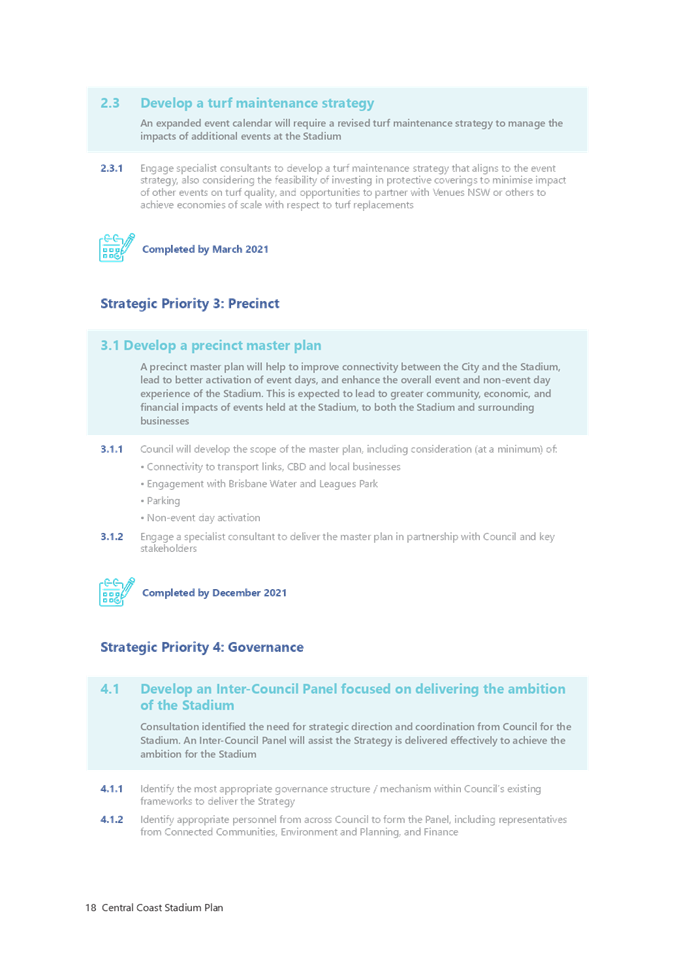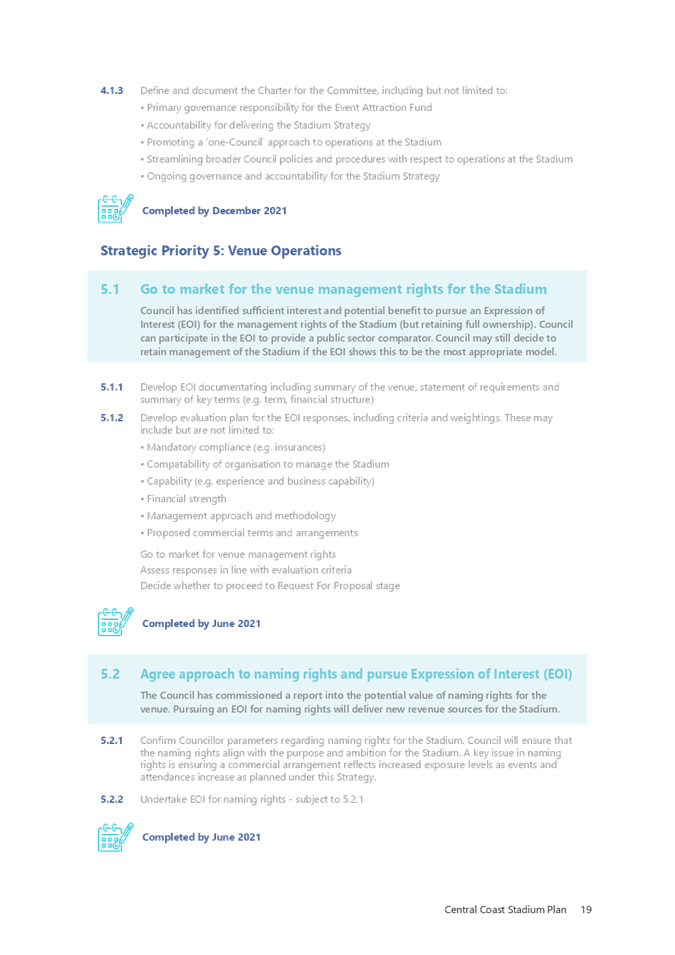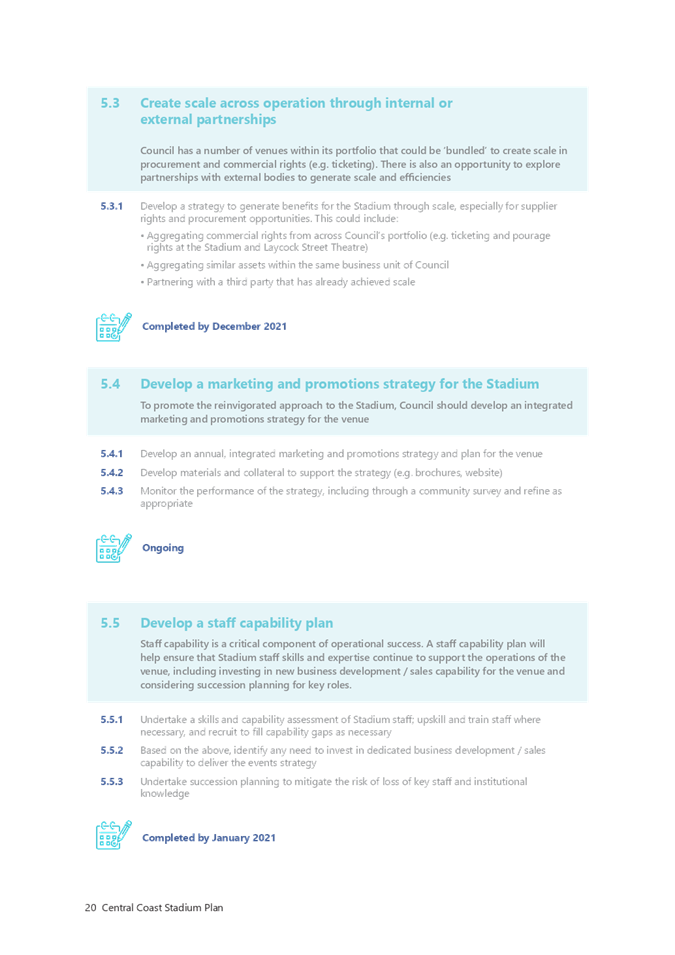Central
Coast Council
Ordinary Council Meeting
ATTACHMENTS PROVIDED UNDER SEPARATE COVER
Tuesday,
23 March, 2021
Ordinary Council Meeting
23 March 2021
Central
Coast Council
Attachments
provided under separate cover to the
Ordinary
Council Meeting
to
be held in the Council Chamber,
Level
1, 49 Mann Street, Gosford
on Tuesday, 23 March
2021,
commencing
at 6.30pm
Procedural
Items
1.2 Confirmation
of Minutes of Previous Meeting
Attachment
1: Minutes
- Ordinary Meeting - 9 March 2021............................................... 4
Chief
Executive Officer’s Reports
2.1 Central
Coast Council Financial Plan
Attachment
1: Central
Coast Council Financial Plan.............................................................. 11
Corporate
Affairs Reports
3.1 Consideration
of Submissions and Adoption of the Long Term Financial Plan and Debt Recovery
and Hardship Policy
Attachment
1: Summary
of Submissions for Revised LTFP and Draft Debt Recovery and Hardship Policy............................................................................................... 14
Attachment
2: Long
Term Financial Plan..................................................................................... 17
Attachment
3: Debt
Recovery and Hardship Policy............................................................... 18
3.2 Investment
Report for February 2021
Attachment
1: Summary
of Investments as at 28 February 2021................................... 26
Attachment
2: Summary
of Restrictions as at 28 February 2021.................................... 28
Attachment
3: Investment
Report for February 2021- Graph 1, 2 and 3.................... 29
Attachment
4: Treasury
Direct Trading Limit Report February 2021............................ 32
Attachment
5: Treasury
Direct Portfolio Valuation Report February 2021................ 39
3.4 Draft
2019-20 Financial Reports for Central Coast Council and Central Coast Council
Water Supply Authority
Attachment
1: Central
Coast Council Draft 2019-20 Consolidated Financial Statements 46
Attachment
2: Central
Coast Council Water Supply Authority Draft 2019-20 Financial Statements............................................................................................................... 185
Attachment
3: OLG
letter to Central Coast Acting CEO approving extension...... 243
3.5 Councillor
and Staff Interaction Policy
Attachment
1: Councillor
and Staff Interaction Policy - March 2021......................... 250
3.6 Proposed
Changes to Advisory Groups and Committees
Attachment
1: Changes
in Advisory Group Format............................................................ 265
Attachment
2: Advisory
Group Feedback Summary........................................................... 267
3.7 Waterfront
Addressing
Attachment
1: Waterfront
Addressing Overview Map...................................................... 284
3.9 Central
Coast Stadium Final Strategy Report
Attachment
1: Central
Coast Stadium Strategy - Consultation Report..................... 285
Attachment
2: Central
Coast Stadium Implementation Plan 2021............................ 286
3.10 Response
to Administrator's Minute - Beach Parking
Attachment
1: Visitor
Based Beach Paid Parking System Business Case Current 315
Attachment
2: Part
3 - Holiday Period Coastal Parking demands............................... 326
|
1.2
|
Confirmation of Minutes of Previous
Meeting
|
|
Attachment 1
|
Minutes
- Ordinary Meeting - 9 March 2021
|
 Central
Coast Council
Central
Coast Council
Ordinary Council
Meeting
Held in the Council
Chamber
2 Hely Street, Wyong
9 March 2021
MINUTES
Present
Dick Persson
AM
In
Attendance
Rik Hart Acting
Chief Executive Officer
Malcolm Ryan Chief
Operating Officer
Natalia
Cowley Acting
Director Corporate Affairs
Boris
Bolgoff Director
Infrastructure Services
Julie
Vaughan Director
Connected and Recreation Communities
Scott Cox Director
Environment and Planning
Daniel Kemp Acting
Director Water and Sewer
Notes
The
Administrator, Dick Persson AM, declared the meeting open at 6.28pm and advised
in accordance with the Code of Meeting Practice that the meeting is being
recorded.
The Administrator,
Dick Persson AM acknowledged the traditional custodians of the land on which
the meeting was being held, and paid respect to Elders past, present and
emerging.
The
Administrator, Dick Persson AM adjourned the meeting at 6.29pm and advised the
meeting would resume following the conduct of the Open Forum.
The Open
Forum commenced at 6.29pm with the speakers addressing the Council on each of
the subjects below;
· Chantelle Baistow - Popular vote on de-amalgamation
· Wolfgang Koerner - Referendum questions
· Sue
Bradley - Sustainable Community Garden known as SWAMP
· Grahame Crough - Sustainable
Community Garden known as SWAMP
The Open
Forum closed with the Ordinary Meeting resuming at 6.50pm.
1.1 Disclosures
of Interest
|
|
Time
commenced: 6.51pm
|
|
Moved: Mr
Persson AM
51/21 Resolved
That
Administrator and staff now disclose any conflicts of interest in matters
under consideration by Council at this meeting.
|
1.2 Confirmation
of Minutes of Previous Meeting
|
|
Time
commenced: 6.51pm
|
|
Moved: Mr
Persson AM
52/21 Resolved
That
Council confirm minutes of the Ordinary Meeting of Council held on
23 February 2021 and of the Extraordinary Meeting of Council held on 25
February 2021.
|
1.3 Notice
of Intention to Deal with Matters in Confidential Session
|
|
Time
commenced: 6.51pm
|
|
Moved: Mr
Persson AM
53/21 Resolved
That Council receive the report and note that no matters have
been tabled to deal with in a closed session.
|
2.1 Request
for Memorial Plaque
|
|
Time
commenced: 6.52pm
|
|
Moved: Mr
Persson AM
54/21 Resolved
That
Council approve the application by Mrs Dowling for a memorial plaque to be
installed in memory of her late husband, Mr Robert Dowling.
|
3.2 Adoption
of Lobbying Policy
|
|
Time
commenced: 6.53pm
|
|
Moved: Mr
Persson AM
56/21 Resolved
1 That
the draft Lobbying Policy that is Attachment 1 to this report be adopted.
2 That Council write to
the submission maker thanking them for their submission and notifying them of
the outcome.
|
3.3 Adoption
of Draft Code of Meeting Practice for the purpose of public exhibition
|
|
Time
commenced: 6.54pm
Mr
Lachlan Smith,
addressed the meeting at 6.55pm.
|
|
Moved: Mr
Persson AM
57/21 Resolved
1 That
in accordance with section 361 of the Local Government Act that a draft Code
of Meeting Practice as attached be placed on public exhibition for a period
of not less than 28 days, with submissions accepted for a period of not less
than 42 days with the following amendment:
- Removal
of provision for the conduct of Council Meetings at Gosford Administration
Building
2 That
in accordance with section 362 of the Local Government Act a further report
be provided to Council following the conduct of the public exhibition period
as a late report to the Council Meeting of 27 April 2021.
3 That
commencing as soon as administratively practicable, the Agenda Paper for
Council Meetings be distributed by 5pm three business days before the meeting
and that the impacts of this process be reported to Council as part of the
consideration of submissions.
|
3.4 Meeting
Record of the Tourism Advisory Committee Meeting held 15 December 2020
|
|
Time
commenced: 7.04pm
|
|
Moved: Mr
Persson AM
58/21 Resolved
That
Council endorse the Tourism Advisory Committee’s request that the
outcomes of the Waterway Activation Study, RV Feasibility Study, and Eco and
Rural Tourism Study to incorporate priority actions in the new Destination
Management Plan to be developed for 2022- 2025 noting that this will be
the subject of a future report to Council.
|
3.5 Outcome
of Forensic Audit
|
|
Time
commenced: 7.04pm
Mr
Kevin Brooks,
addressed the meeting at 7.05pm.
|
|
Moved: Mr
Persson AM
59/21 Resolved
1 That Council receive the
“Clayton Utz Legal and Financial Forensic Review closeout
document” attached to this report.
2 That Council note that
the reporting requirements in accordance with resolution 1081/20 have now
been met.
3 That Council note that
it will continue to receive a monthly report to a Council meeting detailing
the financial position of Council at month end (being the Investment Report)
as required under the Local Government Act 1993.
|
4.1 Biodiversity
Stewardship Agreement for Council reserve at Glenning Valley
|
|
Time
commenced: 7.24pm
|
|
Moved: Mr
Persson AM
60/21 Resolved
That,
in accordance with resolution 1004/18 of 12 November 2018, Council note this
report and endorse the biodiversity stewardship agreement between the
Biodiversity Conservation Trust and Council for R0345 Bomaderry
Crescent Bushland and R0346 Bundeena Road Bushland, Glenning Valley and application to the
Department of Planning, Industry and Environment (NSW) to transfer
Biodiversity Offsets Scheme credits generated by the biodiversity stewardship
agreement to Transport for NSW in return for $1,523,973.
|
4.2 Central
Coast Local Environmental Plan - Inclusion of Council owned Deferred Matters
Land
|
|
Time
commenced: 7.25pm
Mr Gary
Chestnut, addressed the meeting at 7.25pm.
Mr Chris
Smith, addressed the meeting at 7.32pm.
Ms
Barbara Wills, addressed
the meeting at 7.36pm.
|
|
Moved: Mr
Persson AM
61/21 Resolved
1 Further to
Council’s resolution of 14 December 2020 to adopt the Central Coast Local Environmental
Plan and Development Control Plan, that the following be included:
a) That
all Council owned COSS land listed in Attachment 1 be zoned to E2
Environmental Conservation.
b) That
all Council owned land listed in Attachment 2 be zoned as per the
recommendations in Attachment 2.
2 That Council notify
The Department of Planning, Industry & Environment (DPIE) of this
decision and submit the draft CCLEP and supporting information to DPIE for
approval and that public notification procedures for the draft CCDCP be
undertaken.
|
4.3 Project
Update for Wamberal Beach Terminal Protection and Sand Nourishment -
Investigation and Concept Design
|
|
Time
commenced: 7.46pm
Mr
Mark Ellis, addressed
the meeting at 7.46pm.
|
|
Moved: Mr
Persson AM
62/21 Resolved
That
Council receive the report on Project Update for Wamberal Beach
Terminal Protection and Sand Nourishment - Investigation and Concept Design.
|
4.4 Adoption
of Killarney Vale Long Jetty Catchments Floodplain Risk Management Study and
Plan
|
|
Time
commenced: 7.54pm
|
|
Moved: Mr
Persson AM
63/21 Resolved
That
Council adopt the draft Killarney Vale/Long Jetty Catchments Floodplain Risk
Management Study and Plan (Links to Report – Link 1, Link 2) amended as follows:
a) Inclusion
of Chapter 10 titled ‘Options for Managing the Potential Future Flood
Risk.’.
b) Inclusion
of the flood modification option in Table 24 of roadworks and the
installation of kerb and gutter along Elsiemer Street and Pacific Street,
Long Jetty as well as progressively across both catchments as funding allows.
c) Amendment
of Table 1 such that the implementation responsibility for FM1 & FM2
(works on Wyong Road) be RMS/Council and the implementation responsibility
for FM4 (works adjoining Central Coast Highway) be Reef Resort
Owner/RMS/Council.
|
4.5 Adoption
of Wallarah Creek Catchments Floodplain Risk Management Study and Plan
|
|
Time
commenced: 7.55pm
|
|
Moved: Mr
Persson AM
64/21 Resolved
That
Council adopt the draft Wallarah Creek Catchment Floodplain Risk Management
Study and Plan (Links to Report – Link 1, Link 2, Link 3) amended as follows:
a) Inclusion
in Section 9.5 of a recommendation that Council pursue the preparation of a
management plan for the sewerage system as per the recommendations detailed
in the ‘Tuggerah Lakes Floodplain Risk Management Study 2014’.
b) Inclusion
in Section 9.6.2 of a recommendation that future upgrade of Birdwood Drive,
Blue Haven provide an opportunity to upgrade the local stormwater system and
install kerb and guttering.
c) Amendment
of Table 1 such that the implementation responsibility for FM1 (Doyalson Link
Road Basin) be shared between RMS and Council.
|
4.6 Activities
of the Development Assessment and Environment and Certification Units -
October to December 2020 Quarter 2
|
|
Time
commenced: 7.55pm
|
|
Moved: Mr
Persson AM
65/21 Resolved
That
Council notes the report on Activities of the Development Assessment and
Environment and Certification Units - October to December 2020 - Quarter 2.
|
The Meeting closed
at 7.57 pm.
|
Directorate
|
SERVICE LEVEL
REDUCTION
|
IMPACT
|
|
Infrastructure
Services
|
COMPLEX
INVESTIGATIONS & TRAFFIC REVIEWS
Traffic
reviews that required mini studies will take longer than the current 3 month
review time. Complex road and drainage investigations will also take longer
than 3 month timeframe.
|
Now taking
up to 6-12 months instead of 3 months.
|
|
ROAD
RELATED MAINTENANCE
Reduction
in level of service in relation to road and footpath maintenance. Low risk
tasks will not be undertaken. Responses undertaken on a risk basis. No change
in response time for urgent repairs. Some realignment of the hazard
inspection group will assist in planning for proactive responses to minimise
customer complaints.
|
Increase
in wait time repairing of potholes (low risk) from 30 days to 60 days
Removal of
debris not causing blockage will take 6-12 months instead of 3 months
|
|
ROADS CONSTRUCTION
Reduction
in capital program will mean less works visible to the community.
|
Reduced
capital program from $80M to $60M (approx 25% LESS)
|
|
WASTE
SERVICES
All bin
collections and domestic waste services will not change.
|
NO IMPACT
|
|
WASTE
FACILITIES
There are
two tip sites in the LGA. Woy Woy and Buttonderry Waste facilities will
remain unchanged.
|
NO IMPACT
|
|
Environment
& Planning
|
DAs
Slower
development application determination times
|
Increase
in determination times (currently lower than the State average of 40 days)
will increase to the State level average.
|
|
COMPLAINT
INVESTIGATIONS
Slower
response time. Priority will be given to safety & environmental issues.
|
Increased
response time from 5 to 8 days, assuming complaint numbers remain static.
|
|
STRATEGIC
PLANNING
Reduction
in the number of strategic planning projects, with a focus on a smaller
number of priority projects eg. Comprehensive LEP, Housing Strategy,
Developer Contribution Plan consolidation, Environmental Lands Review
|
Reduction
in the number of strategic planning projects – down from X to Y.
|
|
Water
& Sewer
|
WATER
OUTAGES
Slower
response time to minor issues e.g customers will go longer without water
where only a few properties are affected.
|
|
|
WATER
Lower priority pro-active work will
be undertaken less frequently e.g frequency of flushing of dead end mains
will be reduced resulting in increased dirty water complaints (aesthetic
issue, not health related)
|
Will now
occur on a 6 monthly cycle instead of every 3 months.
|
|
EXTREME
WEATHER EVENTS
No
contingency within day labour workforce to respond to extreme weather events
– increased reliance on contract labour.
|
|
|
Community
and Recreation Services
|
COMMUNITY
& CULTURE
removal of the following events from the annual calendar:
o
New Year’s Eve at Gosford
o
Australia Day at The Entrance
o
Australia Day Eve at Toukley
o
Winter at The Entrance
o
Winter at Gosford
o
Live Well Festival at Gosford
o
Mad Hatters at Gosford
o
Blues & Jazz Festival at The Entrance
o
Chalk the Walk Festival at Ettalong
o
Wyong Arts Festival
o
Gosford Christmas Parade
o
A 50% reduction in the overall school holiday program
|
·
40% reduction
in grants programs
·
30% reduction
in town centre services
·
40% reduction
in Council events programs’ (see list for examples)
·
50% reduction
in the overall school holiday program
|
|
|
LIBRARIES
& EDUCATION
·
45% reduction
in FTE in Community Education Officers and relocation to Community &
Culture
·
50% FTE
reduction in Environmental Educational Officers and relocation to
Environmental Management
·
Reduction of
Kanwal Service Approval from 59 to 39 places
|
·
Closure of one
facility – The Entrance Library
·
Closure of
Smart Work Hub facility
|
|
|
SPORTS
FIELDS, PARKS & PLAYGROUNDS
·
Reduced
maintenance on sporting fields during peak season
·
Reduced
capacity to take on new assets
·
Reduced
servicing to high priority sites such as Kibble Park
·
No street tree
planting
·
33% reduction
in weekday litter collection and BBQ cleaning
·
Reduced
capacity to take on new assets such as Gosford Waterfront Park, South End
Park Gwandalan etc
·
3 weekly peak
season mowing period reduced to 8 weeks a year and only 4 months from 6
months
|
·
Reduction in
maintenance frequency for parks, sportsfields, including mowing, tree
trimming and grounds care
|
|
3.1
|
Consideration of Submissions and
Adoption of the Long Term Financial Plan and Debt Recovery and Hardship
Policy
|
|
Attachment 1
|
Summary
of Submissions for Revised LTFP and Draft Debt Recovery and Hardship Policy
|
Attachment 1 – Summary of
Submissions for the Revised Long Term Financial Plan and Draft Hardship Policy
Revised
Long Term Financial Plan (LTFP)
A
total of 24 submissions were received during the exhibition of the Revised
LTFP. A summary of those submissions and staff recommendations on changes and
responses to the submissions is as follows.
|
Total Received
|
Page No.
|
Summary of Submission
|
Staff Recommendation
|
|
1
|
N/A
|
Support
for the Special Rate Variation and comments on assuring this doesn't occur again
in the future
|
No change to the Revised LTFP.
Thank
you for your submission to the Revised Long Term Financial Plan. Your support
for the Special Rate Variation is noted and will be provided to IPART. For up
to date information on the background of the financial situation, the
Administrator’s findings and what initiatives are underway to reduce expenditure
or source additional income please refer to Council’s website: https://www.centralcoast.nsw.gov.au/council/news/councils-financial-situation
|
|
11
|
N/A
|
Various
questions and comments on the financial situation
|
No change to the Revised LTFP.
Thank
you for your submission to the Revised Long Term Financial Plan. Your
feedback is noted. For up to date information on the background of the
financial situation, the Administrator’s findings and what initiatives
are underway to reduce expenditure or source additional income please refer
to Council’s website: https://www.centralcoast.nsw.gov.au/council/news/councils-financial-situation
|
|
11
|
N/A
|
Objection
to the Special Rate Variation
|
No change to the Revised LTFP.
Thank
you for your submission to the Revised Long Term Financial Plan. Your
objection to the Special Rate Variation is noted and will be provided to
IPART.
|
|
1
|
N/A
|
Questions
on the pensioner rebate
|
No change to the Revised LTFP.
Thank
for your submission to the Revised Long Term Financial Plan. Council provides
rebates and hardship assistance for those having trouble paying their rates
– please refer to the Debt Recovery and Hardship Policy, which includes
pensioner rebates as well as personalised payment plans.
|
Draft
Debt Recovery and Hardship Policy
A
total of 9 submissions were received during the exhibition of the Draft Debt
Recover and Hardship Policy. A summary of those submissions and staff
recommendations on changes and responses to the submissions is as follows.
|
Total Received
|
Page No.
|
Summary of Submission
|
Staff Recommendation
|
|
1
|
N/A
|
Comments
on the pensioner rebate
|
No change to the Draft Debt Recovery and Hardship
Policy.
Thank
for your submission to the Draft Debt Recovery and Hardship Policy. Your feedback
is noted and will be provided to IPART.
|
|
3
|
N/A
|
Objection
to the Special Rate Variation
|
No change to the Draft Debt Recovery and Hardship
Policy.
Thank
for your submission to the Draft Debt Recovery and Hardship Policy. Your
objection to the Special Rate Variation is noted and will be provided to
IPART.
|
|
2
|
3,
4, 5 and 6
|
Various
questions and comments on the Draft Debt Recovery and Hardship Policy
|
No change to the Draft Debt Recovery and Hardship
Policy.
Thank
for your submission to the Draft Debt Recovery and Hardship Policy. In
response to the points raised:
· Clause
29) The sale of a property is legislatively one of the very last resorts a
Council can employ for rates recovery. Under the Local Government Act 1933
vacant land can be sold where rates and charges remain unpaid for 1 year
and with respect to any other land a council cannot proceed to sell a
property until rates and charges have not been paid for 5 years
· Clause
34) While there is provision for Council to restrict (reduce) water supply,
this is not a measure often utilised by Central Coast Council
· Clause
42) Council relies on payments for rates and water to fund essential services
for the community. Council understands that people experience periods of
hardship and will work with rate payers to offer payment arrangements that
suit individual circumstances
· Rate
payers have several notice delivery options 1) direct to the property, 2)
Bpay View, 3) email, 4) to a managing agent
· It is
the responsibility of the property owner to ensure that Council has their
most up to date information, however, Council uses a number of strategies to
locate ratepayers to avoid unnecessary penalties. If Council is unable to
locate a ratepayer then the account may be referred to an external agent who
has access to additional search functionality and strategies
|
|
3
|
N/A
|
Various
questions and comments on the financial situation
|
No change to the Draft Debt Recovery and Hardship
Policy.
Thank
for your submission to the Draft Debt Recovery and Hardship Policy. Your
feedback is noted. For up to date information on the background of the
financial situation, the Administrator’s findings and what initiatives
are underway to reduce expenditure or source additional income please refer
to Council’s website: https://www.centralcoast.nsw.gov.au/council/news/councils-financial-situation
|
|
3.1
|
Consideration of Submissions and
Adoption of the Long Term Financial Plan and Debt Recovery and Hardship
Policy
|
|
Attachment 2
|
Long
Term Financial Plan
|
Click here for Excel Attachment
|
3.1
|
Consideration of Submissions and
Adoption of the Long Term Financial Plan and Debt Recovery and Hardship
Policy
|
|
Attachment 3
|
Debt
Recovery and Hardship Policy
|


Debt Recovery and Hardship
Policy
February
2021
Policy
No: CCC022
|
Policy owner:
Approved by:
Date of approval:
Policy category:
Content Manager No:
Review date:
|
Unit
Manager, Finance
Council
23 March
2021
Strategic
D14536386
26/4/2021
|
Contents
Contents. 2
Policy summary. 3
Background.. 3
Policy Statements. 4
Jurisdiction.. 4
General 4
Payment Arrangements. 5
Sale of Land for Unpaid Rates (to be a last
resort) 5
Sundry Debtors. 5
Water Restrictions (to be a last resort) 5
Hardship.. 6
Variation.. 7
Related resources. 8
History of revisions. 8
Policy
summary
1. This policy defines how Central Coast Council
(“CCC”) will undertake Debt Recovery and will identify and support
individuals under genuine financial hardship.
2. This policy takes into consideration the 23A Debt
Management and Hardship Guidelines issued November 2018.
Background
3. CCC relies on rates and charges to fund facilities and
services for our community.
4. CCC is a Water Authority and relies on payment of water
accounts to ensure continuous service to our community.
5. CCC recognises that it is in the community interest to
maximise the collection of rates and charges and to recover interest, costs and
expenses where these are necessarily incurred by CCC.
6. CCC recognises that any debt recovery procedures need to
consider individual cases of genuine financial hardship.
7. CCC is committed to engaging with its customers to limit
the unreasonable use of legal action in recovering arrears.
8. CCC is required to conform to sections 569, 605, 712-726 of
the Local Government Act 1993 (“Act”), which deal with debt
recovery of outstanding rates and charges, expenses with tracing persons,
liability of the occupier and sale of land.
9. CCC is required to conform with regulations 133 and 213 of
the Local Government (General) Regulation 2005 which deals with
procedures for the sale of land to recover overdue rates and charges and
writing off debts to Council.
10. CCC is required to conform to sections 357 and 359 of the Water
Management Act 2000 (“WMA”). CCC is a recognised Water Supply
Authority as per regulation 109(2) and 110(2) of the Water Management
(General) Regulation 2011 (“WMR”).
11. CCC is required to conform to regulation 207 of the WMR
which deals with the restriction of water supply in respect to unpaid service
or other charges.
12. CCC will conform to the Privacy and Personal Information
Protection Act 1998.
13. CCC has considered recommendations made by the Independent
Pricing and Regulatory Tribunal (“IPART”) in relation to easing the
impact on financially disadvantaged customers who may be adversely affected by
any increases in prices relating to water, sewerage and stormwater drainage.
14. CCC recognises that in cases of genuine financial hardship,
assistance may be required in respect to payment. This policy establishes
guidelines for assessment of hardship applications.
15. CCC endeavors to ensure the hardship application process
identifies those ratepayers who are experiencing genuine financial hardship and
are eligible for assistance.
16. CCC is required to conform to sections 564, 567, 575, 582,
601 of the Act, which deals with options available to CCC in respect to
customers experiencing hardship, payment arrangements and the waiving of
interest/fees due to hardship, payment agreements, revaluation of lands or
being an eligible pensioner.
Policy Statements
Jurisdiction
17. This Policy covers all elected members of Council, all
personnel employed by Council, any person or organisation contracted to or
acting on behalf of Council, any person or organisation employed to work on
Council premises or facilities and all activities of the Council.
18. This policy does not confer any delegated authority upon
any person. All delegations to staff are issued by the Chief Executive
Officer.
19. It is the personal responsibility of all Council employees
and agents thereof to have knowledge of, and to ensure compliance with this
policy.
General
20. CCC will engage with its customers in arrears to obtain
payment to satisfy their account and prevent avoidable escalation of the debt
recovery processes and the use of legal action.
21. CCC will not reduce rates or annual charges for the
purposes of debt recovery.
22. CCC will not instigate legal action against any person who
has evidenced genuine financial hardship and who is willing to enter into and
comply with an affordable, approved payment arrangement.
23. CCC will not instigate legal action against any person who
is complying with an approved payment arrangement.
24. CCC will recover legal costs and expenses incurred in the
process of debt recovery where it is legally able to do so.
Payment
Arrangements
25. Staff involved in debt recovery may offer payment
arrangements to any debtor including flexible arrangements, multiple payment
methods or bill smoothing (eg: weekly, fortnightly and monthly payment options)
26. In the absence of an approved Hardship Application, all
arrears must be paid in full within the approved time period upon commencement
of any arrangement to pay. An extension on the approved time period is
available for pensioners upon commencement of any arrangement to pay. The
extension available to pensioners is generally double the time period available
to non-pensioners.
27. Extended time period payment arrangement can be accessed
through an approved Hardship application.
Sale
of Land for Unpaid Rates (to be a last resort)
28. Where any rate or charge is overdue and remains unpaid for
more than 1 year in respect to vacant land or 5 years in respect to any other
land, from the date it became payable, CCC may proceed to sell the land, as a
last resort, in accordance with Chapter 17 Part 2 Division 5 of the Local
Government Act, 1993.
29. Where any rate or charge is overdue in respect of vacant
land and the amount exceeds the Valuer General's current valuation of the
property, CCC may proceed to sell the land, as a last resort, in accordance
with Chapter 17 Part 2 Division 5 of the Local Government Act, 1993.
Sundry
Debtors
30. CCC will only issue sundry debtor invoices to confirmed and
identified legal entities or individual users.
31. CCC reserves the right to not extend credit and require
payment in advance of any services supplied.
32. CCC may cease the provision of credit facilities to debtors
when an account is overdue by more than 14 days.
Water
Restrictions (to be a last resort)
33. CCC will only restrict water supply as a last resort where
other reasonable attempts to recover an unpaid charge have failed and after
appropriate notice has been given.
34. CCC will not restrict water supply where it is known that
the resident is a registered kidney dialysis patient or has another medical
condition requiring continuous access to unrestricted water supply.
Hardship
35. CCC will not reduce rates or annual charges but will
consider alternative available approaches to dealing with cases of financial
hardship.
36. CCC recognises that hardship can arise from a temporary
change in circumstances such as loss of income, illness, loss from an accident,
natural disaster or emergency, family violence or financial impact due to
externalities.
37. CCC recognises that long term hardship can arise from the
above or can relate to the challenge of managing living costs with a low or
fixed income such as a pension.
38. CCC will consider applicants individually for hardship
assistance in accordance with this Policy.
39. CCC will consider applicants for hardship assistance where:
(a) The
rateable property is the principle place of residence
(b) The
property is the principal place of residence of a dependent of the ratepayer
who is also suffering genuine financial hardship
(c) The
property is owned by an aged pensioner and is vacant whilst the ratepayer is in
short term care
40. CCC may consider hardship assistance when ratepayers or
customers are unable to make payment when due and payable for reasons beyond
their control or where such payment would cause the person hardship.
41. Staff
may in the applying concessions for a hardship application, utilise options
including arrangements for an appropriate extended payment schedule
42. As part of any application for payment relief under financial
hardship the ratepayer or customer must confirm the nature of the hardship and
the estimated time the hardship will be experienced. Evidence confirming the
ratepayer’s hardship status must accompany the application in one of the
following forms:
· Evidence from third parties
such as the ratepayer’s bank or accountant
· Evidence from a recognised
financial counsellor such as a member of the Financial Counsellors Association
of NSW. http://www.fcan.com.au/
· Statutory declaration from a
person familiar with the ratepayer’s circumstances who is qualified to
provide CCC with a clear unbiased assessment of the ratepayer’s hardship
status such as a carer or power of attorney
· CCC may request additional
information to confirm the ratepayer’s hardship status if deemed
necessary
43. If the ratepayer continues to experience hardship after the
period agreed to in the original application, a new application must be
made. In such circumstances CCC may require up to date personal financial
information to confirm the ratepayer’s continuing hardship.
44. CCC, at its discretion, may withdraw any hardship
concession.
45. Hardship Applications will be assessed by the Unit Manager,
Finance and determined by the Director Corporate Affairs.
46. Where an applicant is unsatisfied with the outcome, they
can make an appeal to the Office of the Internal Ombudsman who will review the
decision for determination by the Chief Executive Officer.
47. Hardship arrangements may be cancelled where the ratepayer
fails to comply with the payment plan, no longer owns the land, advises Council
that financial hardship no longer applies or provides false or misleading
evidence of financial hardship to Council.
Variation
48. CCC reserves the right to amend terms of trade for sundry
debt from time to time.
49. CCC reserves the right to amend this policy from time to
time.
50. The Chief Executive Officer can exercise their discretion
with regard to adherence of the operational procedures of this policy.
Support
services
51. Council will, in accordance with the Guideline, refer
ratepayers and those facing financial hardship to the following:
A Moneysmart.gov.au: https://moneysmart.gov.au/managing-debt
B Legal
Aid NSW: https://www.legalaid.nsw.gov.au/get-legal-help/find-a-service
C Community
legal centers NSW: https://www.clcnsw.org.au/find-legal-help
Related resources
52. Legislation:
A Local Government Act 1993
(NSW)
B Local
Government (General) Regulation 2005
C Water
Management Act 2000
D Water
Management (General) Regulation 2011 (“WMR”).
53. Associated/Internal documents:
a. Code of Conduct (found on the intranet)
b. Delegations of Authority Policy (found on the intranet)
c. Office of Local Government Debt Management and Hardship
Guidelines, November 2018
History
of revisions
|
Amendment
history
|
Details
|
|
Original
approval authority details
|
Council
|
|
26/4/2017 – Minute No 216/17
|
|
Adoption of Policy
for Central Coast Council.
|
|
Revision
|
Council
|
|
8 February 2021
|
|
Moved to new
template. Addition of revision history. Consideration of Section 23A
guidelines including addition of decision makers and review authority, and
resources for those facing financial hardship.
|
|
3.2
|
Investment Report for February 2021
|
|
Attachment 1
|
Summary
of Investments as at 28 February 2021
|


|
3.2
|
Investment Report for February 2021
|
|
Attachment 2
|
Summary
of Restrictions as at 28 February 2021
|

|
3.4
|
Draft 2019-20 Financial Reports for
Central Coast Council and Central Coast Council Water Supply Authority
|
|
Attachment 1
|
Central
Coast Council Draft 2019-20 Consolidated Financial Statements
|







|
3.4
|
Draft 2019-20 Financial Reports for
Central Coast Council and Central Coast Council Water Supply Authority
|
|
Attachment 1
|
Central
Coast Council Draft 2019-20 Consolidated Financial Statements
|

|
3.4
|
Draft 2019-20 Financial Reports for
Central Coast Council and Central Coast Council Water Supply Authority
|
|
Attachment 2
|
Central
Coast Council Water Supply Authority Draft 2019-20 Financial Statements
|







|
3.5
|
Councillor and Staff Interaction
Policy
|
|
Attachment 1
|
Councillor
and Staff Interaction Policy - March 2021
|


Councillor and Staff Interaction
Policy
March
2021
Policy
No: CCC 016
|
Policy owner:
Approved by:
Date of approval:
Policy category:
Content Manager No:
Review date:
|
Governance
and Risk, Corporate Affairs
Council
To be
updated
Operational
To be updated
Four
years
|
Contents
Contents. 2
Purpose. 3
Scope. 3
Objectives. 3
General 4
ACCESS TO INFORMATION.. 6
ACCESS TO COMPUTER SYSTEM BY COUNCILLORS. 7
USE OF INFORMATION BY COUNCILLORS. 7
ACCESS TO COUNCIL STAFF. 8
INTERACTION AT COUNCIL MEETINGS. 9
ACCESS TO COUNCIL PREMISES. 9
SOCIAL MEDIA.. 9
EXAMPLE OF APPROPRIATE INTERACTIONS. 10
EXAMPLE OF INAPPROPRIATE INTERACTIONS. 10
MANAGING COUNCILLOR REQUESTS. 10
BREACHES OF THIS POLICY. 11
Review.. 11
Compliance, monitoring and review.. 11
Records management 11
Definitions. 11
Related resources. 12
Workflow.. 14
History of revisions. 15
Purpose
1. The Councillor and
Staff Interaction Policy (Policy) provides a framework for Central Coast
Councillors when exercising their civic duties by specifically addressing their
ability to interact and receive advice from authorised staff.
2. This Policy both
complements and should be read in conjunction with the Central Coast
Council’s Code of Conduct (Code).
3. This Policy is an
enforceable part of the Code. In the event that this Policy
contradicts with the Code the Code will prevail.
4. The aim of this Policy
is to facilitate a positive working relationship between Councillors as elected
representatives of the Central Coast Community, and the staff employed to
administer the operations of Council. The Policy provides direction on
interactions between Councillors and Council staff to assist both parties in
carrying out their day-to-day duties professionally, ethically and
respectfully.
5. It is important to
have an effective working relationship that recognises the important but
differing contribution both parties bring to their complementary roles.
Scope
6. This
Policy covers personnel employed by Council; any person or organisation
contracted to or acting on behalf of Council; and any person or organisation
employed to work on Council premises or facilities and all activities of the
Council.
7. This
Policy applies to all interactions between Councillors and Council staff
whether face-to-face, by telephone, online, email, or in writing.
8. This
Policy applies whenever interactions between Council staff and Councillors
regarding Council operations occur, including inside or outside work hours and
at both Council and non-Council venues. This policy does not
prevent Councillors and staff from communicating generally. From time to
time, Councillors and staff may be present at social and community events
– is such situations both parties should refrain from discussing matters
relating to Council business.
9. This
Policy does not confer any delegated authority upon any person. All
delegations to staff are issued by the Chief Executive Officer.
Objectives
10. The objectives of this Policy are
to:
· Establish positive,
effective and professional working relationships between Councillors and
Council staff defined by mutual respect and courtesy;
· Enable Councillors
and Council staff to work together appropriately and effectively to support
each other in their respective roles;
· Ensure that
Councillors receive advice in an orderly, courteous and regulated manner to
assist them in the performance of their civic duty;
· Ensure Councillors
have adequate access to information in order for them to exercise their
statutory roles;
· Provide direction
on, and guide Councillor interaction with, Council staff for both obtaining
information and in general situations;
· Maintain transparent
decision making and good governance arrangements;
· Ensure the
reputation of Council is enhanced by Councillors and Council staff interacting
considerately, professionally and positively in their day-to-day duties; and
· Provide a clear and
consistent framework through which breaches of this Policy will be managed and
reported in alignment with the Council’s Code.
General
11. A number of factors contribute to
a good relationship between the elected members and Council staff. These
include goodwill, understanding of roles, communication, protocols, and a good
understanding of legislative requirements.
12. The elected body and the administration
(being Council staff within the organisation) must have a clear and
sophisticated comprehension of their different roles, and the fact that these
operate within a hierarchy. The administration is accountable to the
Chief Executive Officer, who in turn, is accountable to the Council.
13. Section 232 of the Local Government Act
1993 (NSW) (Act) states that the role of a Councillor
is as follows:
· to be an active and
contributing member of the governing body;
· to make considered
and well-informed decisions as a member of the governing body;
· to participate in
the development of the integrated planning and reporting framework;
· to represent the
collective interests of residents, ratepayers and the local community;
· to facilitate
communication between the local community and the governing body;
· to uphold and
represent accurately the policies and decisions of the governing body; and
· to make all
reasonable efforts to acquire and maintain the skills necessary to perform the
role of a councillor.
14. The administration’s role
is to advise the elected Council, implement Council decisions and to oversee
service delivery.
15. It is beneficial if the
administration recognises the complex political environments in which elected
members operate and acknowledge that they work within a system that is based on
democratic governance. Councillors similarly need to understand that it
is a highly complex task to prepare information and provide quality advice on
the very wide range of issues that Council operations cover.
16. Council commits to the following
principles to guide interactions between Councillors and Council staff:
|
Principle
|
Achieved by:
|
|
Equitable and Consistent
|
Ensuring appropriate, consistent and equitable access to
information for all Councillors within established service levels.
|
|
Considerate and Respectful
|
Councillors and Council staff working supportively together in
the interests of the whole community, based on mutual respect and
consideration of their respective positions.
|
|
Ethical, Open and Transparent
|
Ensuring that interactions between Councillors and Council staff
are ethical, open, transparent, honest and display the highest standards of
professional conduct.
|
|
Fit for Purpose
|
Ensuing that the provision of equipment and information to
Councillors is done in a way that is suitable, practical and of an
appropriate size, scale and cost for a client group of 15 people.
|
|
Accountable and Measurable
|
Providing support to Councillors in the performance of their
role in a way that can be measured, reviewed and improved based on
qualitative and quantitative data.
|
17. Councillors are the
governing body of Council, responsible for directing and controlling the
affairs of Council in accordance with the Act. Councillors need
to understand and accept that:
· Responses
to requests for information from Councillors may take time and consultation to
prepare and be approved prior to responding;
· Council
staff are not accountable to them individually;
· They
must not direct, or try
to direct, Council staff except by giving direction to the Chief Executive
Officer by Council resolution, or the Mayor exercising their power under the Act;
· They must not
attempt to influence a member of Council staff in the exercise of their
functions;
· They must not
contact a member of Council staff on Council-related business, unless in
accordance with this Policy; and
· They must not use
their position to attempt to receive favourable treatment for themselves or
others.
18. The Chief Executive Officer is
responsible for the efficient and effective operation of Council’s
organisation and for ensuring the decisions of Council are implemented.
Council staff need to understand that:
· They are not accountable to
individual Councillors and do not take direction from them. They are
accountable to the whole Council, through the management structure;
· They should not provide advice to Councillors
unless it has been approved by the Executive Leadership Team or the Chief
Executive Officer;
· They must carry out lawful directions
given by any person with the authority to give such directions in an efficient
and effective manner;
· They must ensure that participation
in political activities outside their service of Council does not conflict with
their role and duties as a member of Council staff; and
· They must provide information to
Councillors where lawful and required to support the performance of
Councillors’ civic duties, in accordance with this Policy.
ACCESS
TO INFORMATION
19. While the Chief Executive Officer
is responsible for ensuring that Councillors have access to the information
they need to perform their civic duties, Councillors have the same general
right as members of the public to inspect and take away copies of records and
documents and are subject to the same constraints.
20. The provisions of the Government Information
(Public Access) Act 2009
(GIPA Act) are available to members of the
Community and to Councillors. The GIPA Act requires Council to proactively
release information on their website, while providing appropriate protection
for individuals' privacy.
21. Through this legislation, Council
provides access to information held unless on balance it is contrary to the
public interest to provide that information.
22. Councillors have a right to inspect any record of the
Council provided that it is relevant to the exercising of the Councillor’s
responsibility in his or her civic office and is not subject to privacy,
confidentiality or legal restraint. This right does not extend to matters about
which a Councillor is merely curious. Access to information that
is not publicly available is upon request to the Chief Executive Officer or
relevant Executive Leadership Team member.
23. Councillors who have a personal or pecuniary interest in
a document of Council have the same rights of access as any other person as
stipulated by the Code under the section ‘Personal dealings with
Council’.
24. Any denial by the Chief Executive Officer or their
delegate to provide information requested by Councillors must be reasonable and
reasons must be provided for the decision.
25. Councillors are required to treat all information
provided by Council staff appropriately and to observe any confidentiality
requirements.
26. Council staff will inform Councillors of any
confidentiality requirements for information they provide so Councillors can
handle information appropriately.
27. Where a Councillor is unsure of confidentiality
requirements, they can ask the authorised staff member or contact the Chief
Executive Officer’s Office.
ACCESS TO COMPUTER SYSTEM BY COUNCILLORS
28. Councillors shall have the same
access to Council’s computer system as do members of the public.
29. Councillors also have access to
productivity tools in the computer system but no access to Council records or
databases, unless specifically identified and implemented for the purpose of
supporting Councillors in their civil role at the discretion of the Chief
Executive Officer.
USE OF INFORMATION BY COUNCILLORS
30. Reference should be made to the Code which offers specific guidance to Councillors in dealing
with information provided to them in the course of their civic duties.
31. The Code provides that Councillors have a
role both as a member of the governing body of the Council and as an elected
person. Importantly the Code recognises the potential difficulty
for Councillors to reconcile the two areas of responsibility when dealing with
Council information and documents. While it is desirable and in the public
interest to maintain open government, not all information available to
Councillors is available to members of the public.
32. Councillors are made privy to
information of a confidential nature, the disclosure of which is specifically
prohibited in certain circumstances. The right of Councillors to have
access to information is for the purpose of exercising the office of
Councillor. It does not carry with it the right to disclose any
information obtained by a Councillor to another person, unless it is already in
the public domain.
33. A Councillor has no authority to
release documents on behalf of Council.
34. In instances where a document is
sent to a Councillor as a confidential matter, the confidentiality of the
document will be maintained. The document will only be provided to the
Councillor to whom it is addressed. The Councillor in receipt of the
confidential document is responsible for maintaining the confidentiality of the
document.
35. Councillors shall not cause the
by-passing of access to information provisions, under the GIPA Act, by providing to a member of the
public information made available to Councillors as an elected representative.
ACCESS TO COUNCIL STAFF
36. The Chief Executive Officer
authorises the following staff interaction to enable Councillors access the
information they need to ably perform their civic duties:
· Contact between
Councillors and Executive Leadership Team members is appropriate for matters
specific to that Executive’s area of individual responsibility
· Contact with other
specific Council staff is appropriate as part of a Councillor’s role on
an Advisory Committee, at Council events or meetings, and similar situations
· In some instances,
the Chief Executive Officer or an Executive Leadership Team member will direct
Council staff to contact Councillors to provide specific information or
clarification relating to a specific matter
· Contact with
designated Council support staff including the Unit Manager and Section
Manager for the purpose of making requests for information and general
business and support services
· Contact with the
Office of the Mayor to facilitate communication between the Mayor and
Councillors
· Any other staff as
determined by the Chief Executive Officer as may be appropriate from time to
time and as communicated to all Councillors.
37. If Councillors would like to contact
Council staff that are not listed above, they must first receive permission
from the Chief Executive Officer.
38. If a Councillor is unsure which
authorised Council staff member can help with an enquiry, they should contact
the designated Council support staff who will provide advice about which
relevant authorised Council staff member to contact.
39. A Councillor or member of Council
staff must not take advantage of their official position to improperly
influence other Councillors or members of Council staff in the performance of
their civic or professional duties for the purposes of securing private benefit
for themselves or for another person.
40. The Chief Executive Officer will
identify Council support staff for the management of requests from Councillors
and will report to Councillors regularly (at least quarterly) regarding the
performance of that support against the established measures.
INTERACTION AT COUNCIL MEETINGS
41. Interactions between Councillors
and staff at meetings of Council will be in accordance with Central Coast
Council’s Code of Meeting Practice.
42. Councillors may give direction to
the Chief Executive Officer by way of a Council resolution, in accordance with
the Act.
ACCESS TO COUNCIL PREMISES
43. As elected members of the
Council, Councillors are welcome and entitled to have the required access to
the Central Coast Council Chambers and associated rooms, Committee Room,
Mayor’s Reception area, Councillors’ Rooms, public areas of the Council’s
buildings and Councillor designated car park areas. The periods of
access will be determined by the Chief Executive Officer and communicated to
Councillors. Unlimited hours of access cannot be granted as it impacts on
Council’s security and resource management.
44. Councillors who are not in
pursuit of their civic duties have the same rights of access to Council
buildings and premises as any other member of the public. As with members
of the public, a Councillor has no right to enter staff-only areas without the
expressed authorisation of the Chief Executive Officer or Executive Leadership
Team member, and accompanied by a staff member.
45. All other areas are deemed
Central Coast Council staff only areas and may not be accessed by a Councillor
without approval and any required work, health and safety site induction.
SOCIAL MEDIA
46. Councillors and Council staff
should be mindful of Council’s adopted Social Media for Councillors
Policy and the following issues when using Social Media:
· Privacy;
· Confidentiality;
· Discrimination,
Bullying and Harassment;
· Misrepresentation of
Central Coast Council;
· Improper
interactions between Councillors and Council staff; and
· Seeking or obtaining
advantage or preferential treatment because of their position or role.
EXAMPLE OF APPROPRIATE INTERACTIONS
47. Examples of appropriate
interactions include, but are not limited to, the following:
· Councillors and Council staff are
courteous and display a positive and professional attitude to one another;
· Council staff ensure that relevant
information is made equally available to all Councillors, in accordance with
this Policy and any other relevant Council policies;
· Council staff record the advice they
give to Councillors in the same way as if the advice was provided to a member
of the public;
· Council staff, including Executive
Team members, document Councillor requests through the dedicated Councillor
support area and process;
· Informal briefings and Councillor
Workshops are used to establish positive working relationships and help
Councillors gain an understanding of complex issues related to their civic
duties, especially where Councillors will be required to make a Policy decision
on an issue at an upcoming Council meeting;
· Councillors feel supported to
approach authorised staff, and vice versa, to seek advice and clarification
about issues; and
· Councillors forward requests for
information through the channels identified by the Chief Executive Officer and
staff respond within agreed timeframes to these requests.
EXAMPLE OF INAPPROPRIATE INTERACTIONS
48. Examples of inappropriate
interactions include, but are not limited to, the following:
· Councillors and Council staff making
personal attacks on one another;
· Councillors directing or pressuring Council
staff in the performance of their work or in the recommendations they should
make;
· Councillors and non-authorised
Council staff approaching one another to discuss specific Council-related
matters;
· Council staff refusing to give
information that is made available to one Councillor to other Councillors who
request it; and
· Council staff providing informal
advice to Councillors without recording or documenting the interaction.
MANAGING
COUNCILLOR REQUESTS
NEW The attached workflow
sets out the process for the management of Councillor requests.
NEW Requests on behalf of
residents will be directed through Council’s customer request management
system in the first instance.
NEW Requests, other than
initial customer requests, which do not require the expenditure of funds or
redirection of resources (including staff effort) will be managed through the
Councillor request system. These requests will be acknowledged within 1
working day and a further, if not final, response provided within 5 working
days.
NEW Requests requiring
investigation or research will be responded to within 10 working days with the
Councillor advised of the timeframe within 5 working days.
NEW Requests which
require the expenditure of funds or redirection of resources are to be made by
way of a Notice of Motion in accordance with Council’s adopted Code of
Meeting Practice.
NEW Request responses to
Council requests will be made available to all Councillors. This is in
accordance with the Code of Conduct which provides that members of staff who
provide any information to a particular Councillor in the performance of their
official functions must also make it available to any other Councillor who
requests it and in accordance with Council procedures.
NEW To effectively balance
the allocation of resources with the need to assist Councillors perform in
their Civic role, the Chief Executive Officer may on occasion ask Councillors
to redefine or review their requests.
BREACHES OF THIS POLICY
49. Suspected
breaches or misuse of this policy are to be reported to the Chief Executive
Officer. Alleged breaches of this policy shall be dealt with by the processes
outlined for breaches of the Code of Conduct, as detailed in the Code of Conduct and in the Procedures for the Administration of the Code of
Conduct.
Review
Compliance,
monitoring and review
50. The Chief Executive Officer will
identify Council support staff for the management of requests from Councillors
and will report to Councillors regularly (at least quarterly) regarding the
performance of that support against the established measures.
NEW The following
service standards apply to this Policy
|
Standard
|
Action
|
|
1 working day
|
Council request through the Councillor
request process will be acknowledged
|
|
5 working days
|
Response to a standard Councillor request
|
|
10 working days
|
Response to a Councillor request requiring
research or investigation
|
|
No standard applies
|
Requests made through channels other than
the Councillor request system and agreed process.
|
|
Same day or next business day
|
Phone calls to Executive Leadership team
members – where possible phone calls are returned on the same day.
Alternatively, messages left will be replied to on the next working day by
the ELT member or their approved delegate.
|
Records management
51. Staff
must maintain all records relevant to administering this policy in a recognised
Council recordkeeping system.
Definitions
52. The following definitions apply
throughout this Policy:
|
Term
|
Definition
|
|
Act
|
Means
the Local Government Act
1993 (NSW)
|
|
clause
|
Unless
stated otherwise, a reference to a clause is a reference to a clause of this
Policy
|
|
Code
/ Code of Conduct
|
Means
the Code of Conduct adopted by Central Coast Council
|
|
Council
|
Central
Coast Council
|
|
Councillor
|
Means
a person elected or appointed to civic office as a member (who is not
suspended) of the governing body of Central Coast Council, and includes the
Mayor.
|
|
Councillor
and Staff Interaction Guidelines
|
Guidelines
which supplement the Policy and set out in greater detail the allowable interactions
and applicable timeframes, as well as assisting staff in meeting their
obligations and empowering staff to manage inappropriate interactions.
|
|
Chief
Executive Officer
|
Means
the Chief Executive Officer or General Manager of Central Coast Council and
includes their delegate or authorised representative.
|
|
GIPA
Act
|
Means
the Government
Information (Public Access) Act 2009
|
|
Executive
staff
|
Executive
staff includes the Chief Executive Officer and all members of Central Coast
Council’s Executive Leadership Team.
|
|
Non-executive
staff
|
Non-executive
staff includes all remaining Council staff including permanent, temporary and
casual staff.
|
|
NSW
|
The
State of New South Wales.
|
|
Official
business
|
Means
functions that the Mayor or Councillors are required or invited to attend to
fulfil their legislated role and responsibilities for Council or result in a
direct benefit for Council and/or for the local government area, and includes:
· meetings of Council and committees
of the whole;
· meetings of committees facilitated
by Council;
· civic receptions hosted or
sponsored by Council; and
· meetings, functions, workshops and
other events to which attendance by a Councillor has been requested or
approved by Council.
|
|
Policy
|
Councillor
and Staff Interaction Policy
|
|
Regulation
|
Means
the Local Government
(General) Regulations 2005 (NSW)
|
|
Staff
|
Means
all employees of Council and includes permanent, temporary and casual
staff. Unless specified, the general term “staff” includes
both executive and non-executive staff of Central Coast Council.
|
|
the
administration
|
Council
staff within the organisation.
|
Related resources
53. Legislation:
· Local Government Act
1993
· Local Government
(General) Regulations 2005
· Local Government
Amendment (Governance and Planning) Act 2016
· Government Information
(Public Access) Act 2009
54. Associated Documents:
· Code of Conduct
· Procedures for the
Administration of the Code of Conduct
· Councillors Expenses
and Facilities Policy
· Code of Meeting Practice
· Councillor and Staff Interaction
Guidelines
Workflow

History of revisions
|
Amendment
history
|
Details
|
|
Original
approval authority details
|
Chief Executive
Officer
|
|
21/7/2017 – D12797156
|
|
Policy created
|
|
Revision
|
Council
|
|
Date of adoption – CM reference
|
|
Policy amended to
include workflow for requests including provision to all Councillors,
clarification as to appropriate contact staff, social interactions.
|
|
3.7
|
Waterfront Addressing
|
|
Attachment 1
|
Waterfront
Addressing Overview Map
|

1 BUSINESS
CASE TABLE OF CONTENTS. 2
2 EXECUTIVE
SUMMARY. 3
3 OVERVIEW.. 3
3.1 VISION.. 3
3.2 STRATEGIC OBJECTIVE. 3
4 THE
BUSINESS CASE. 3
4.1 PURPOSE OF THE
BUSINESS CASE. 3
4.2 BUSINESS CASE
SPONSOR AND STAKEHOLDERS AND PROJECT MANAGER. 3
5 FINANCIAL
CONSIDERATIONS. 4
5.1 ADMINISTRATIVE COST
OF ESTABLISHING A VISITOR-BASED PAID PARKING SYSTEM... 4
5.2 POTENTIAL
IMPLEMENTATION COSTS – CASE STUDY. 4
5.3 POTENTIAL PROJECTED
REVENUE STREAM – CASE STUDY. 5
5.4 FUNDING.. 5
5.5 POTENTIAL FUNDING
OPPORTUNITIES. 5
6 TECHNOLOGY. 6
6.1 SMART TECHNOLOGY. 6
TIMELINE TO
IMPLEMENTATION PLAN. 8
6.2 OUTCOMES AND KEY
PERFORMANCE INDICATORS. 8
6.3 ESTIMATED TIMELINE
AND PROJECT PHASES. 8
6.4 FORESHORE AREAS TO
BE CONSIDERED FOR THIS SCHEME. 8
7 PROJECT
MANAGEMENT FRAMEWORK. 9
7.1 RESOURCING.. 9
7.2 GOVERNANCE. 9
8 RISK ANALYSIS.. 10
2 EXECUTIVE
SUMMARY
The
Council’s operating loss for the current financial year is forecast to be
in the order of $115m. This follows last year’s loss of $89m. At the end
of this financial year accumulated losses over the past 4 years will be over
$200m. Accumulated debt [including funds required to be repaid to CCC
Restricted Reserves] will be in the order of $565m. Measures in place to
return Council’s financial position to surplus include: significant asset
sales of at least $40m, further borrowings, a proposed rate increase of 15%, an
increase in some Council charges, a major reduction in Council’s senior
and middle management numbers, and a reduction in staff numbers to return to
the level at the time of amalgamation.
In
surveying the community recently about the proposed rate rise, many suggested
that alternatives be considered. Overall an average of 10% suggested other
savings or revenue options should be found. In response to community
feedback, other revenue options are being explored, one of which is to investigate
the introduction of a visitor-based paid parking scheme at foreshore areas.
The
Central Coast economy relies heavily on visitors. Over 5 million people visit
our region annually, with a large portion attracted to our foreshore and
foreshore town centres. Central Coast Council provides many services to
this group who currently make no direct financial contribution towards
foreshore infrastructure and services. Ratepayers carry this burden and
in the current climate Central Coast Council believe it necessary to explore
alternative revenue options including the collection of parking fees from
visitors at foreshore areas, with the clear understanding that Central Coast
Council ratepayers are to be exempt from paying these parking fees.
3 OVERVIEW
3.1 VISION
This
business case has been prepared by Central Coast Council (CCC) to explore the
viability of introducing a visitor-based paid parking scheme at foreshore
areas. Revenue generated from this system will contribute towards
defraying the costs associated with providing foreshore and tourist related
infrastructure and services.
3.2 STRATEGIC
OBJECTIVE
RESPONSIBLE
– DELIVERING ESSENTAIL INFRASTRUCTURE
H2
- Improve pedestrian movement safety, speed and vehicle congestion around
schools, town centres, neighbourhoods, and community facilities.
H3
- Create parking options and solutions that address the needs of residents,
visitors and businesses whilst keeping in mind near future technologies
including fully autonomous vehicle.
4 THE
BUSINESS CASE
4.1 PURPOSE
OF THE BUSINESS CASE
This
business case is a managerial tool to help determine whether the introduction
of a visitor-based paid parking scheme at foreshore areas is economically
viable for the Central Coast LGA and whether funding resources should be allocated
towards developing this scheme.
As
per the Administrators Minute - Beach Parking-8 February 2021, the specific
purpose of this business case is:
1. To
explore the viability of introducing a visitor-based beachside parking scheme
that contributes effectively towards defraying the costs of providing beach and
tourist related services and infrastructure.
2. To
scope the administrative cost of establishing a beach parking system that
provides protection to ratepayers.
3. To
estimate a potential projected revenue stream.
4. To
estimate the potential timeline to the implementation.
5. To
determine potential foreshore areas to be considered for this scheme.
4.2 BUSINESS
CASE SPONSOR AND STAKEHOLDERS AND PROJECT MANAGER
The
business case sponsor, stakeholders and project manager will differ as the
project progresses through its phases. As the project progresses to the
planning stage, the appropriate sponsor or project owner, budget owner,
stakeholders and project managers are to be appointed.
5 FINANCIAL
CONSIDERATIONS
The
aim of this project is to generate revenue for the Central Coast LGA without
impacting the rate payer. Currently, Central Coast Council does not
charge for parking within the LGA. The introduction of a visitor-based
paid parking scheme in foreshore areas will generate revenue from visitors and
holiday makers to the Central Coast LGA, this revenue will help fund continued
improvements to services and infrastructure in the foreshore areas.
5.1 ADMINISTRATIVE
COST OF ESTABLISHING A VISITOR-BASED PAID PARKING SYSTEM
The
collective cost of planning to implementation, a visitor-based paid parking
scheme for foreshore areas in the Central Coast LGA, is estimated at
approximately $411,120.00, this figure will fluctuate and is dependent
on the number of foreshore areas included in the scheme. Note, the
work required to develop a visitor-based parking scheme could be resourced
internally, externally or a combination of both.
|
Item
|
Cost
|
|
Traffic
consultant
|
$130,000.00
|
|
Traffic
engineer-civil
|
$97,500.00
|
|
Quantity
surveyor
|
$26,000.00
|
|
Research
engagement consultant
|
$29,500.00
|
|
Council
staff - project lead (Operational resourcing)
|
$27,600.00
|
|
Council
staff – IT (Operational resourcing)
|
$32,000.00
|
|
Sub total
|
$342,600.00
|
|
Project
management
|
$34,260.00
|
|
Contingency/variations
|
$34,260.00
|
|
Total
|
$411,120.00
|
5.2 POTENTIAL
IMPLEMENTATION COSTS – CASE STUDY
The
cost estimates provided for this business case are high-level and will
differ for each foreshore area depending on the existing infrastructure in
place. For example, both Terrigal and The Entrance have inground sensors
installed which are connected to the NSWGOV ParknPay app, in addition both
areas have a multi-storey carpark which would provide additional revenue, the
remaining foreshore areas have no smart parking technology and a limited amount
of formal off-street parking.
Using
the project costs to implement a paid parking scheme at Nelson Bay as a guide,
a break up of potential capital expenditure for Terrigal is provided below,
these costs are high level and additional studies and costing is required.
The
cost of ameliorating the flow on adverse impact to neighbouring streets because
of implementing paid parking is excluded from this budgeting exercise.
This cost is specific to each coastal area and additional studies and costing
is required.
|
Terrigal
|
|
Capital Expenditure
|
|
On-street
parking
|
599,070.00
|
|
Wilson Road
car park
|
251,412.30
|
|
sub total
|
$850,482.30
|
|
10%
Variation/Contingency
|
$85,048.23
|
|
Total capital expenditure
|
$935,530.53
|
|
Operational Expenditure
|
|
On-street
parking
|
$262,880.00
|
|
Wilson Road
car park
|
$132,000.00
|
|
sub total
|
$394,880.00
|
|
10%
Variation/Contingency
|
$39,488.00
|
|
Total operational expenditure
|
$434,368.00
|
5.3 POTENTIAL PROJECTED REVENUE STREAM
– CASE STUDY
The
following financial modelling uses the Terrigal foreshore area as a base model
to forecast the potential revenue stream generated from approximately 590 at
grade parking spaces and 400 spaces at the multistorey car park at Wilson
Road. The revenue generated is based on a visitor parking usage ratio
of 6.85% and occupancy rates of 50% for Wilson Road car park and 75% for
the at-grade parking spaces. The figure of 6.85% is based on Central
Coast parking strategy - Part 3 : Holiday Period Coastal Parking which was
completed by Bitzios Consulting in 2019. In addition, the revenue stream
assumes the first two vehicles per residence are not charged for parking.
As per https://profile.id.com.au/central-coast-nsw/car-ownership,
20.8% of households in Terrigal own 3 or more cars, therefore we can assume
that 6.93% of the resident parking usage can be charged for.
|
TERRIGAL – RESIDENT TO VISITOR PARKING USAGE RATIO = 6.85%
TO 93.15% AND ASSUMES FIRST TWO VEHICLES PER RESIDENCE PARKING FREE
|
|
Cashflow
|
Year 0
|
Year 1
|
Year 2
|
Year 3
|
Year 4
|
Year 5
etc
|
|
Capital Cost
|
-$935,530.53
|
|
|
|
|
|
|
Operating Expenditure
|
|
-$434,368.00
|
-$434,368.00
|
-$434,368.00
|
-$434,368.00
|
-$434,368.00
|
|
Depreciation - Other
|
|
-$1,622.50
|
-$1,622.50
|
-$1,622.50
|
-$1,622.50
|
-$1,622.50
|
|
Depreciation - Parking guidance assets
|
|
-$31,475.65
|
-$31,475.65
|
-$31,475.65
|
-$31,475.65
|
-$31,475.65
|
|
Depreciation - Pay and display equipment
|
|
-$58,832.40
|
-$58,832.40
|
-$58,832.40
|
-$58,832.40
|
-$58,832.40
|
|
Income
|
|
$635,953.89
|
$635,953.89
|
$635,953.89
|
$635,953.89
|
$635,953.89
|
|
Profit/ Loss
|
-$935,530.53
|
$109,655.34
|
$109,655.34
|
$109,655.34
|
$109,655.34
|
$109,655.34
|
|
Financial Summary
|
|
|
Initial Yield:
|
12%
|
|
|
NPV (3% discount):
|
$151,436.00
|
|
|
IRR:
|
6%
|
|
|
Payback Period (months):
|
102.38
|
|
|
|
|
|
|
|
|
|
As
demonstrated in the preceding table, using a visitor to resident usage rate of
6.85% to 93.15% (86.22% free resident parking and 6.93% paid resident parking)
the project will reach a desired benchmark hurdle rate (NPV) and this project
could be financially feasible with a payback period of just over 8 years.
Other factors to consider which will impact on revenue include the eligibility
to receive a resident parking permit and fees and charges e.g. this could
include owner-occupier (ratepayer) first two permits free with a fixed fee for
additional permits (with max number per address).
5.4 FUNDING
Before
a visitor-based paid parking scheme at foreshore areas can progress any
further, the funding source to further investigate, develop and implement the
scheme is critical to the success of this scheme. Central Coast Council
is unable to fund a visitor-based paid parking scheme from rates. It is
anticipated that investigations and the implementation of a visitor-based paid
parking scheme could potentially be supported by state and federal grant
funding.
5.5 POTENTIAL
FUNDING OPPORTUNITIES
Options
that may be available to Council to request funding for the project includes:
Building
Better Regions Fund – Community Investments Stream – Round Five
The Round Five
Community Investments Stream supports new or expanded local events, strategic
regional plans or leadership and capability strengthening activities that
provide economic and social benefits to regional and remote areas.
Smart
Cities
The Smart
Cities and Suburbs Program support the delivery of innovative smart city
projects that improves the livability, productivity and sustainability of
cities and towns across Australia.
City
Deals
City Deals are
a partnership between the three levels of government and the community to work
towards a shared vision for productive and livable cities.
6 TECHNOLOGY
6.1 SMART
TECHNOLOGY
For
a visitor-based foreshore paid parking scheme to be successful, the location
and availability of parking, payment methods and the management of time
restrictions is dependent upon enforcement. An economically viable
solution requires the adoption of technology in conjunction with appropriate
resourcing, Council will investigate and action technology solutions for
improving the efficiency and productivity of the enforcement team.
Central
Coast Council has previously undertaken projects which utilise smart
technology, it is therefore relevant that any new technology prescribed as part
of this project is able to integrate efficiently into our existing smart
technology. These projects include:
SMART CITIES AND
SUBURBS - CENTRAL COAST COUNCIL PRECINCT PARKING AND TRAFFIC SOLUTION PROJECT
The project installed 450
parking sensors across the Terrigal and Gosford CBDs. The sensors provide data
to Council to better plan for the parking needs of the area and feeds live
information the the NSWGOV ParknPay app which allows users to search for available
parking. This technology is scalable, does not require a power supply and
is predominantly self-sufficient for a period of five years. It is anticipated
that the data collected by the project can also have other uses, such as
identifying traffic trends and real-time issues over time. This project
was joint funded by the Australian Government and Central Coast Council.
GOSFORD SMART
PARKING PILOT
A key parking principle and
action emerging from the Central Coast Car Parking Study is for Council to invest
in parking technology and smart parking initiatives with the aim of improving
on the availability and use of parking infrastructure and to help reduce
congestion caused by drivers looking for parking.
Council was provided an
opportunity to collaborate with Ausgrid, PlusES and the Minister of the NSW
Department of Customer Services (Victor Dominello) to trial a new smart parking
technology in NSW. The trial involved the use of cameras equipped with
smart parking analytics that provides real time data on the availability of
public parking. The parking data feeds into the existing NSWGOV Park’nPay
app.
The technology provides a
simple, efficient and more cost-effective solution to better manage and
maintain on and off-street parking within our LGA. In addition, cameras
with smart analytics provide a multitude of benefits including anonymised data
collection enabling an enhanced understanding of pedestrian flows and traffic
statistics to influence future urban planning.
A key objective of the trial was
to test the efficacy of a new smart parking technology. The trial
included the installation of cameras with smart analytics on existing Ausgrid
infrastructure at the recently constructed (200 space) at-grade car park at 10
Racecourse road, West Gosford. The cameras monitor the coverage and
use of the off-street parking, the data collected is linked to the NSWGOV
Park’nPay app to inform users of available parking at the car park.
The results of the trial can
assist in determining if this technology is cost effective in managing parking
issues for it to be rolled out at parking hotspot locations throughout the
Central Coast LGA. This project was funded by Council.
Examples
of the technology solutions available to improve the efficiency of the enforcement
team are as listed in the table below:
|
METHOD
|
ADVANTAGES
|
DISADVANTAGES
|
|
In-ground
Parking Sensors
|
· Council
already has this technology installed at Terrigal, Gosford and The Entrance
· Targeted
enforcement reduces patrols and increases productivity
· Increased
compliance increases turnover and increased parking supply
· Data
can be transmitted to dynamic signage or parking apps/web applications to
provide real time parking availability
· Data
can be collected to assess effectiveness of time restrictions
· The
occupancy data collected is relayed in real-time to a management software
tool.
· Fully
integratable with the NSWGOV ParknPay app.
|
· Accuracy
can be impacted by debris over sensor
· Generally,
battery operated with a life of 3-5 years maximum although solar powered
sensors are available.
· Individual
bays must be line marked
· Individual
sensor can be vandalised
|
|
CCTV
Cameras with smart analytics
|
· This
technology is currently used by Central Coast Council
· Can
be integrated with existing cameras and infrastructure
· Quick
Deployment – this technology has a quick response time and
go-live time
· Can
integrate with other systems and provides a diverse option of API’s
(Application Programming Interface)
· More
cost effective and provides a flexible model of revenue, a single camera
monitors dozens of parking spaces offering a cost-effective model
· Provides
a scalable solution that can be operated remotely
· Privacy
Regulations – this technology is capable of meeting global privacy
· Fully
integratable with the NSWGOV ParknPay app.
|
· Accuracy
can be impacted by debris over camera sensor
|
|
Parking
Permits - Virtual/digital
|
· Technology
has enabled progress from using an outdated process of issuing and managing display
parking permit stickers attached to a vehicle’s windscreen to a virtual
parking permit through number plate registration and recognition.
· Allows
greater flexibility for customers to manage their parking remotely through
technology
|
· Customers
are required to register their car registration to their address
|
|
Licence
Plate Recognition
|
· Increased
coverage and productivity of enforcement team
· Can
be integrated with mobile apps for paid parking by license plate
· Increased
compliance therefore increased turnover and increased parking supply.
· Data
can be transmitted to dynamic signage or parking apps/web applications to
provide real time parking availability Cameras can be mounted on vehicles or
placed in fixed locations.
· Allows
greater flexibility for customers to manage their parking remotely through
technology
|
|
|
Cash-less
parking meters
|
· Meters
to accept payment methods of credit card, smart phone or the NSWGOV app, this
will reduce the need for onsite collection of cash and vandalism through theft.
· Cashless
payments are better for hygiene purpose and significantly reduce maintenance
costs
· Allows
greater flexibility for customers to manage their parking remotely through
technology
|
|
TIMELINE TO IMPLEMENTATION PLAN
6.2 OUTCOMES
AND KEY PERFORMANCE INDICATORS
Central
Coast Council administers large-scale financial undertakings in its day to day
business as a Local Government entity. Introducing visitor-based paid
parking schemes at foreshore areas will provide additional revenue resources
for the LGA to support the management and provision of community and visitor
services, infrastructure and facilities.
6.3 ESTIMATED TIMELINE AND PROJECT PHASES
The
project work plan will consist of the research for this business case for an
initiate phase of the project. This will be followed by the planning
phase which will consist of preparing a framework and scope of work for
consultants and stakeholders, engaging consultants, undertaking internal and
external stakeholder consultation and review, developing a of a paid parking
scheme and implementation plan and reporting back to Council for endorsement to
the execute phase. Based on previous studies undertaken by Central Coast
Council and lessons learnt from Port Stephens Council, it is anticipated that
the initiate through to execute phase will take approximately 18-24
months. The approximate cost to reach the execute phase is estimated at
$411,120.00.
The
paid parking scheme will be researched and developed by Council staff and the required
specialist consultants. Thorough internal consultation will be undertaken
to ensure the appropriate technology and parking solutions are specified.
The technology and parking solutions are to address Councils existing and
future smart parking technology and infrastructure and any known issues within
the targeted foreshore areas.
|
ESTIMATED
TIMELINE
|
|
TASK
|
ASSIGNED TO
|
START
|
END
|
|
INITIATE
|
|
|
|
|
Task
1
|
Research
|
18 Feb 21
|
11 Mar 21
|
|
Task
2
|
Prepare
a business case to initiate the project
|
22 Feb 21
|
24 Mar 21
|
|
Task
3
|
Obtain
Council approval of business case for initiate phase
|
24 Mar 21
|
7 Apr 21
|
|
PLAN
|
|
|
|
|
Task
1
|
Prepare
a framework to introduce and manage a visitor-based
paid parking scheme at foreshore areas
|
24 Mar 21
|
23 May 21
|
|
Task
2
|
Prepare
specialist consultants scope of work, include community consultation,
timeframes, cost estimates and implementation plan
|
7 Apr 21
|
6 Jun 21
|
|
Task
3
|
Obtain
fee proposals from external consultants
|
6 Jun 21
|
4 Jul 21
|
|
Task
4
|
Evaluate
fee proposals
|
4 Jul 21
|
7 Jul 21
|
|
Task
5
|
Prepare
report for Council meeting on outcomes
|
7 Jul 21
|
4 Aug 21
|
|
Task
6
|
Council
approval received to proceed to next phase
|
4 Aug 21
|
4 Aug 21
|
|
Task
7
|
Appoint
consultants and project commences
|
4 Aug 21
|
4 Oct 21
|
|
Task
8
|
Grant
funding to be sought
|
4 Aug 21
|
5 Oct 21
|
|
Task
9
|
Draft
1 received and council to review and approve
|
4 Oct 21
|
1 Nov 21
|
|
Task
10
|
Community
and stakeholder consultation
|
1 Nov 21
|
4 Mar 22
|
|
Task
11
|
Consultants
to amend report based on consultation feedback received
|
4 Mar 22
|
4 Apr 22
|
|
Task
12
|
Draft
2 received and council project lead, staff to review and approve
|
4 Apr 22
|
5 Jun 22
|
|
Task
13
|
Report
to Council to seek approval to proceed execute phase
|
5 Jun 22
|
3 Jul 22
|
|
EXECUTE
|
|
|
|
|
Task
1
|
Report
adopted, implementation phase commences
|
3 Jul 22
|
3 Jul 22
|
6.4 FORESHORE AREAS TO BE CONSIDERED FOR
THIS SCHEME
Additional
investigations and studies are to be conducted to determine the most suitable
areas to be included in the visitor -based paid parking scheme as well as the
sequence of introducing the scheme to these areas. Factors to be
considered for the paid parking scheme include the existing parking
infrastructure, line marking, suitability for installing parking sensors/CCTV
cameras parking meters, enforcement measures, the flow on effect to
neighbouring streets and the management of this and the demand for parking in
these areas. Potential foreshore areas include but is not limited to:
Coastal
areas:
• Terrigal
Beach
• Ocean
Beach
• Soldiers
Beach
• The
Entrance Beach
• Avoca
Beach
• Shelly
Beach
• Toowoon
Bay
• Copacabana
Beach
• Lakes
Beach/Budgewoi peninsula
• Patonga
• Norah
Head
• Killcare
Beach
• Putty
Beach
• North
Avoca Beach
• Macmasters
Beach
• Wamberal
Beach
• Forresters
Beach?
• Ettalong
Beach
• The
Entrance North Beach
Lakeside
and other foreshore areas:
• Tuggerah
Lake
• Lake
Munmorah
• Gosford
Waterfront
• Brisbane
waters
7 PROJECT
MANAGEMENT FRAMEWORK
7.1 RESOURCING
The
work required to develop a visitor-based parking scheme could be resourced
internally, externally or a combination of both. The potential consultants
required for the project planning phase could include but is not limited to the
following:
• Traffic
Consultant (or suitably qualified Council staff)
• Traffic
Engineer – Civil works (or suitably qualified Council staff)
• Independent
research engagement consultant (or suitably qualified Council staff)
• Quantity
Surveyor (or suitably qualified Council staff)
Additional
internal resourcing will be required for the remaining three project phases
this will include but is not limited to the following:
• Project
manager - overall
• Project
manager – IT
7.2 GOVERNANCE
|
PARTY RESPONSIBLE
|
ROLE
|
CONTACT INFORMATION
|
|
Project Initiate
|
|
To
be determined
|
Project
Sponsor
|
|
|
Project Plan
|
|
To
be determined
|
Project
Sponsor
|
|
|
To
be determined
|
Project
manager
|
|
|
To
be determined
|
Budget
owner
|
|
|
Project Execute
|
|
To
be determined
|
Project
Sponsor
|
|
|
To
be determined
|
Project
manager
|
|
|
To
be determined
|
Budget
owner
|
|
|
Project Close
|
|
|
|
To
be determined
|
Project
Sponsor
|
|
|
To
be determined
|
Project
manager
|
|
|
To
be determined
|
Budget
owner
|
|
8 RISK
ANALYSIS
|
RISKS
|
INITIAL GRADE
|
STRATEGY
|
FINAL GRADE
|
|
There
is a risk that forecast revenue is not realised leading to Increased capital
and operational expenses.
|
HIGH
|
Ensure
thorough financial modelling is undertaken specific to the foreshore area to
ensure economic feasibility. Undertake periodic financial monitoring to
ensure revenue vs cost is tracking as expected, adjust accordingly
|
LOW
|
|
There
is a risk that the community is not supportive of a visitor based paid
parking scheme.
|
HIGH
|
Ensure
thorough community consultation is undertaken and community education is
included in part of the project planning and implementation.
|
LOW
|
|
There
is a risk that privately owned parking areas are mistaken as Council owned
parking areas, leading to confusion and noncompliance.
|
MED
|
Ensure
that Council owned parking areas which form part of the visitor-based paid
parking scheme is clearly identified by signage and other suitable controls
|
LOW
|
|
There
is a risk that data collected through smart parking technology may be
inappropriately used and/or disclosed.
|
HIGH
|
Ensure
the requirements of Council’s Privacy
Management
Plan and the prevailing laws are strictly adhered to in system design and
binding contracts with any external parties. Ensure that the technology
is ‘General Data Protection Regulation’ (GDPR) compliant.
|
LOW
|
|
There
is a risk of a flow-on adverse impact to neighbouring streets and properties
resulting from the implementation of a visitor paid parking scheme.
|
MED
|
Use
the data collected from the sensors to develop a suite of public parking
intervention levels with appropriate actions specific to each foreshore area.
|
LOW
|
|
3.10
|
Response to Administrator's Minute
- Beach Parking
|
|
Attachment 2
|
Part 3
- Holiday Period Coastal Parking demands
|
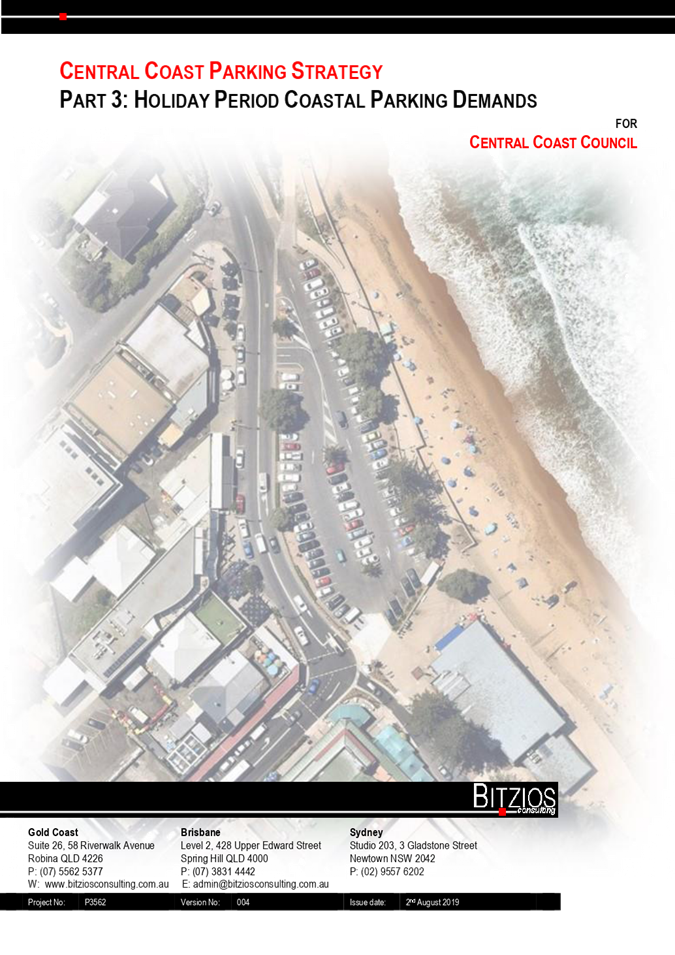








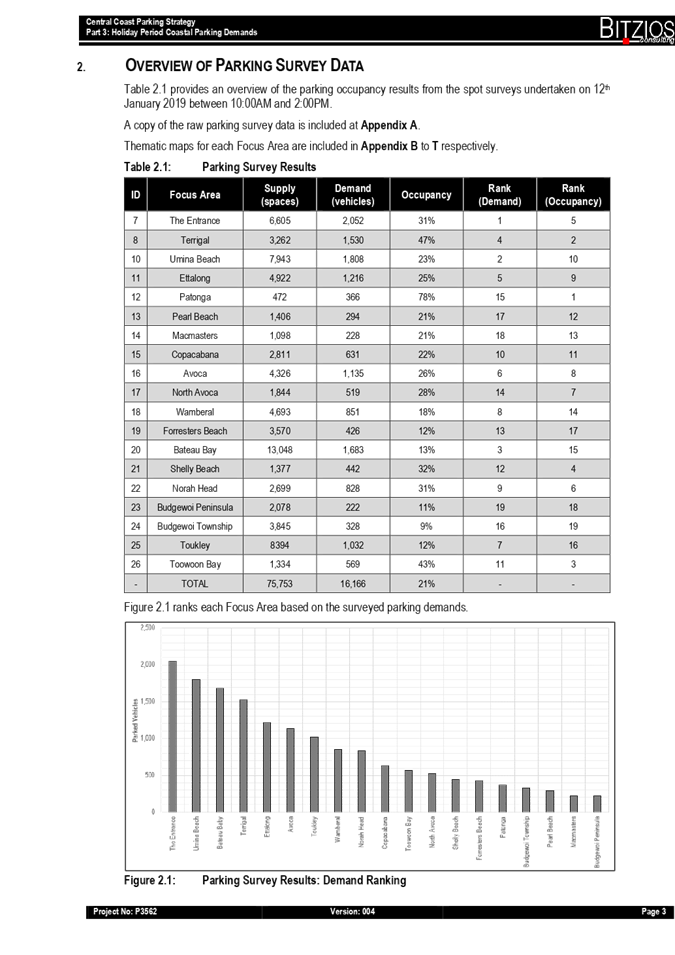
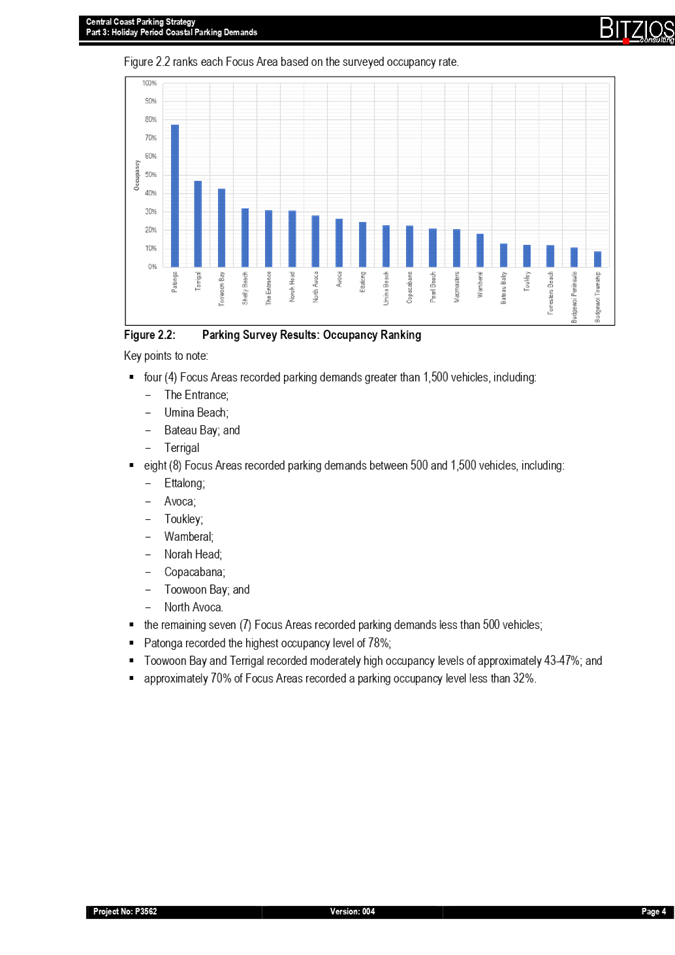

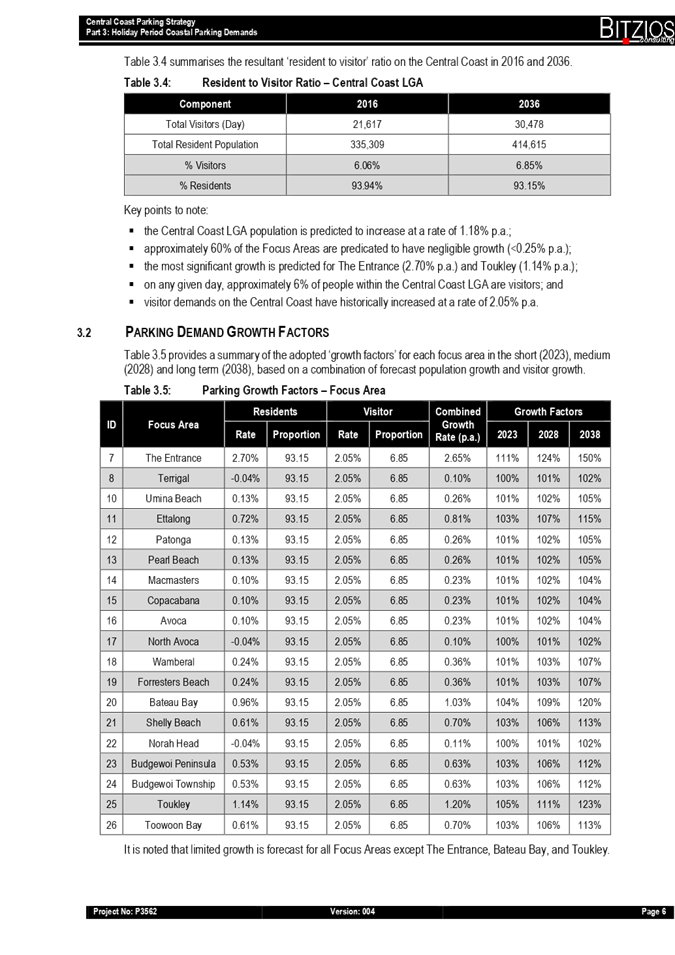
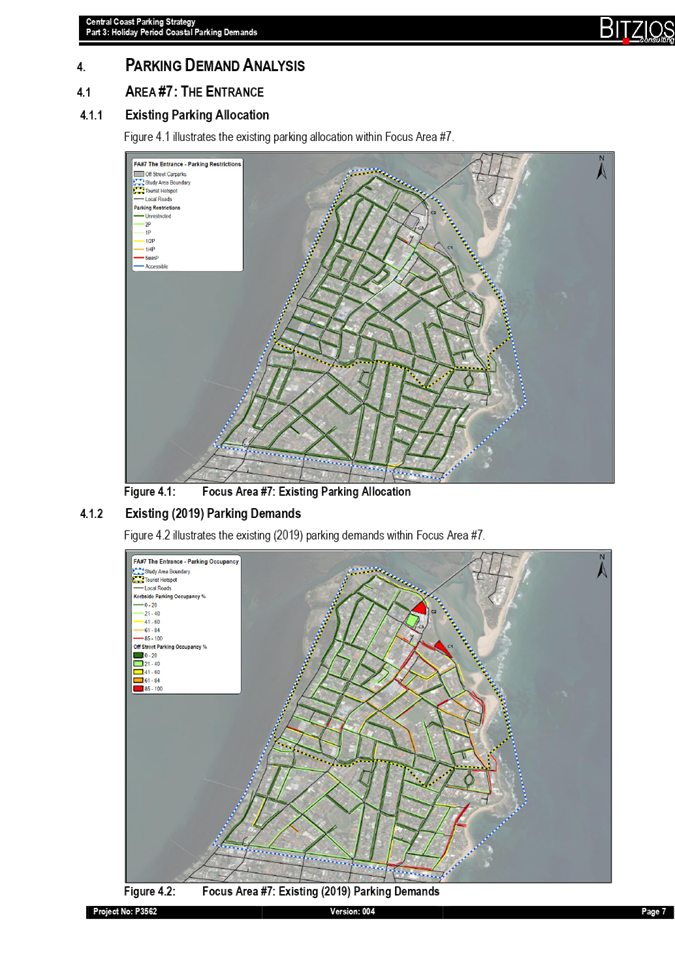
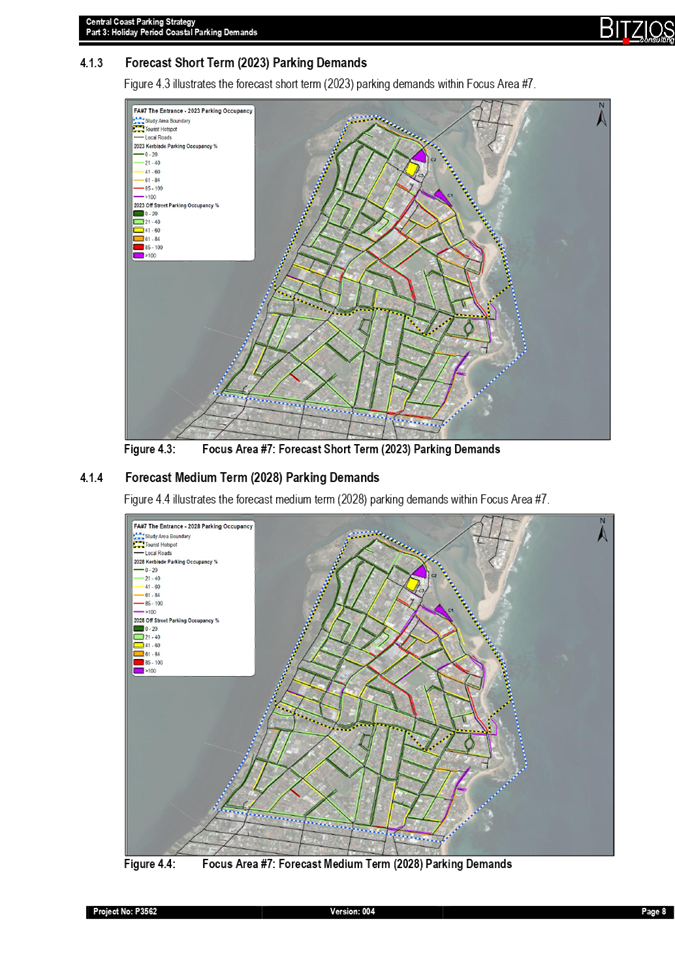
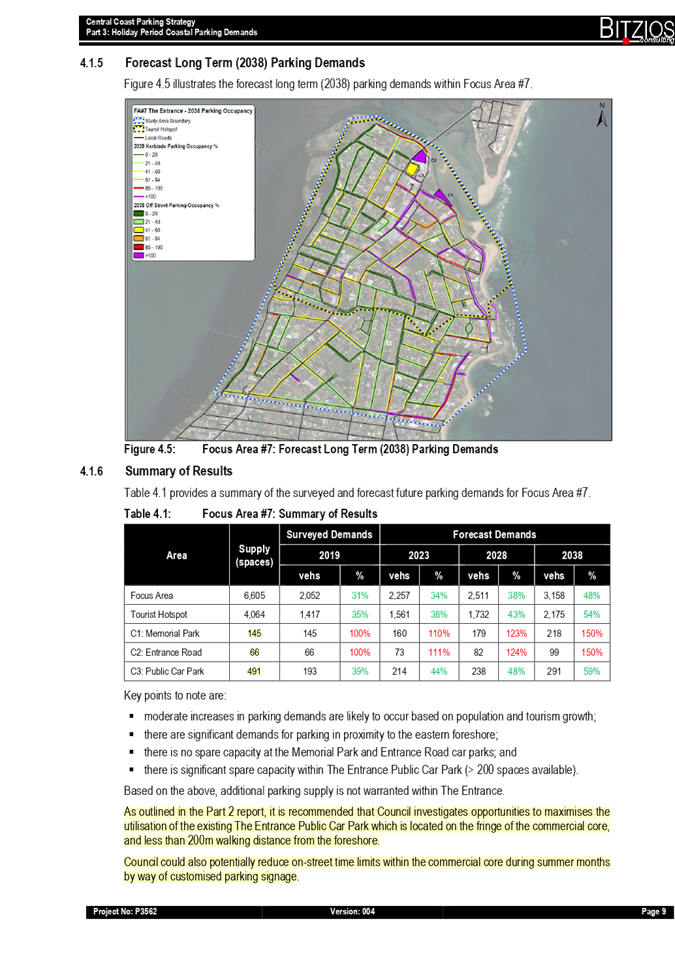
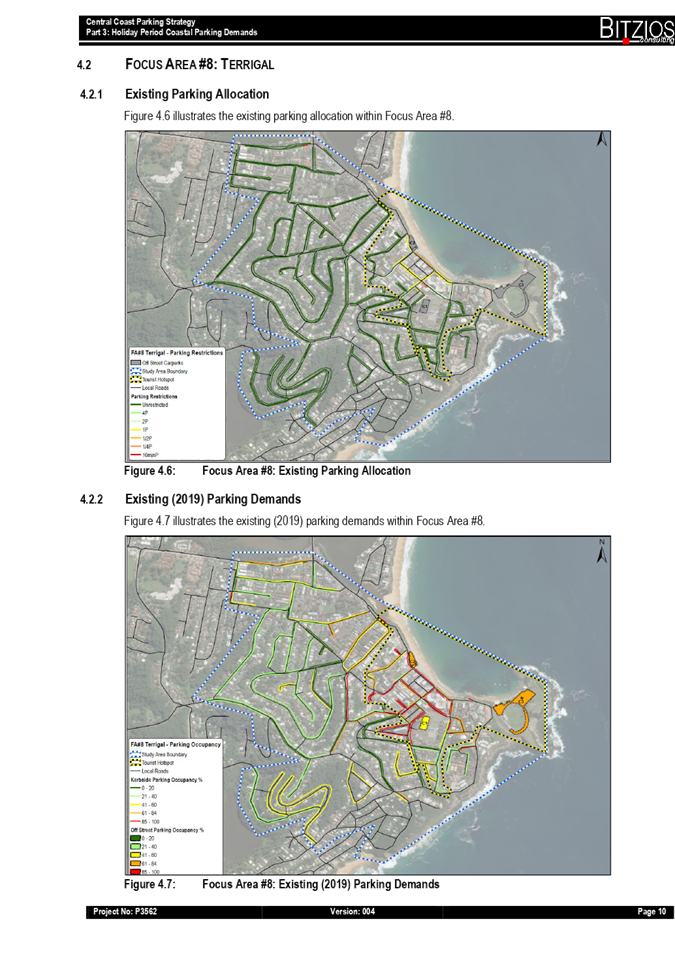
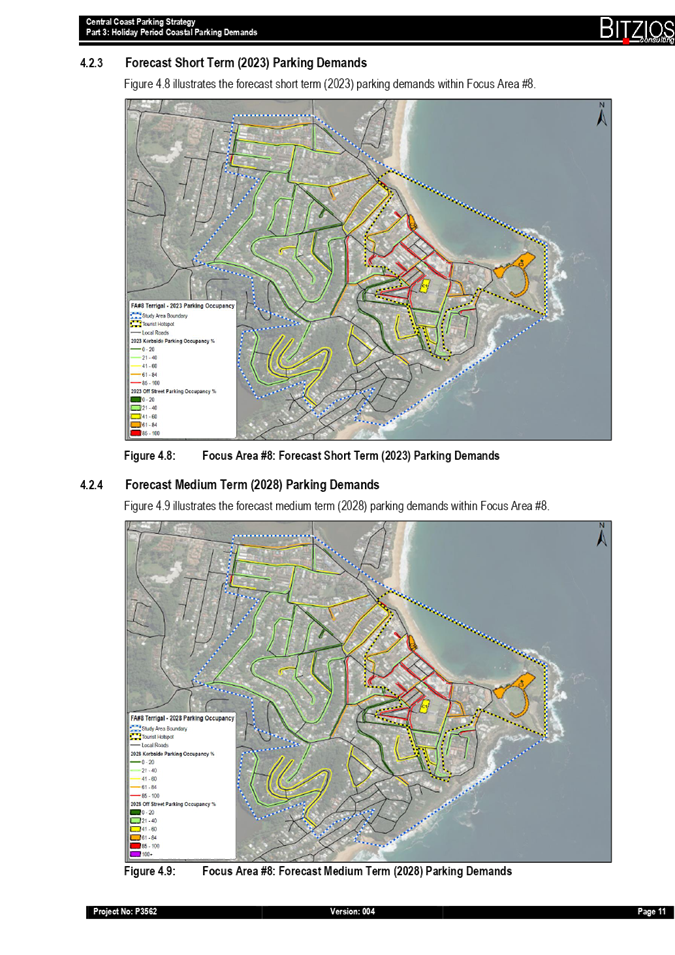

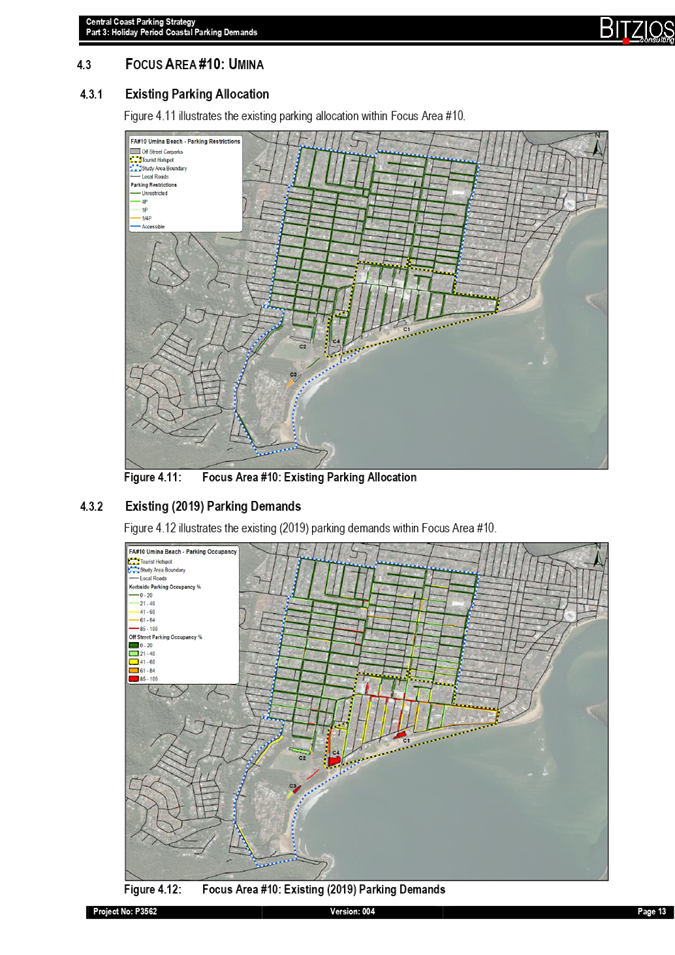
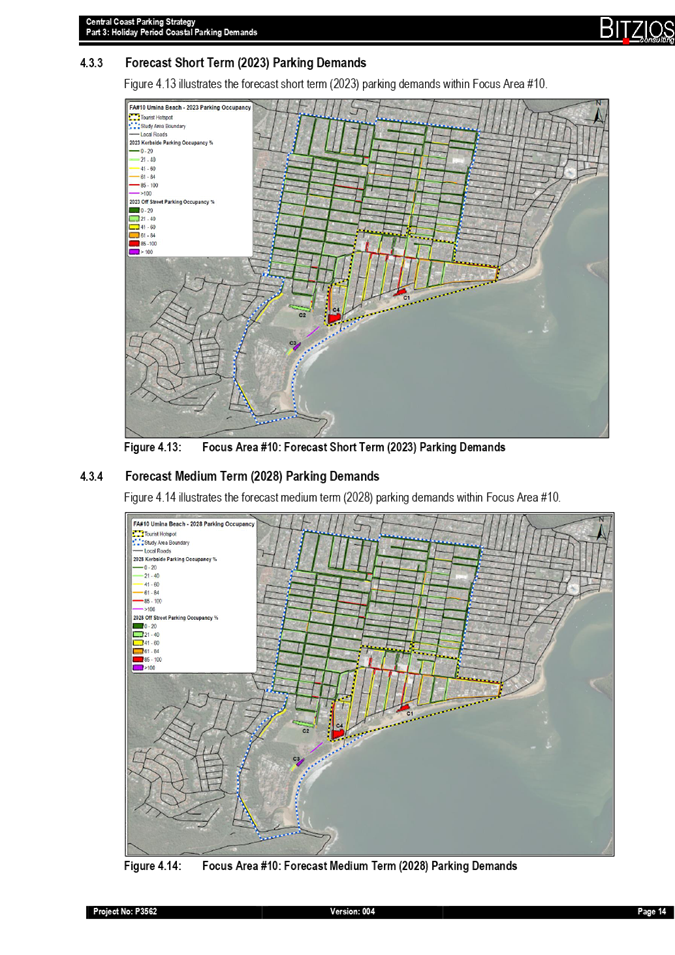

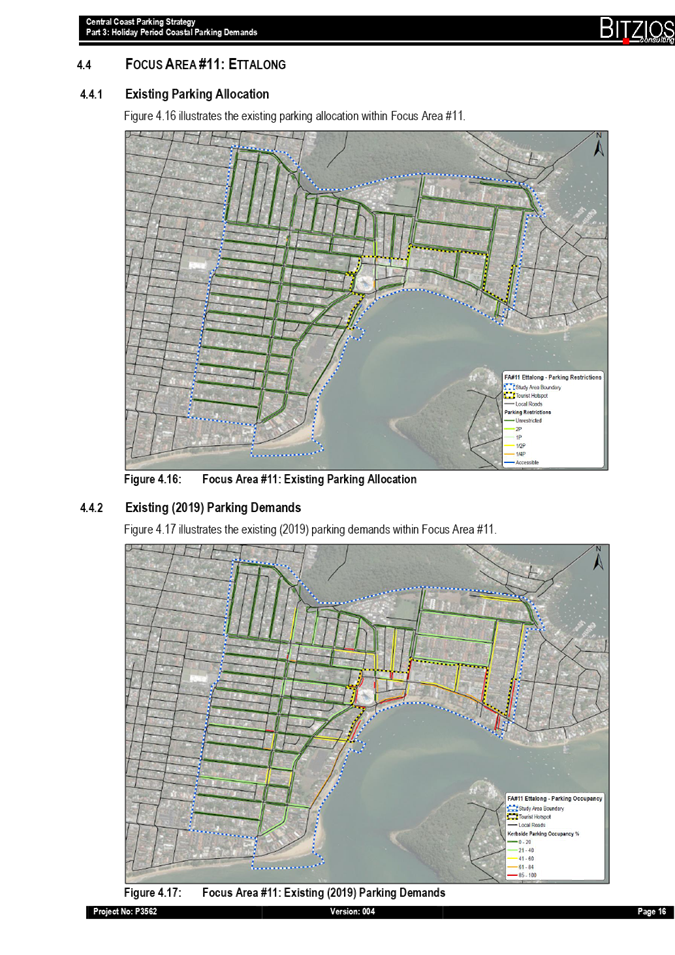

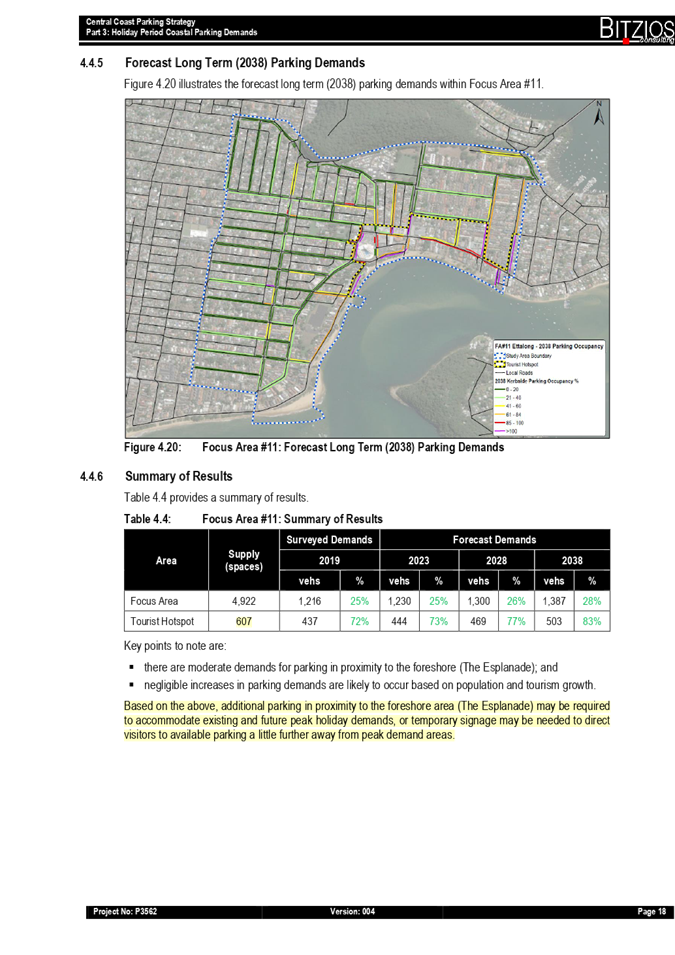

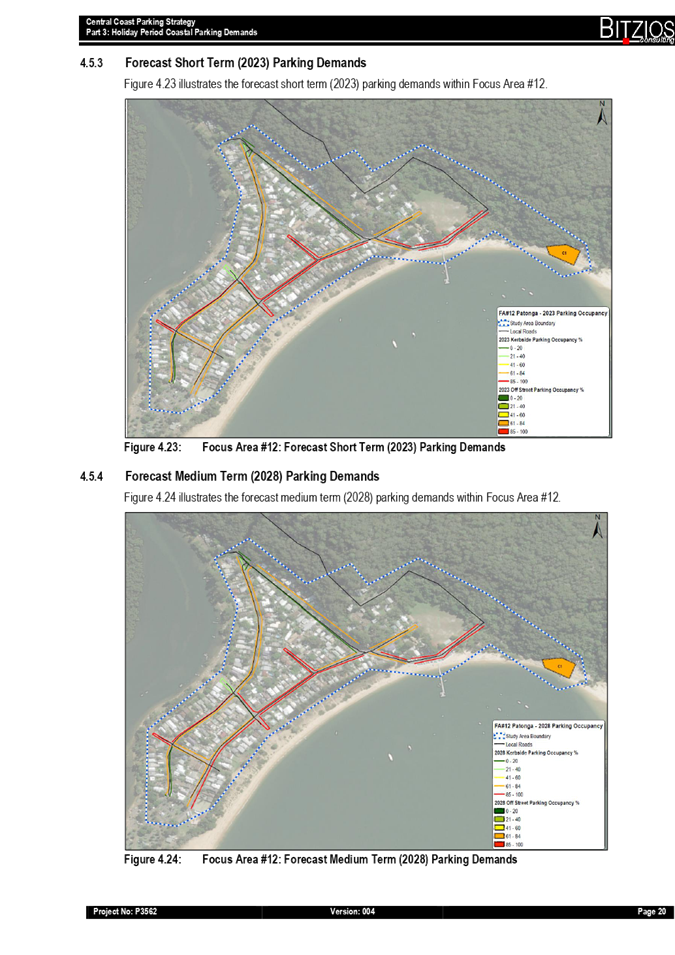

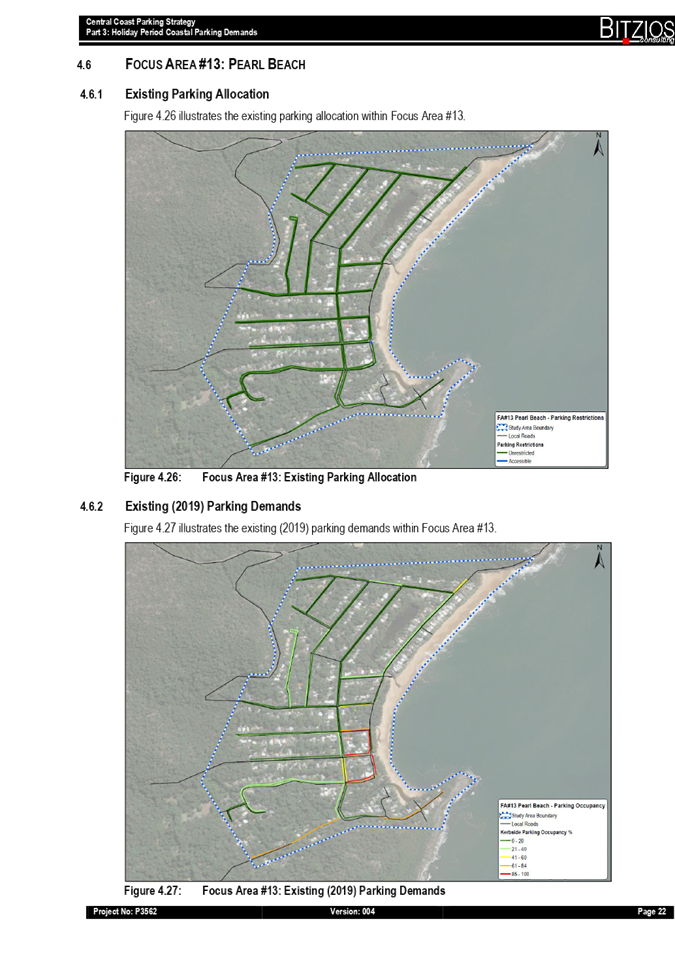
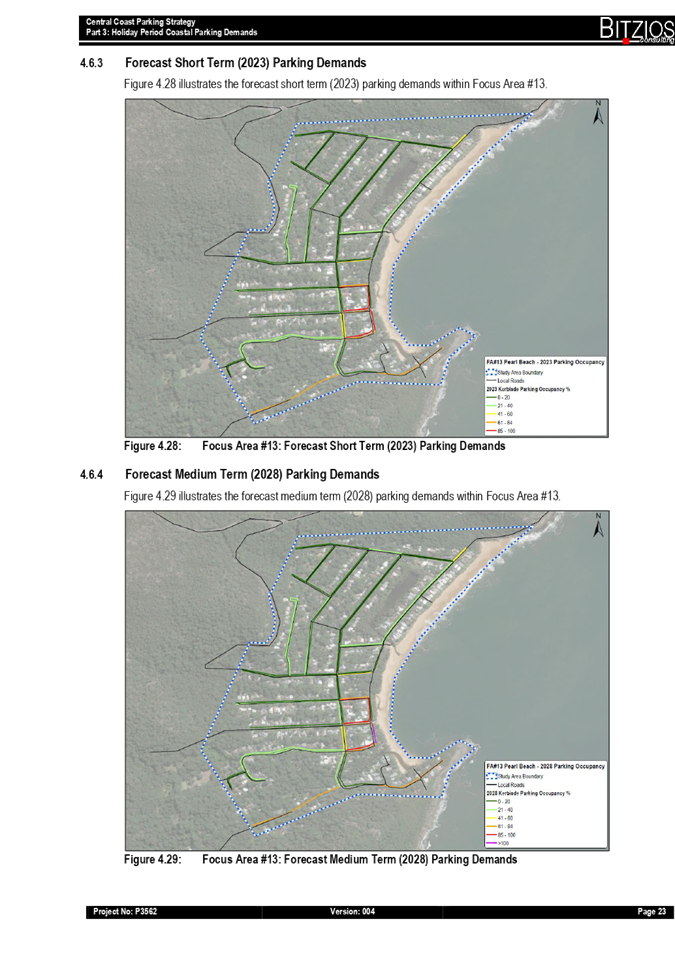
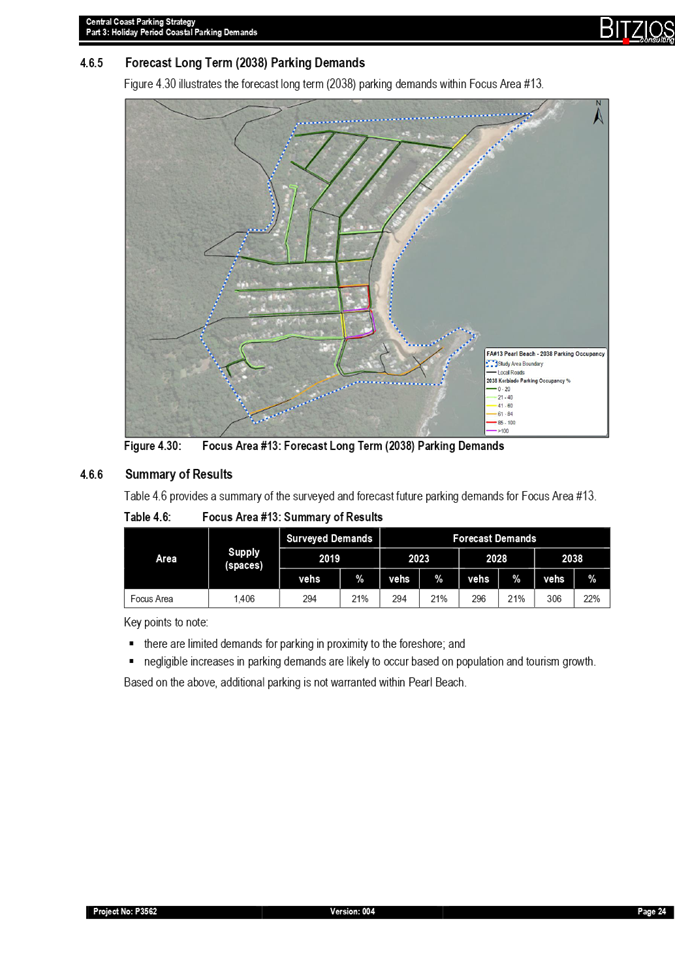
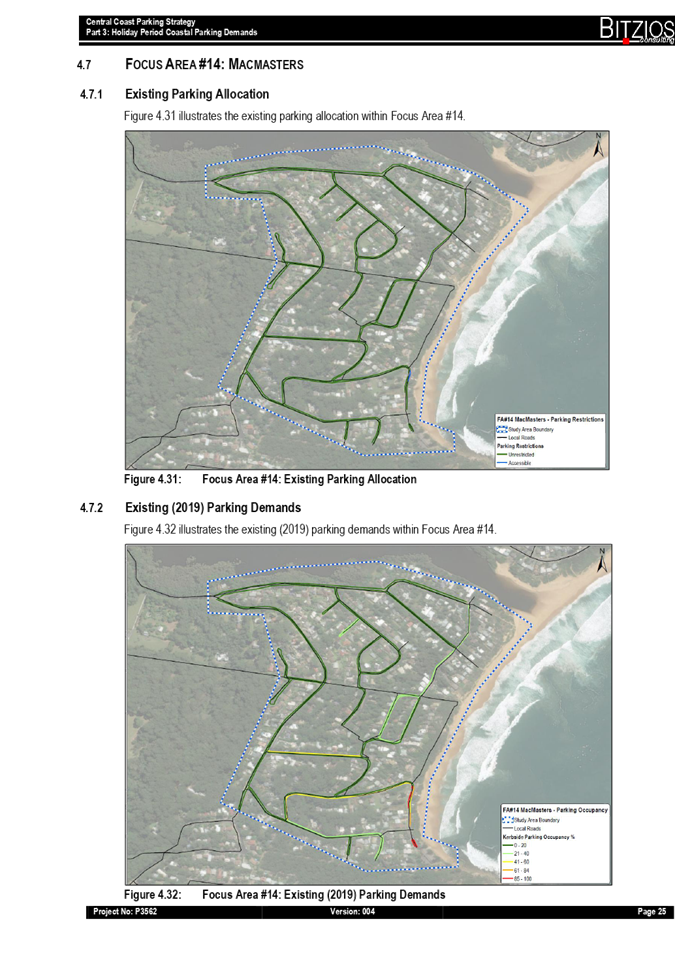
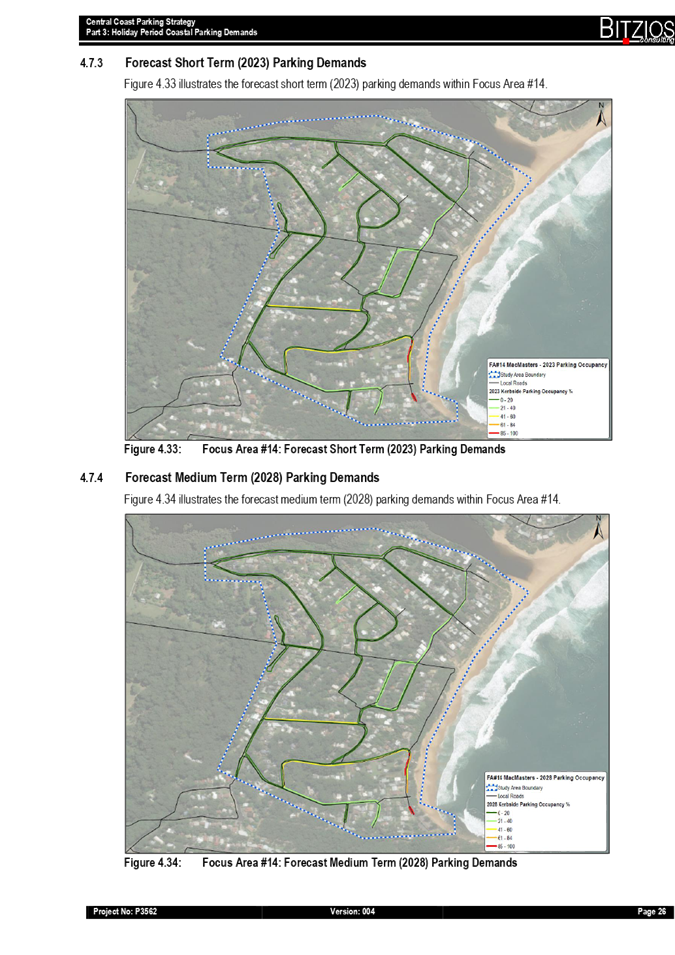


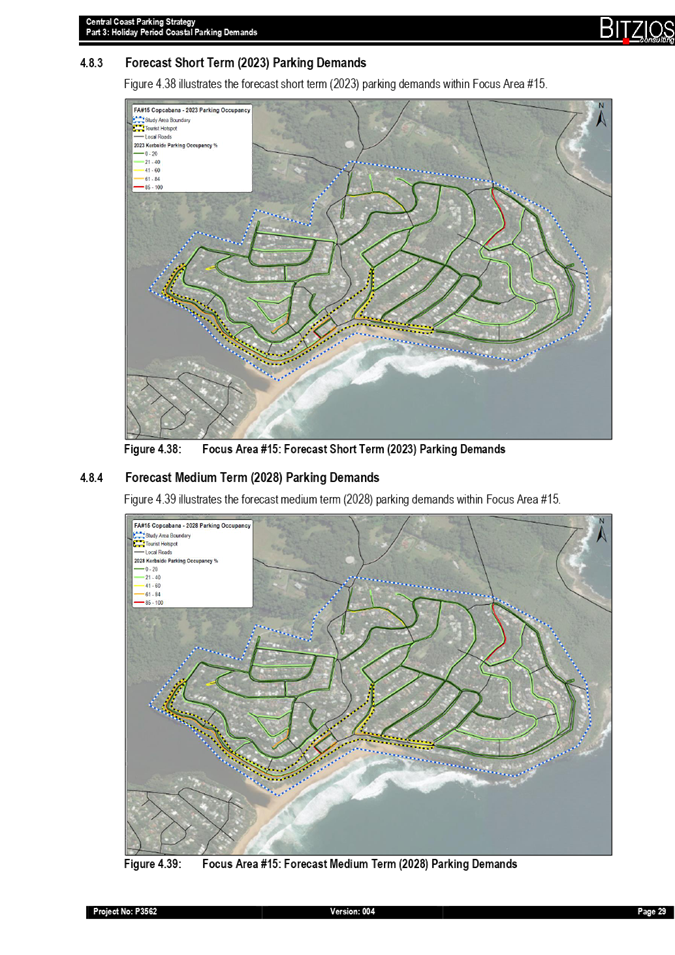
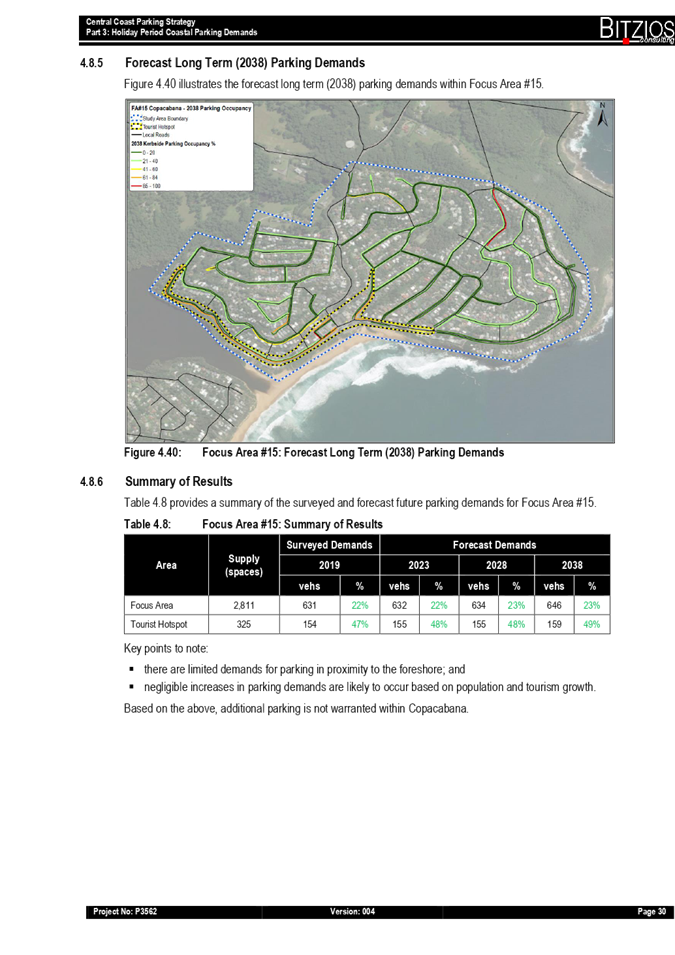
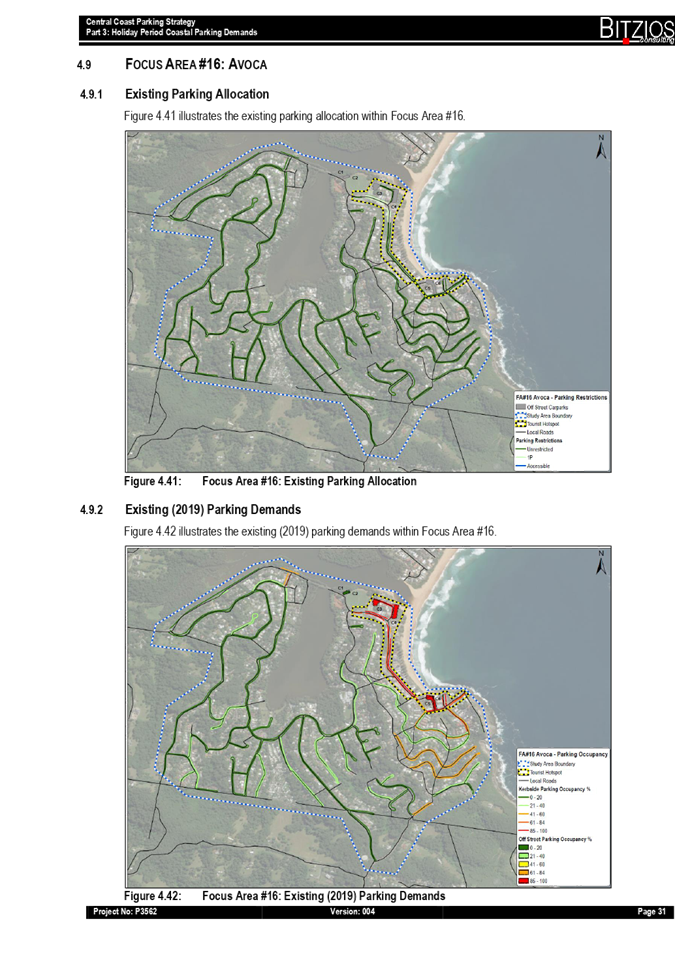
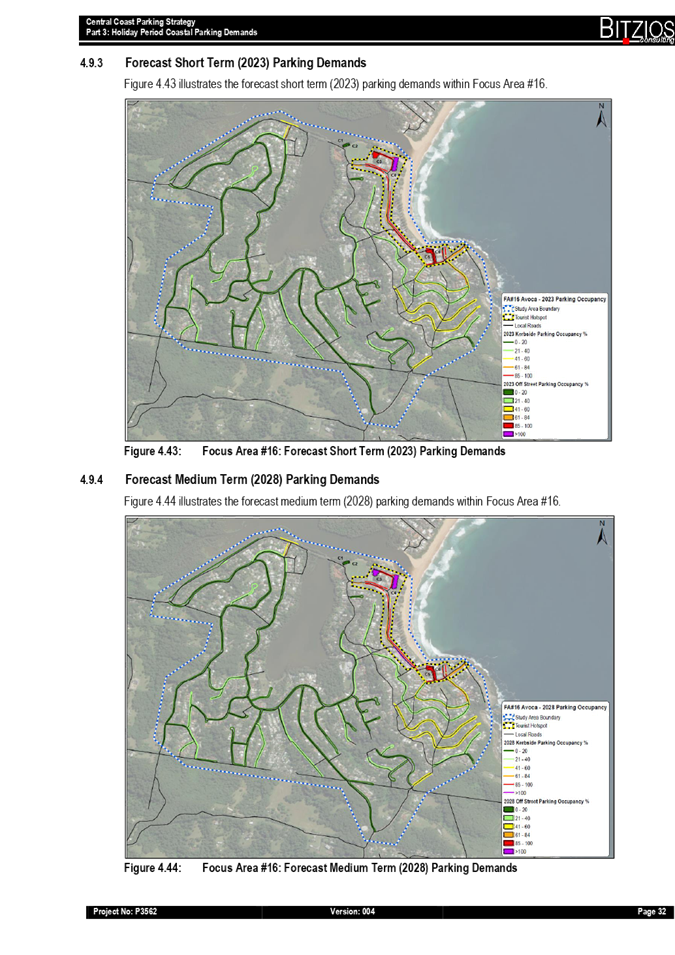
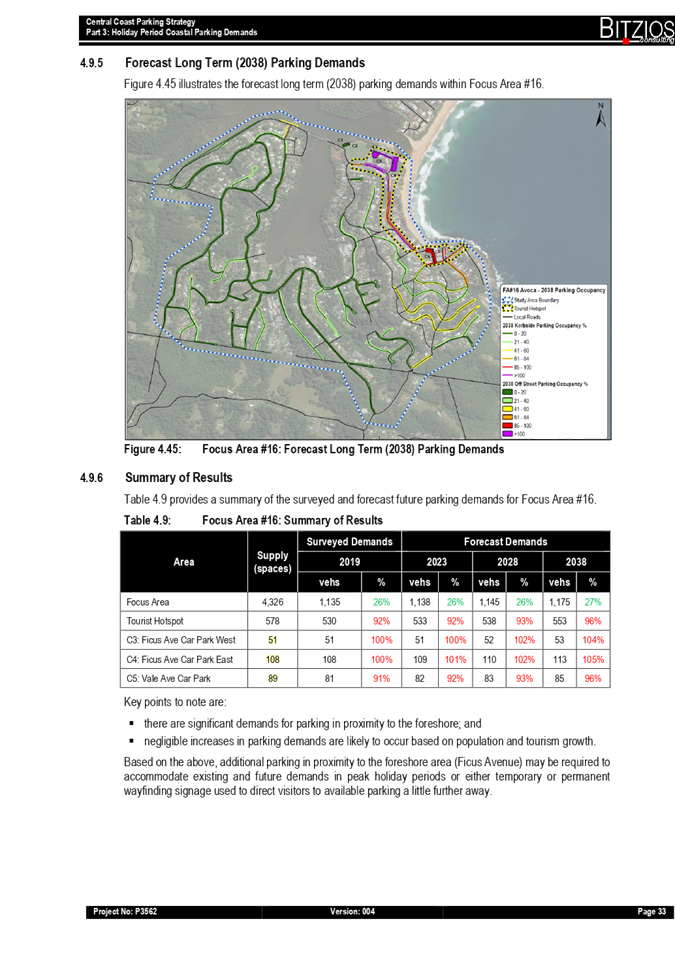
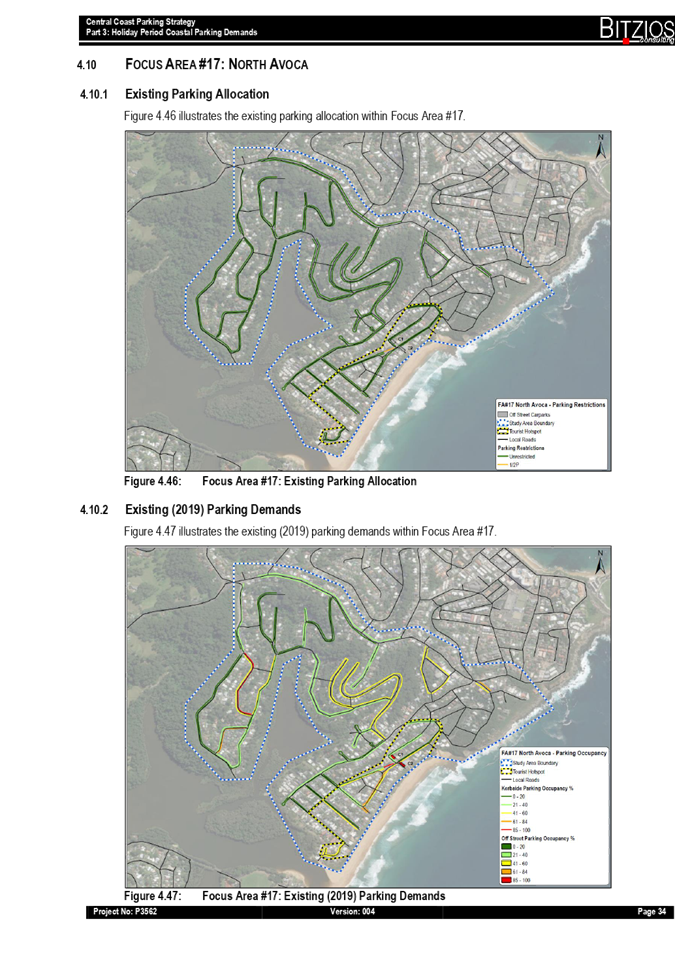

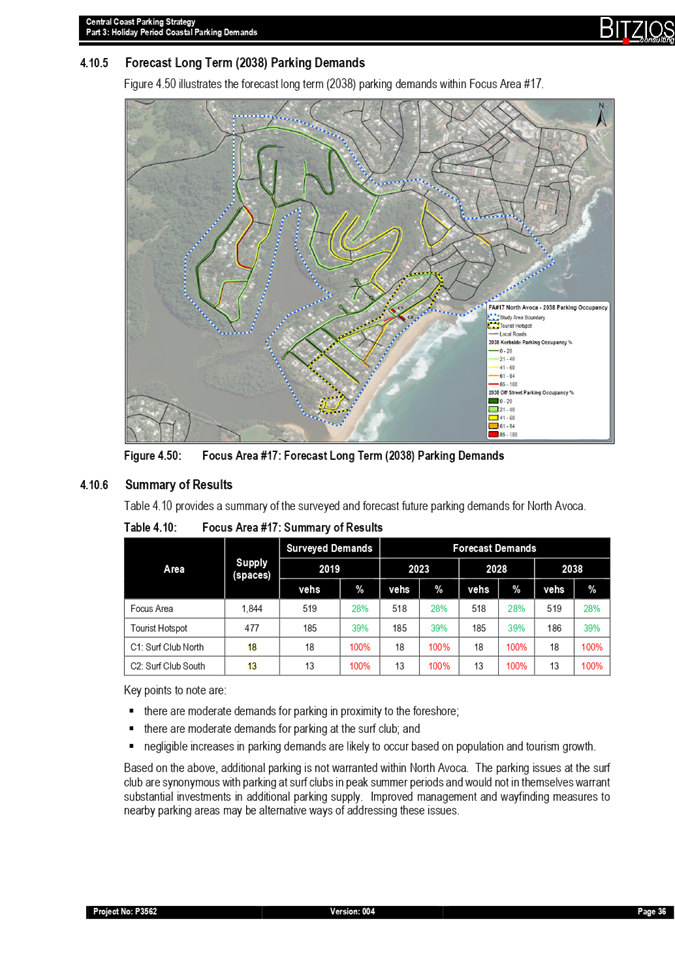
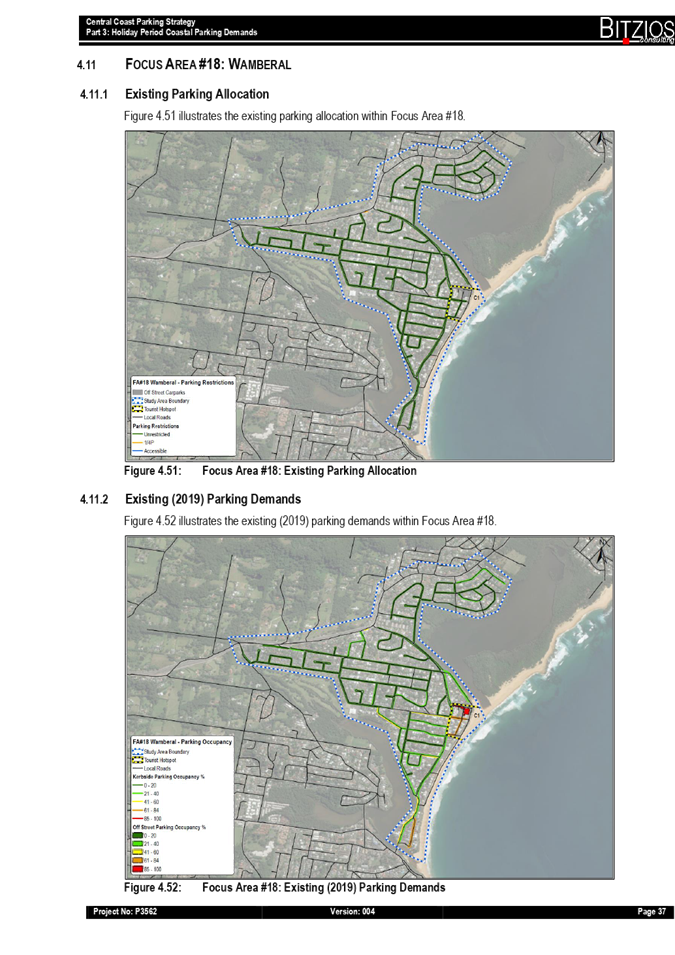
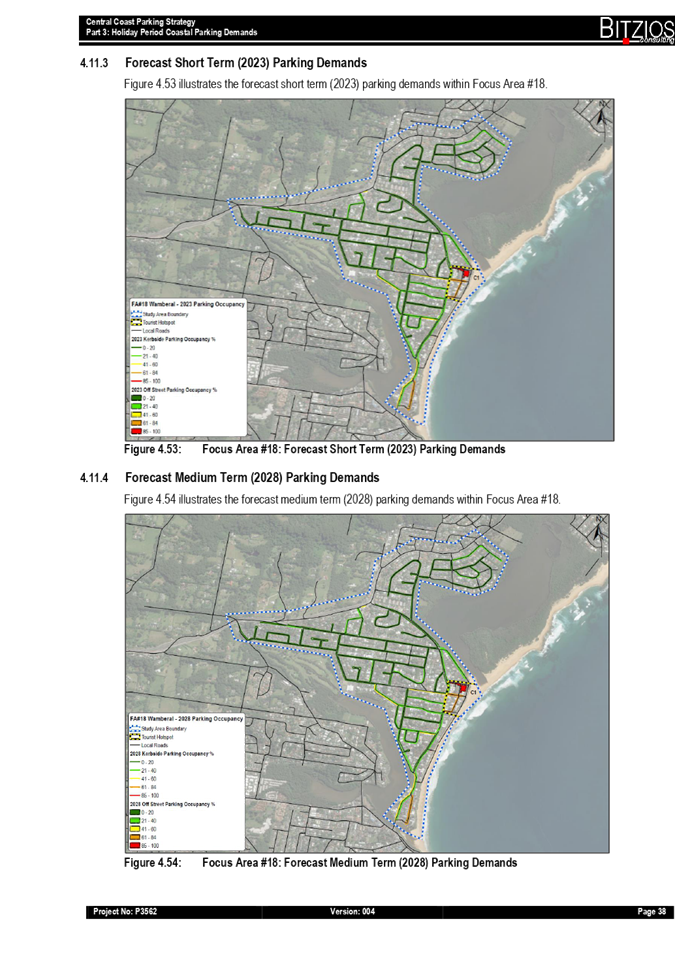
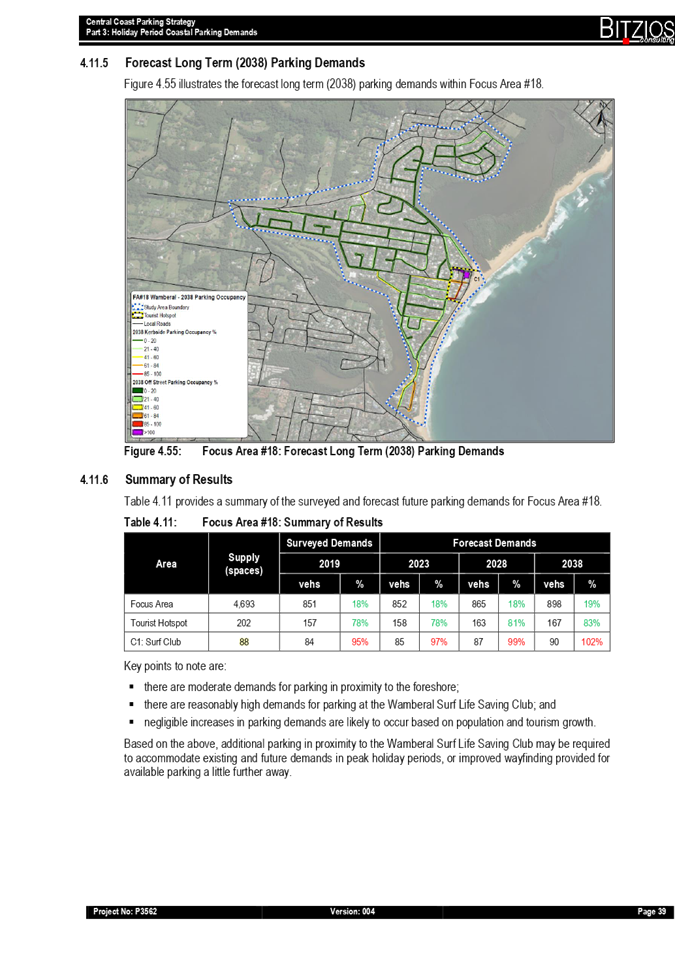

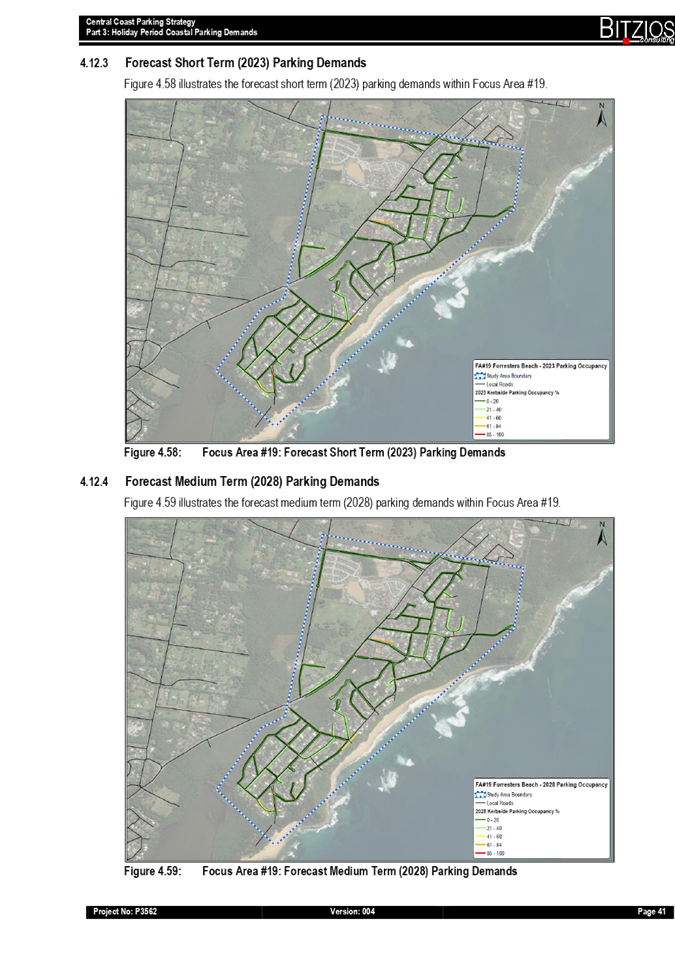
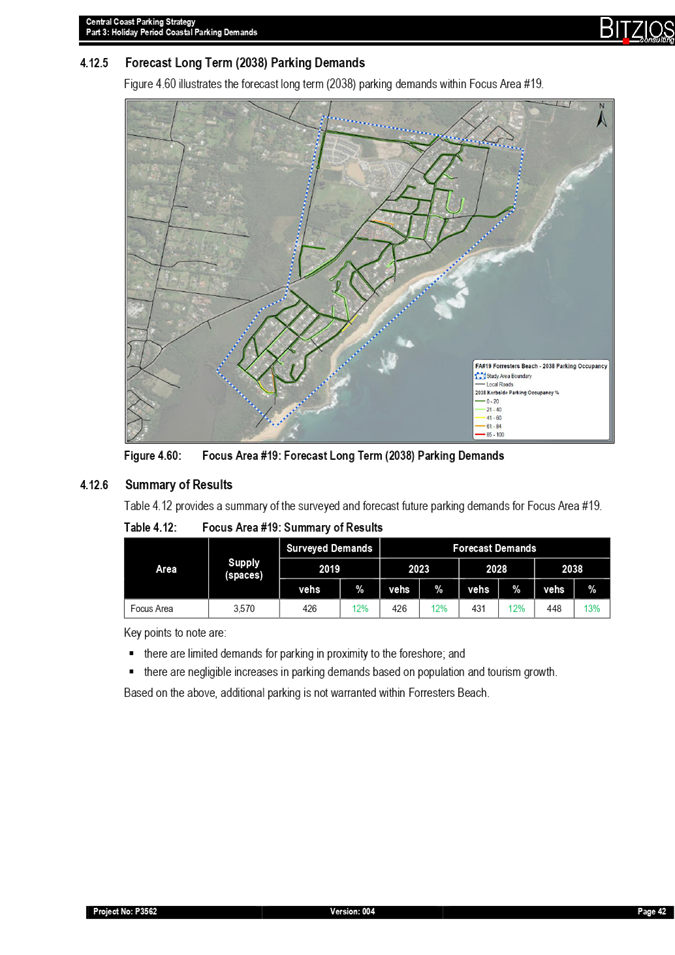
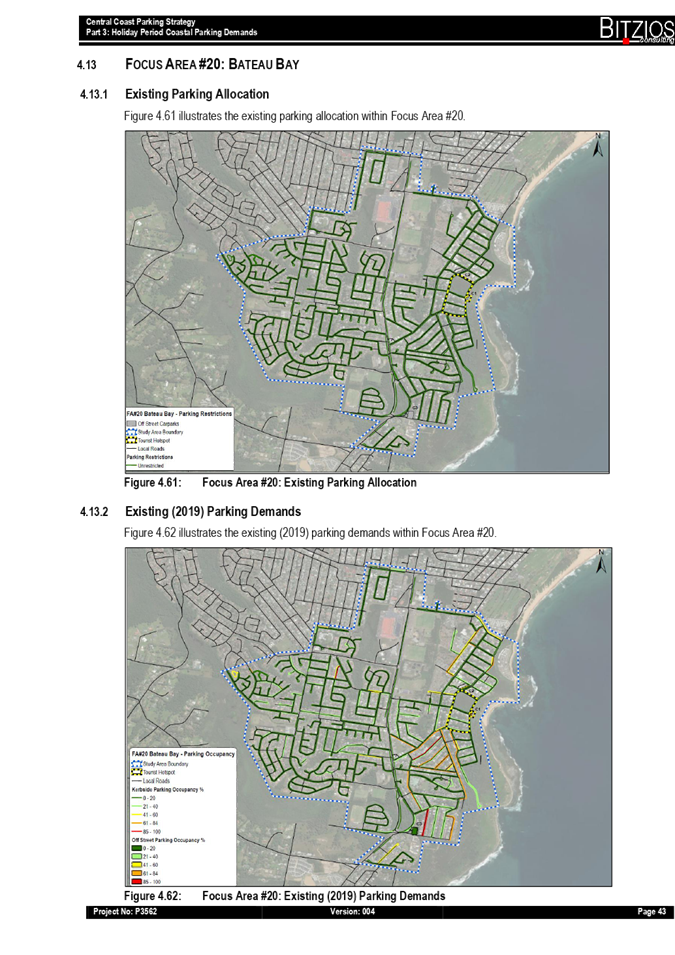
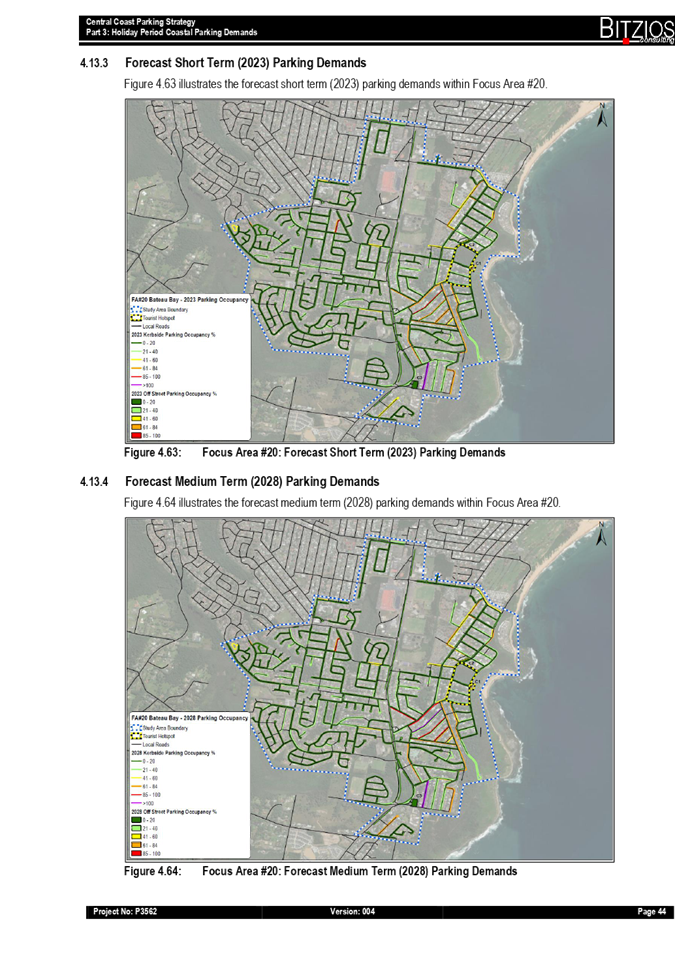
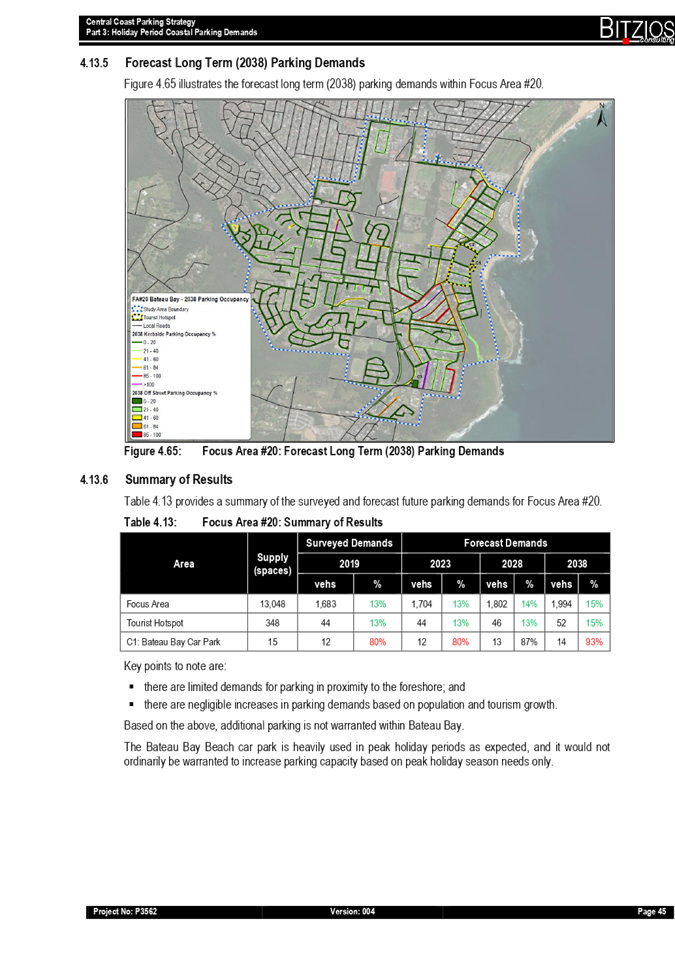
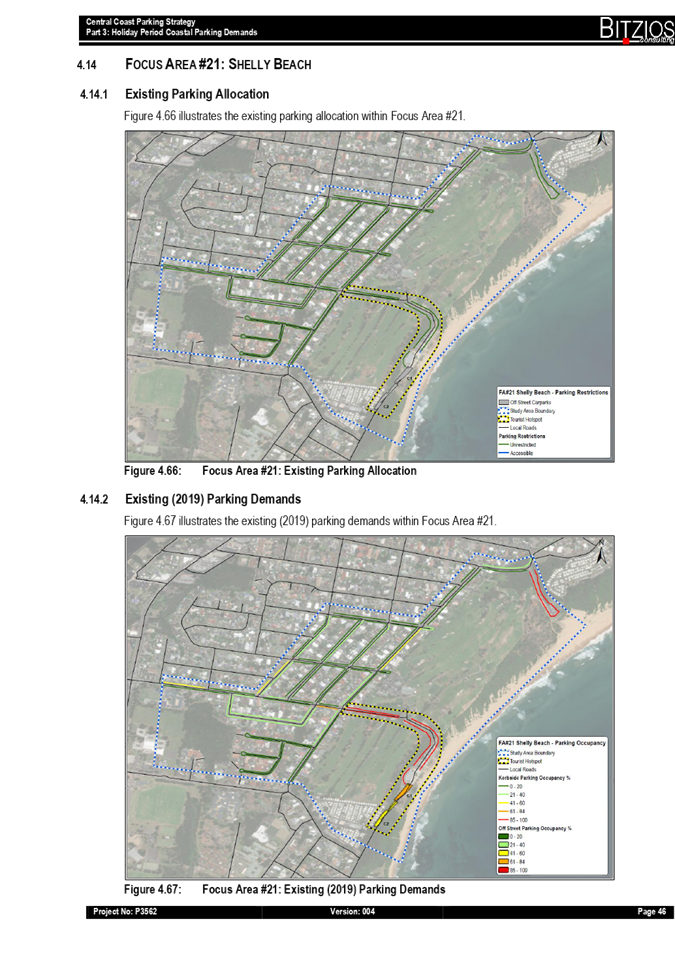
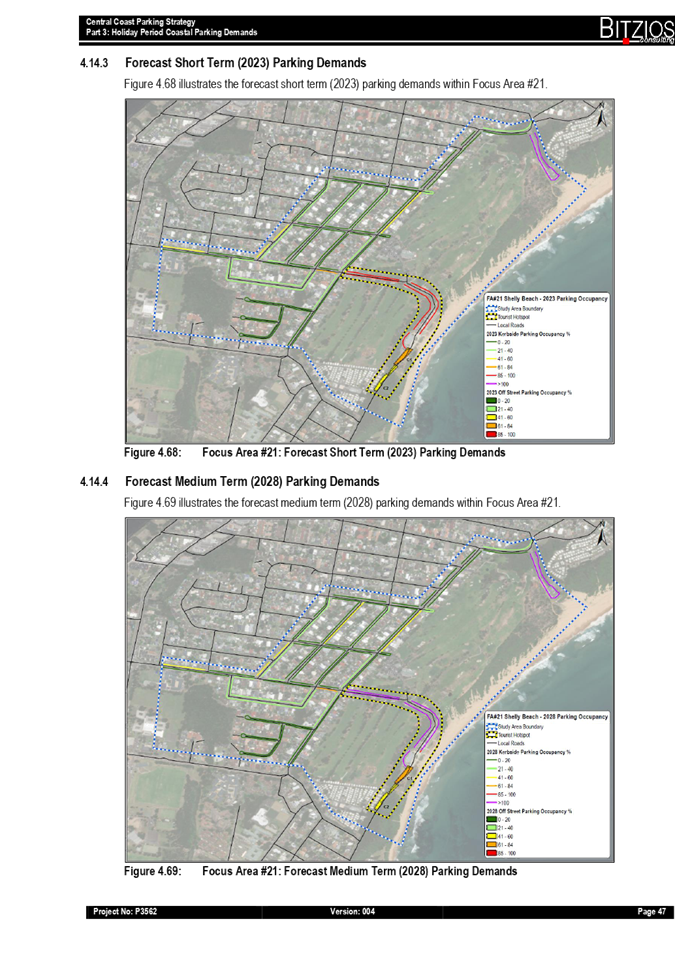
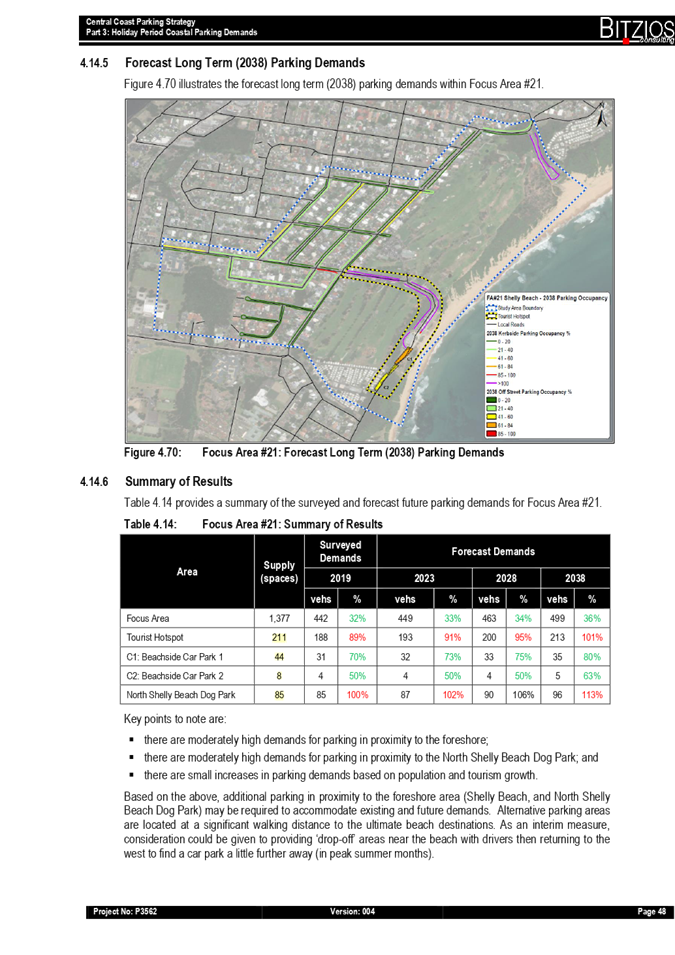
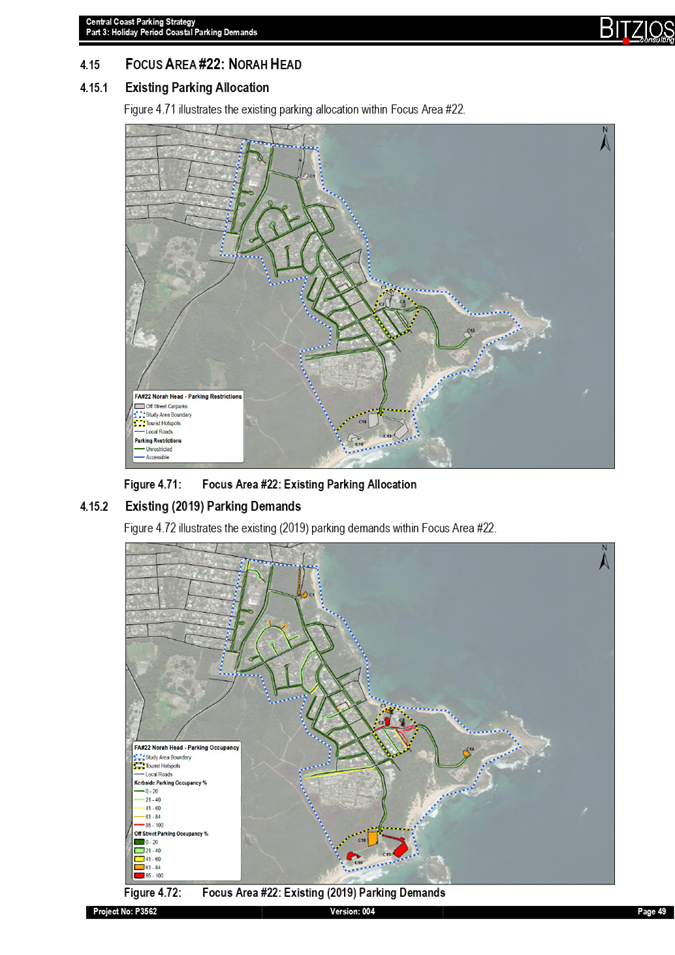

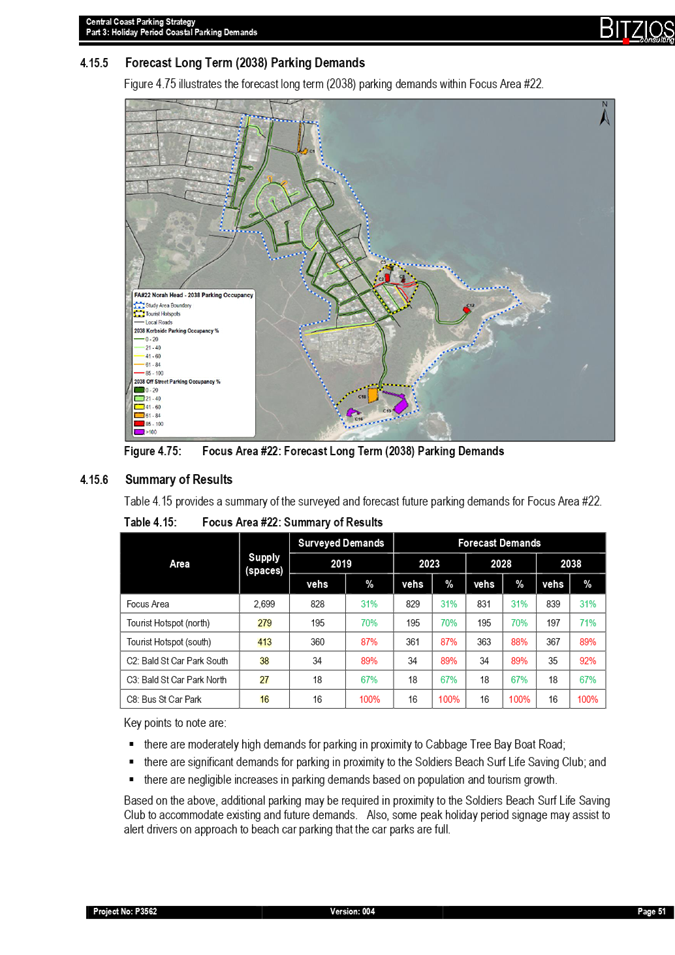
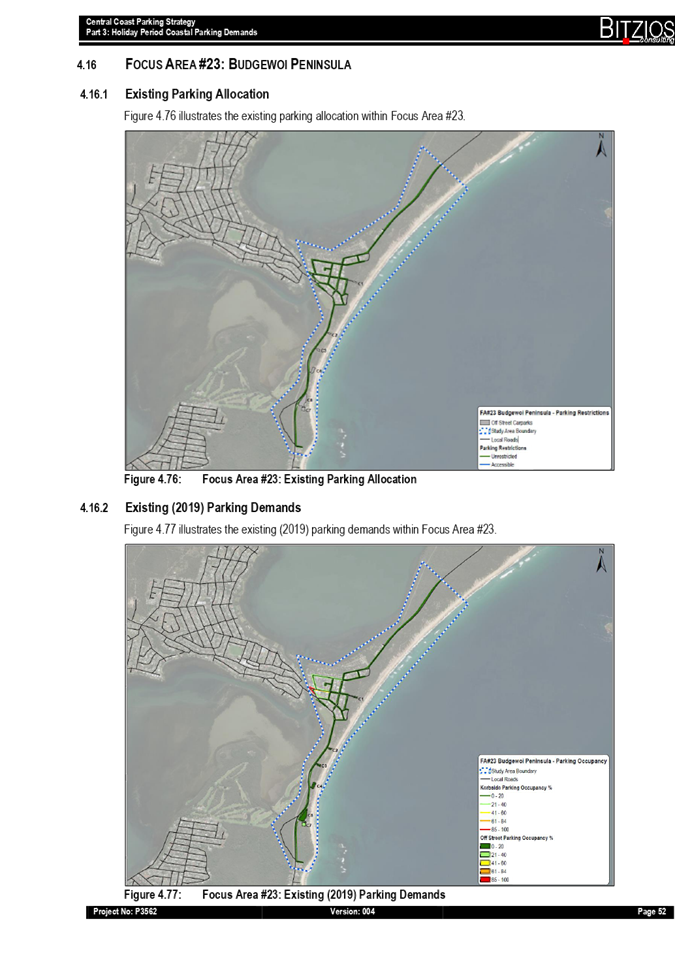
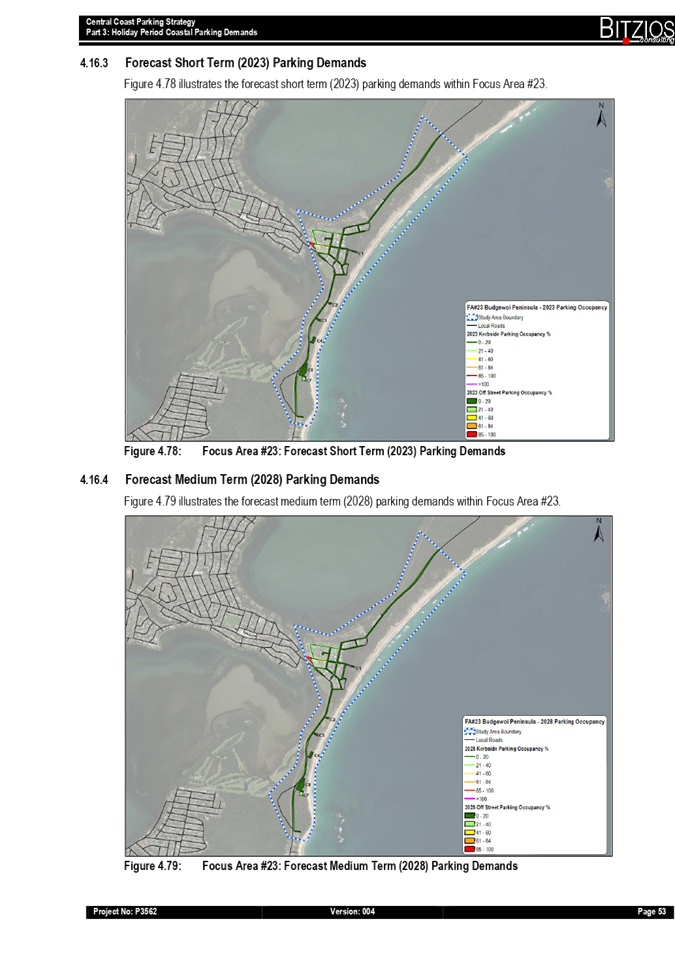
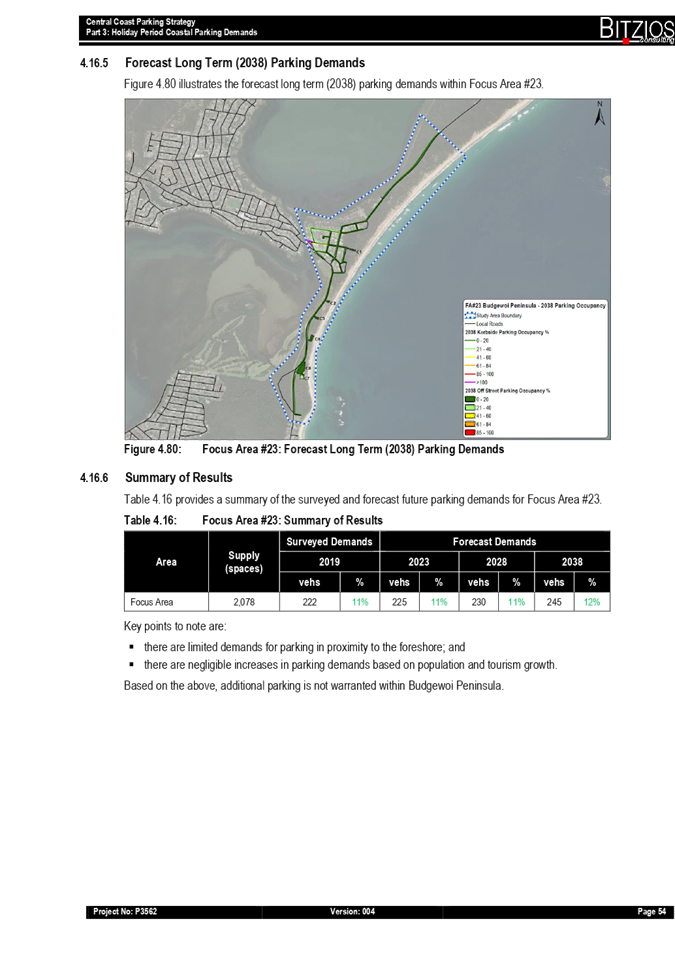
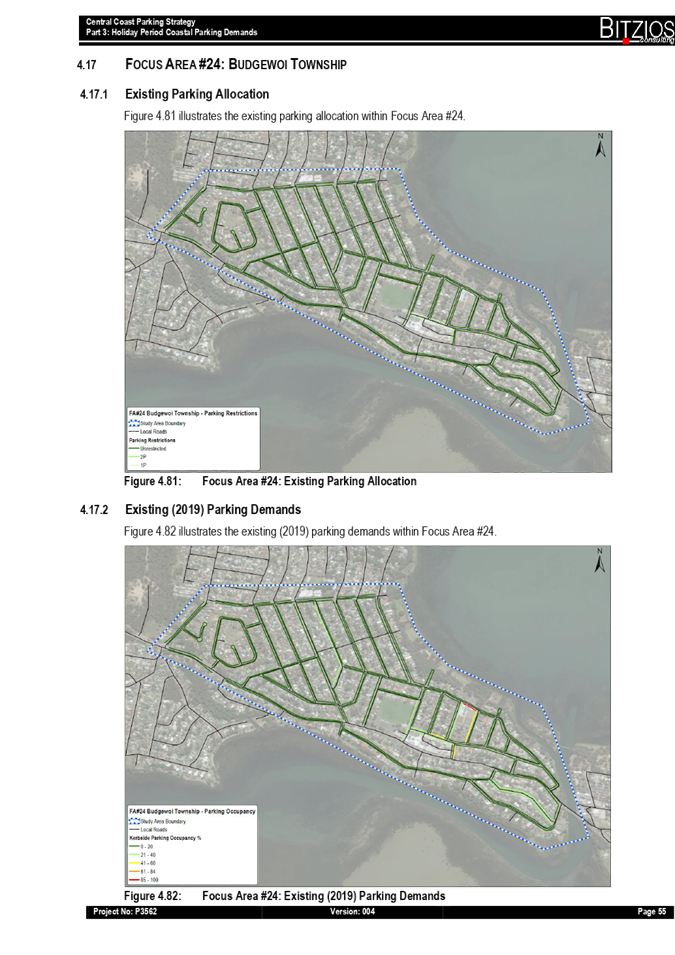
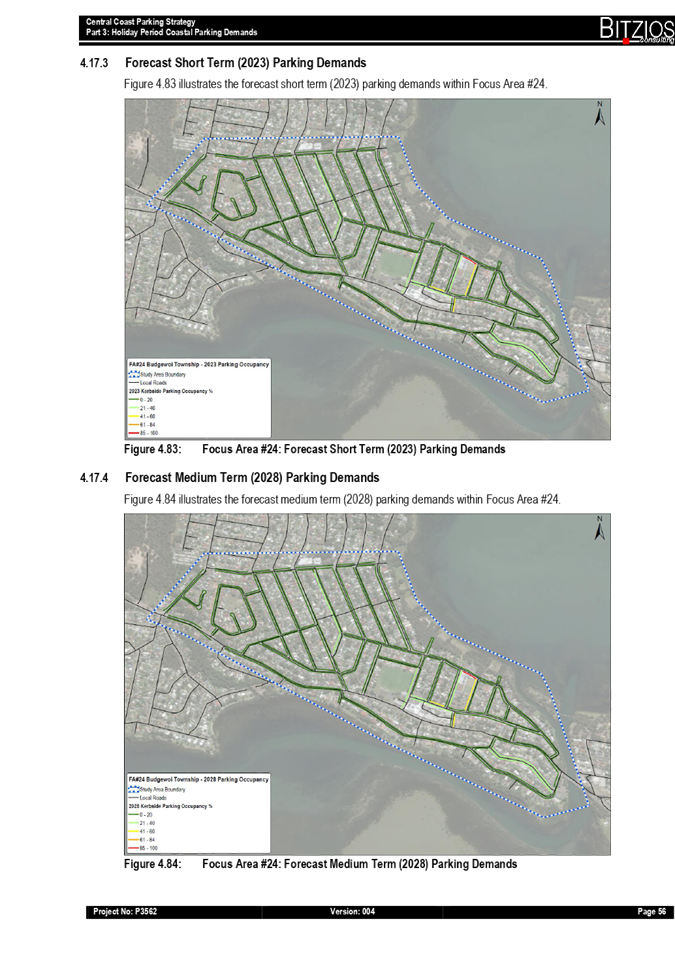
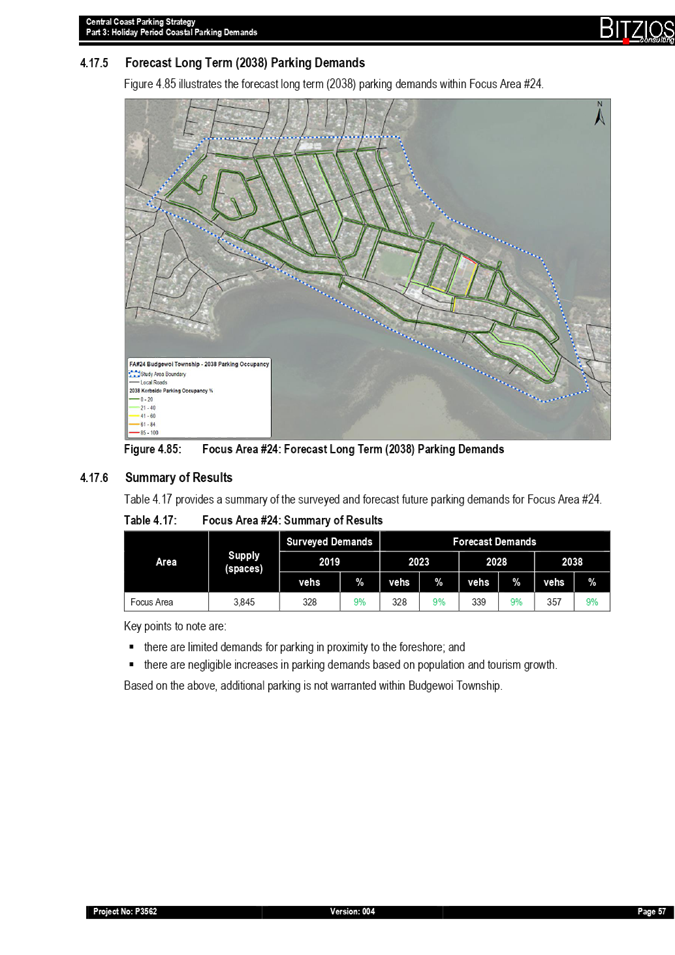
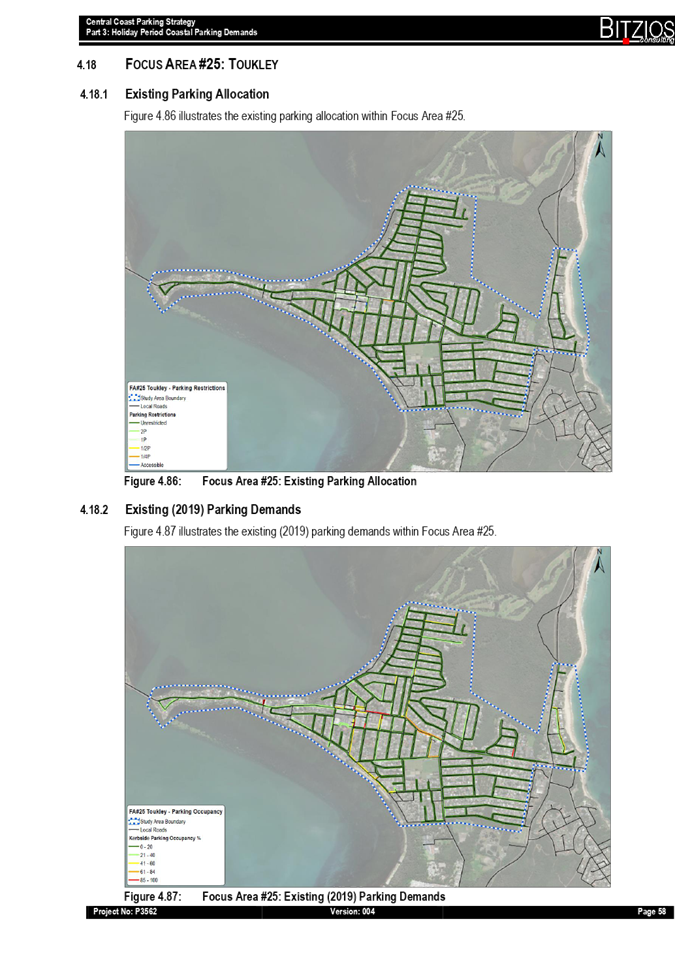
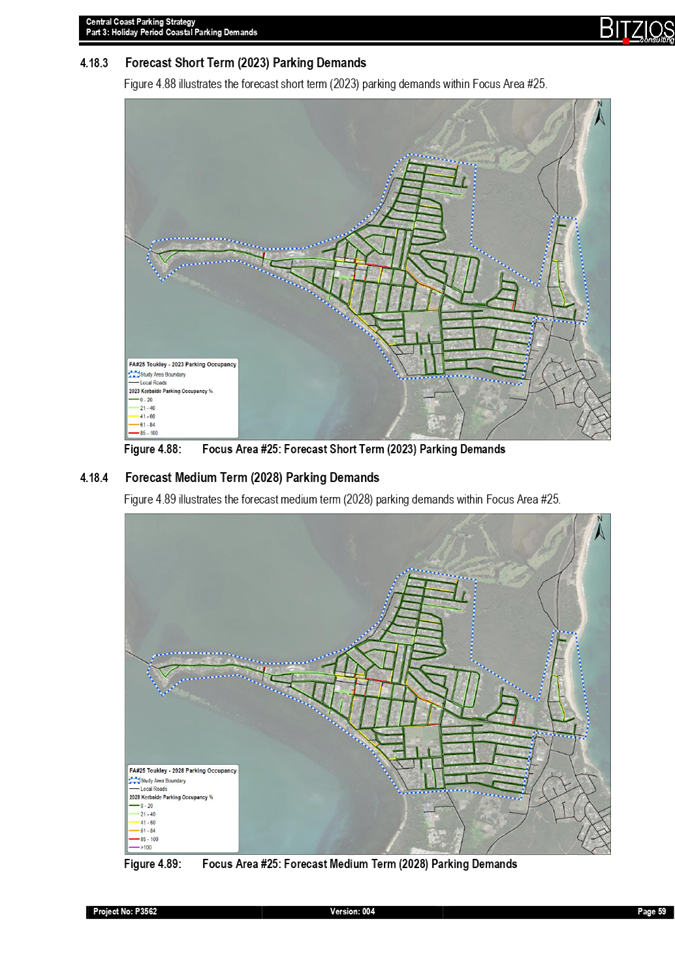

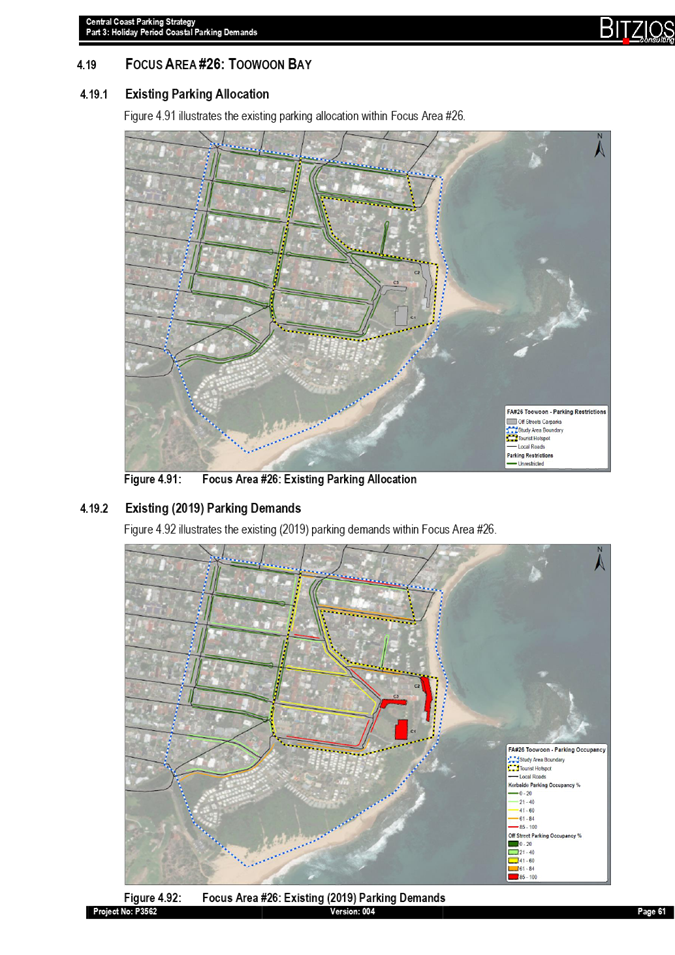
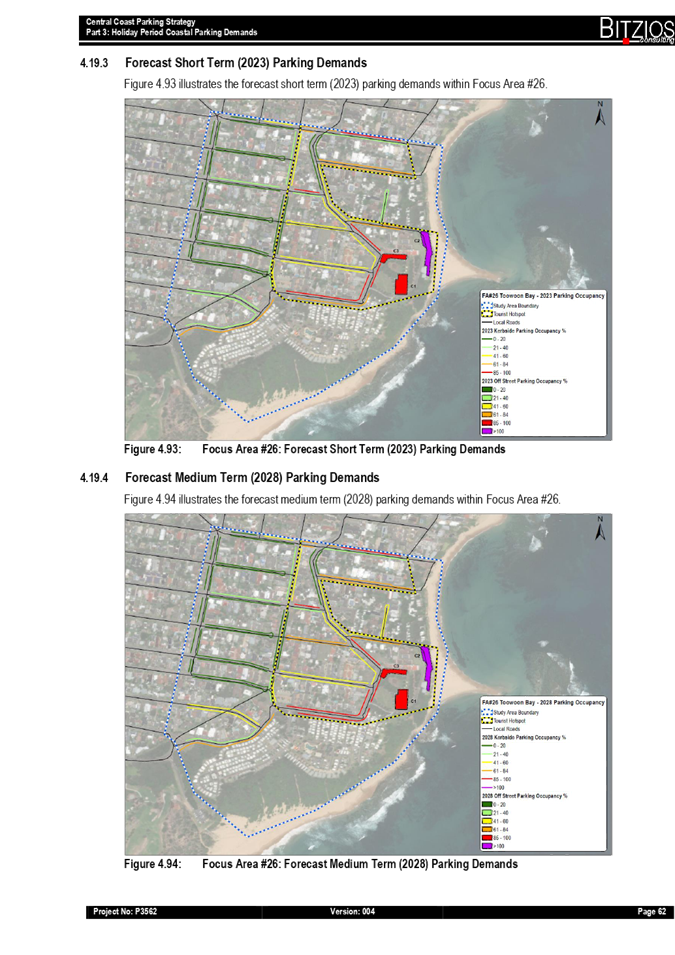
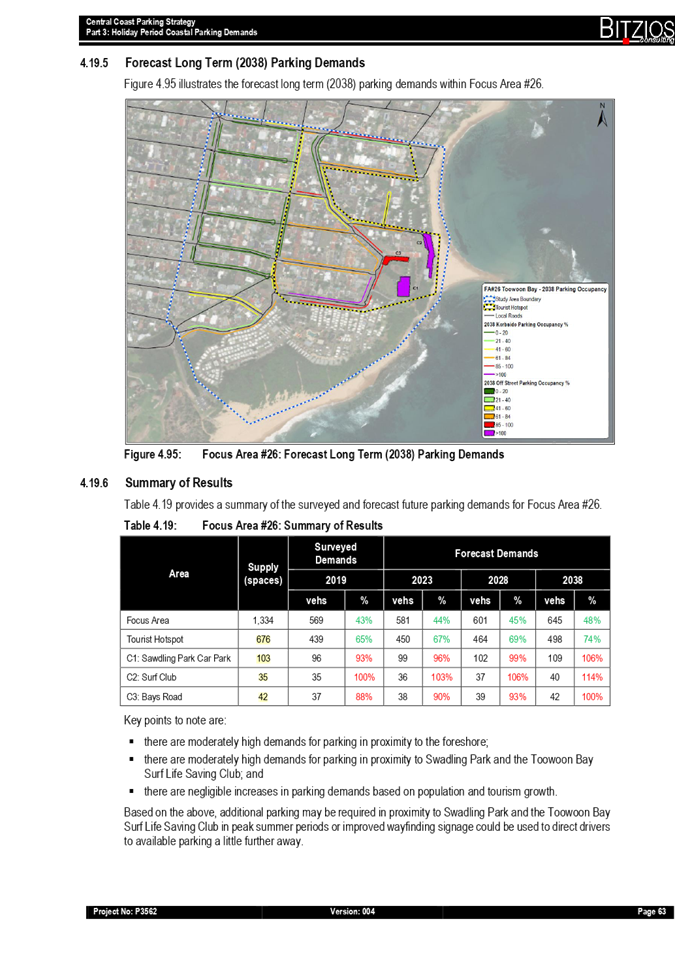
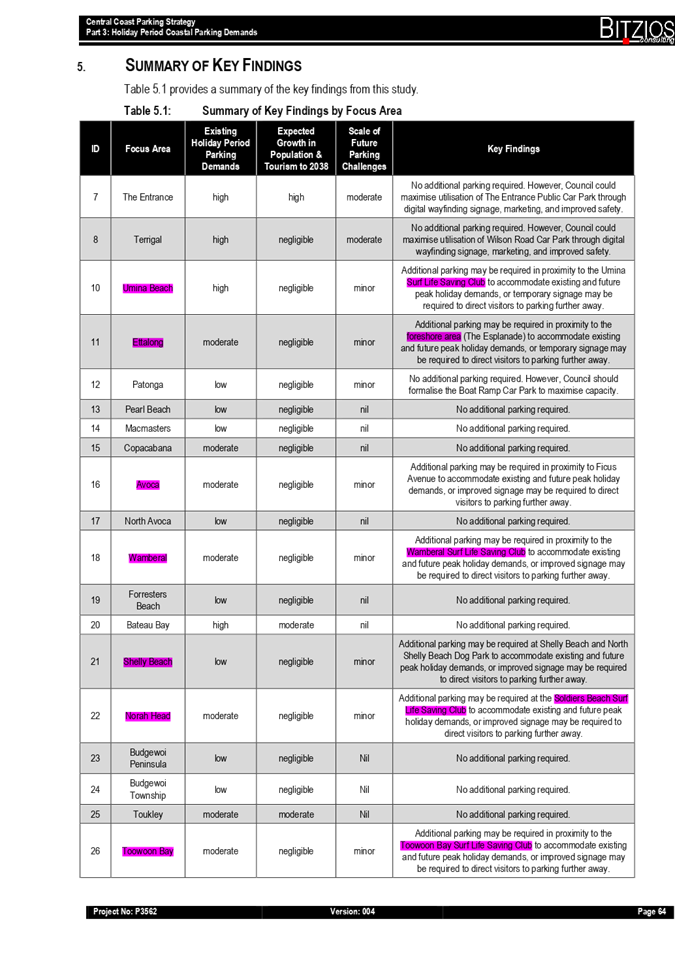
 Central
Coast Council
Central
Coast Council











































































































































































































































